- Pontoon Boats
- Personal Watercraft
- nauticalknowhow
- Nautical Knots
- Tools and Calculators

5 Best LiveAboard Sailboats – Plus 8 Important Buying Considerations
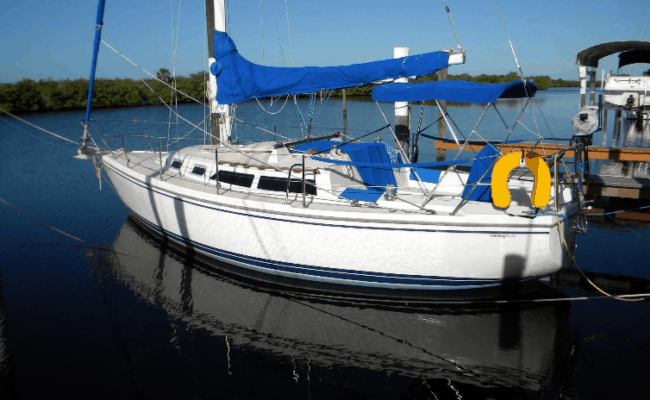
CATALINA 30
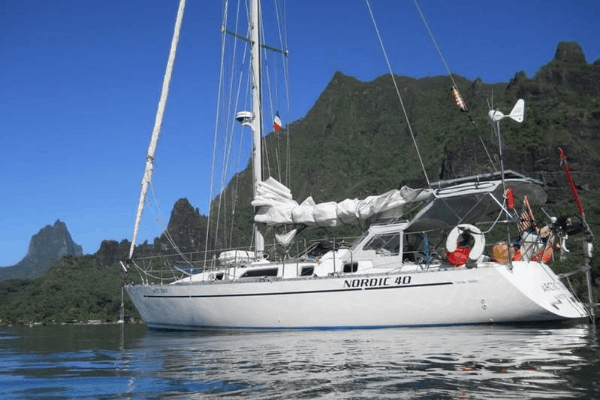
Taking the plunge to live on a sailboat is usually a huge decision, especially as living aboard a boat is an exciting lifestyle choice. However, there are lots of things to consider before buying a boat that will suit your needs and also be nearly as comfortable as a traditional home on land.
Whether this is your first time choosing a liveaboard sailboat, or you want to upgrade to a better option, you will find useful information in this article. But before we get into the best liveaboard sailboats and how to choose one, let’s see why living aboard a boat is a great lifestyle choice.
We’ve reviewed some of the best liveaboard sailboats and listed them here to help you choose one that will suit you most.
5 Best LiveAboard Sailboats
Islander 36.
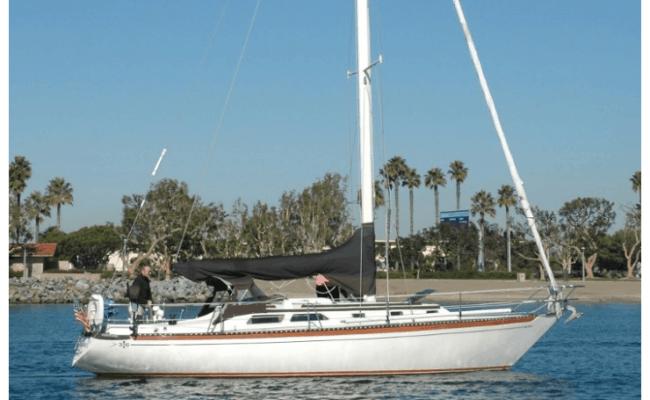
The Islander 36 is the boat for you if you want a well-rounded sailboat with impressive cruising abilities. With close to a thousand of these boats built between 1973 and 1986, the model is one of the successful and best-selling boats of the company.
These sailboats are renowned for their well-adorned cabins, with many featuring exquisite wooden interior trim. Typically, the interiors are spacious and feature a long port and starboard settee. The settee is designed to fold out into a double berth for sleeping. There is also a nav station to port with a quarter berth at the back that forms an extra seat. The boat also has a spacious master berth with an enclosed shower, making this boat one of the best liveaboard sailboats for cruising.
The interior also features plenty of drawers, plus many caned and louvered lockers. The L-shaped galley is to starboard and equipped with an icebox (that can be upgraded to a refrigerator). It also comes with a three burner LPG stove and a double sink.
Perhaps the most eye-catching feature of the interior is the companionway steps that are easy to maneuver. This is by far better than having ladders, as the steps can serve as additional separate seats when you have guests onboard.
The amount of fuel the boat’s tank can take is ideal for coastal cruising. Although Islander 36s can embark on extended trips, you will need to get additional jerry cans for that purpose.
You can check here for pricing and listings .
- LOA: 36 ft
- Beam: 11 ft 2 in
- Ballast: 5450 lbs
- Displacement: 13,450 lbs
- Sail Area: 612 sq ft
- Fuel Tank: 30 gallons
- Water Tank: 56 gallons
Boats →
If you are looking for a boat that is tough to beat feature-for-feature and size-for-size, perhaps this model will be of interest to you. Designed for comfort and performance, the Catalina 30 is arguably the most common production cruising sailboat to ever grace the open waters. Despite coming into the market as far back as 1972, their popularity to date is a glaring proof of high performance.
You can expect to find spacious accommodation in this 30-foot sailboat with modern features such as a fully equipped galley and electric pumps that supply running water. The layout features a “suite” style with a V-berth master bedroom that is closed off from the rest of the cabin.
The Catalina 30 also features a dinette that can also serve as a workspace or chart table. The boat also includes an enclosed shower and head, which makes living aboard a comfortable experience.
Check out listings for Catalina 30 here .
- LOA: 29 ft 11 in
- Beam: 10 ft 10 in
- Ballast: 100 lbs
- Displacement: 10,200 lbs
- Sail Area: 446 sq ft
- Shoal Draft: 4 ft 4 in
- Head Room: 6 ft 3 in
Yachtworld →
Weatherly, comfortable, spacious, and fast – these are what readily comes to mind when you think of the Nordic 40 .
This large sailboat is perfect for long-distance voyages, so if you intend to buy a boat that will offer excellent accommodation for offshore cruising, you know where to look. Thanks to its large structure, the interior is extremely spacious, making it the perfect choice for couples who want to spend more time aboard a boat.
The standard Nordic comes with top-notch equipment, including a Navtec hydraulic vang and Navtec rod rigging, plus full hull insulation in the entire interior. There is standing headroom available throughout, along with a spacious master bedroom.
The galley is fully equipped with modern facilities and allows for comfortable living. With the standard Nordic 40, there is no worry about storage space. Remote living is a walk in the park with this boat, even if you intend to anchor out for a couple of months at a stretch with enough supplies and provisions.
Keep in mind that these boats are not very common, but if it is the type that appeals to you, it is worth searching out.
Check out listings for Nordic 40 here .
- LOA: 39 ft 9 in
- Beam: 12 ft 5 in
- Ballast: 7,091 lbs
- Displacement: 18,000 lbs
- Sail Area: 756 sq ft
- Water Tank: 120 gallons
- Fuel Tank: 56 gallons
Thinking about taking your entire family for a coastal cruise or even a near-offshore cruising experience? Consider the Hunter 33 , one of the best liveaboard sailboats equipped for such purposes.
One of the longest-lived boats in its category, the Hunter 33 came into the market in 1977 and is still in production to date. The mid-sized sailboat comes with great interior accommodations, with ample room for sleeping and sitting. It comes with two private cabins, which is great for a 33-foot sailboat.
It features a shower and toilet aft the master bedroom. Plus, there is a full dinette and standing headroom throughout the cabin.
In a nutshell, this the perfect sailboat for those moving up in size and want a great boat with modern conveniences for an extended cruising period.
Check here for detailed listing and pricing .
- LOA: 33 ft 6 in
- Beam: 11 ft 6 in
- Ballast: 3,579 lbs
- Displacement: 11,016 lbs
- Sail Area: 625 sq ft
- Water Tank: 50 gallons
- Fuel Tank: 25 gallons
- Headroom: 6 ft 4 in
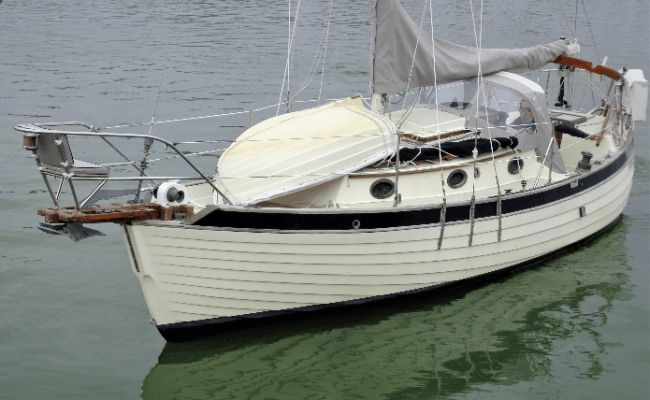
The Nor’Sea 27 is an excellent choice if you are single or searching for the best liveaboard sailboats for minimalists. This boat is arguably the best compact liveaboard cruiser available in the market today.
The compact boat has a surprisingly spacious interior for a 27-footer. Plus, it features almost every amenity you can find on a larger boat.
For comfort, the small sailboat feels more like a Catalina 30 and comes with a galley, shower, toilet, and two bunks below the cockpit. The forward berth also serves as a dinette.
The design of the sailboat is a huge success and has found a pretty strong following, which explains why it is still in production to date despite hitting the market long ago in 1976. As expected, the little sailboat costs less in slip fees. But the best part is that you can tow it on a trailer, and that’s all legal.
Don’t be fooled by its size, though. The Nor’Sea 27 isn’t cheap. Prices for new ones start from around $150K (with kits starting anywhere from $35K). You find used ones for as little as $15,500 or as much as $95,000 depending on age, quality of finish, and condition.
Find out current listings and prices here.
- Ballast: 3,100 lbs
- Displacement: 8,100 lbs
- Water Tank: 20 gallons
- Fuel Tank: 20 gallons
How to Choose the Best LiveAboard Sailboats – Buying Guide
There are several things to consider when choosing a liveaboard sailboat, but perhaps the most important factor is the level of accommodation that will suit your need. A boat with useful features such as a fully functional kitchen or electric toilets are well and fine, but many traditional sailors don’t really care about limited amenities. Any stripped-down sailboat with basic interior would do just fine.
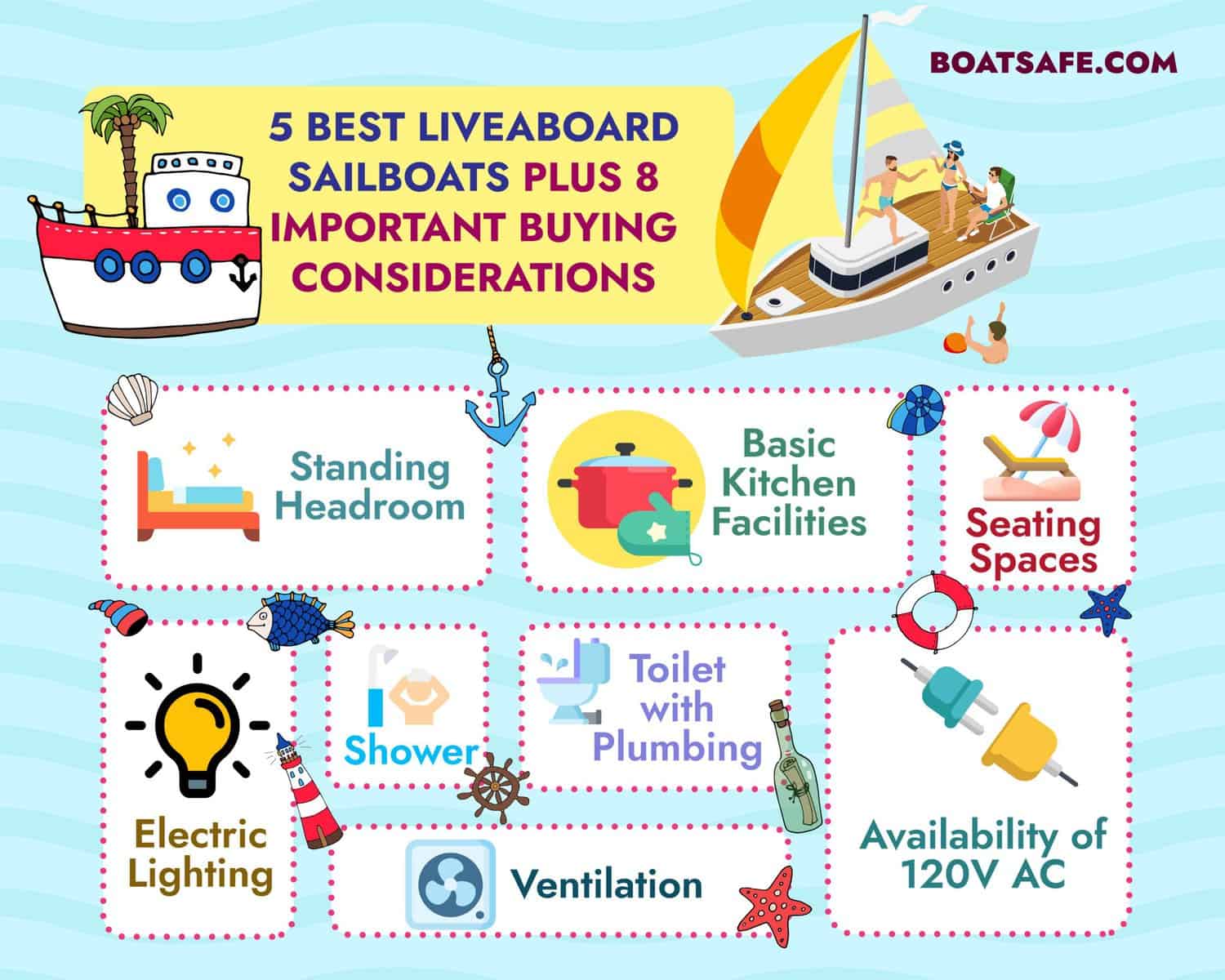
Most sailors are generally okay with any standard live about sailboats constructed after 1970 since these types typically have adequate ventilation , a usable kitchen, head, and shower. But whatever your preferences, you can be sure you will find something that will provide the level of comfort you need in most modern sailboats.
Here are 8 important factors and requirements we think are crucial when choosing the best liveaboard sailboats.
1. Standing Headroom
There’s nothing wrong with spending a couple of days in a week aboard a boat without standing headroom. However, if living aboard a sailboat is a lifestyle choice for you, consider one with standing headroom. Your body is not meant to crouch or crawl for months or years on end. With time, your back and other muscles will start to take a hit. For your overall health and wellbeing, it is best to choose a sailboat with standing headroom. Our recommendation is 5-feet 10-inch standing headroom or something within that range.
2. Basic Kitchen Facilities
A liveaboard boat without a kitchen can only mean one thing: you will be eating out every single day! While this is okay for some people, others will prefer to cook their own meals at least once in a while, regardless of their culinary skills.
We think a kitchen is a must-have for the best liveaboard sailboats, even if it doesn’t have all the modern facilities. Basic kitchen facilities should include a refrigerator or icebox, a sink, and a stove. If you find one with an oven, that’s a plus, too!
3. Toilet with Plumbing
The fastest way to spread diseases when you liveaboard a boat is to have improper human waste storage and disposal system. Sanitation facilities are among the top considerations when choosing the best liveaboard sailboats.
Using a porta-potty all year long is definitely out of the question. Besides, no one would like to live on a stinky boat or have guests come over a smelly abode. When you choose a liveaboard sailboat, look for one with a built-in and properly outfitted toilet. It should also have a safe sewage storage tank with a proper disposal system.
Many liveaboards prefer to use gym or marina facilities instead of their onboard showers. This is okay, but it doesn’t eliminate the need for bathing facilities on board. Choose a sailboat with a shower for convenience’s sake, even if you don’t use it all the time.
It is important to make sure that your bilge pump is always in good working condition, especially if you have a boat shower that drains directly into the bilge. Keep in mind that whatever goes into the drain will find its way below your floor.
5. Electric Lighting
Having kerosene lamps is okay. In fact, many sailors love to have them because it adds a certain feel and beauty to their boats. But you definitely want to consider the convenience and safety offered by electric lighting. If you plan on living aboard a boat for a long time, you will need some form of reliable electric lighting.
6. Availability of 120V AC
The best liveaboard sailboats come with 120V AC outlets for standard house electricity connections. The availability of electricity is a definite requirement for living aboard a boat. You want to have a way to charge your cell phones, computers, and use other electronic gadgets. A boat with only a 12V outlet is not good enough. It is best to choose a sailboat with 120V AC outlets if you want to enjoy electricity living aboard a boat full-time.
7. Seating Spaces
Apart from the main bed, the best liveaboard sailboats should have additional seating spaces. There should be separate spaces for sitting, working, navigating, and eating, especially if you plan on living aboard for a long time. You don’t want to be bored with the monotony of using only one space (the main bed) for all your daily activities. Having separate seating spaces has the added advantage of making your day-to-day activities more agreeable.
8. Ventilation
Perhaps the simplest requirement for liveaboard sailboats is ventilation. But it is equally essential, regardless. An opening porthole or a passive solar roof vent should suffice. The important thing to consider when it comes to proper ventilation is a boat that provides a way to let in fresh air without needing to open the main hatch.
Coastal Vs. Offshore Accommodations
And now, here’s one final factor to consider before choosing a liveaboard sailboat. How do you plan to use your boat? Do you want a sailboat that will serve primarily as a long-distance cruiser, or do you intend to use it mainly for coastal cruising?
Your intended use significantly affects the style of interior design that will be suitable for your purpose. Sailboat accommodations are greatly impacted by their cruising purposes. Coastal cruisers are likely to feature more plush layouts, complex interiors, and larger sofas. Also, these boats generally have several amenities, so it is common to have smaller storage spaces in these sailboats.
On the other hand, offshore or long-distance cruisers feature cabins that are designed and arranged to make the journey as comfortable as possible. These sailboats generally don’t have unnecessary furniture and other extras below deck to make room for increased sleeping and storage spaces.
It is easy to get carried away during the physical inspection of a sailboat, especially if the boat is equipped with modern facilities and fanciful, eye-catching amenities. But don’t get swayed by those, even though they are important for improved convenience. Your top priority should be how you intend to use the boat – for coastal cruising or offshore cruising. This should inform your choice of accommodation.
Benefits of Living on a Sailboat
Okay, why should you want to give up living on land and opt for an unstable address somewhere in the middle of the ocean? Is it even safe to do so?
Living aboard a sailboat is an exciting lifestyle that offers several benefits and challenges, too! Thousands of people across the world choose this lifestyle, and because these boats are constructed from high-quality, durable materials, you can be sure it is safe to liveaboard one.
This lifestyle offers liveaboards a cheaper alternative than living in a traditional house. This is particularly the case in waterfront cities where rental apartments and houses in the marina areas are even more expensive.
It is a lot cheaper to live in a boat if you enjoy traveling around the world on the water. And if you enjoy the marina lifestyle, you could take it a step further by owning and living in one of the several best liveaboard sailboats available.
And come to think of it, these boats require some serious investments. What’s the point of buying a “house” on the water without living in it, right? To many people, it makes more economic sense to live in their expensive boats, instead of paying extra rent for a house on the land when there is one idling away on the water.
About Chris
Outdoors, I’m in my element, especially in the water. I know the importance of being geared up for anything. I do the deep digital dive, researching gear, boats and knowhow and love keeping my readership at the helm of their passions.
Categories : Boats
Leave a Reply Cancel reply
Your email address will not be published. Required fields are marked *
Save my name, email, and website in this browser for the next time I comment.
More in Boats

What Is A Gunwale?

131 of the Best Hawaiian Boat Names

167 Patriotic Boat Names

The 138 Best Boat Names for Dog Lovers

The People’s Poncho Review and Ratings

Oru Lake Kayak Review

About Boatsafe
Established in 1998, BoatSafe is your independent guide into the world of boating, fishing, and watersports. We provide expert insights and detailed guides to help you find products tailored to your needs and budget.
Contact Boatsafe
- Address: 4021 West Walnut Street. Rogers, AR 72756
- Phone: (479)339-4795
- Email: [email protected]
Site Navigation
- How We Test
- Corrections Policy
- Privacy Policy
- Terms & Conditions
- Editorial Policy
- Affiliate Disclosure
Our Reviews

All content is © Copyright 2024. All rights reserved.
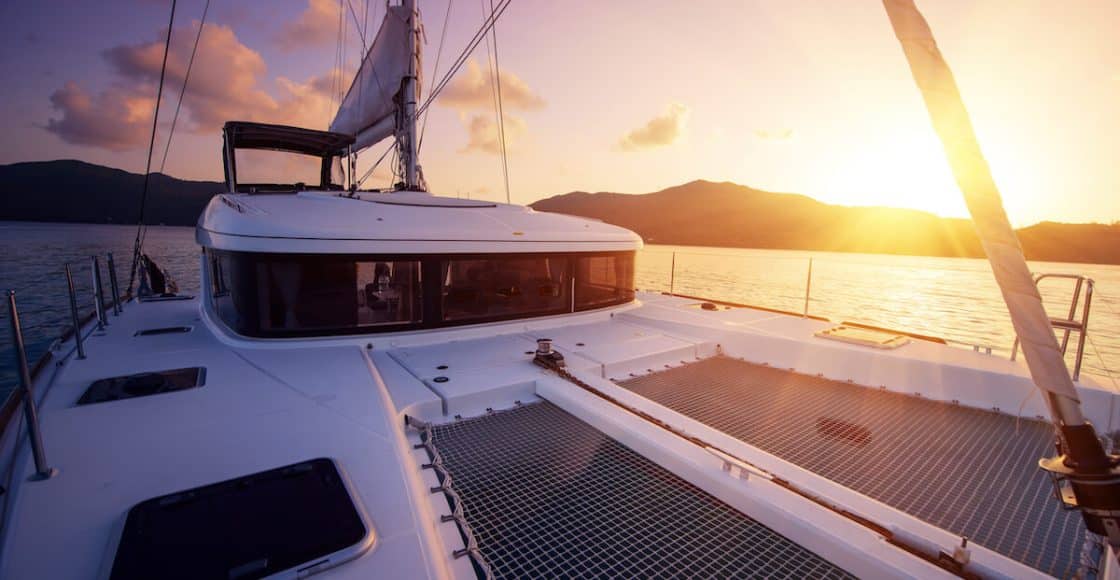
5 Best Liveaboard Boats

Table of Contents
Last Updated on November 3, 2023 by Boatsetter Team
Want to live aboard a boat? Maybe you’re looking for more affordable waterfront living, or an alternative lifestyle – either way – living on a boat has many rewards. That said, choosing the right boat will make all the difference to your happiness. Before you commit, consider these five best liveaboard boats :
- Motor yachts and cabin cruisers
- Trawlers
- Sailboats
- Catamarans
- Houseboats
Find Live Abroad Boats ready for rent here
Motor yachts and Cabin Cruisers
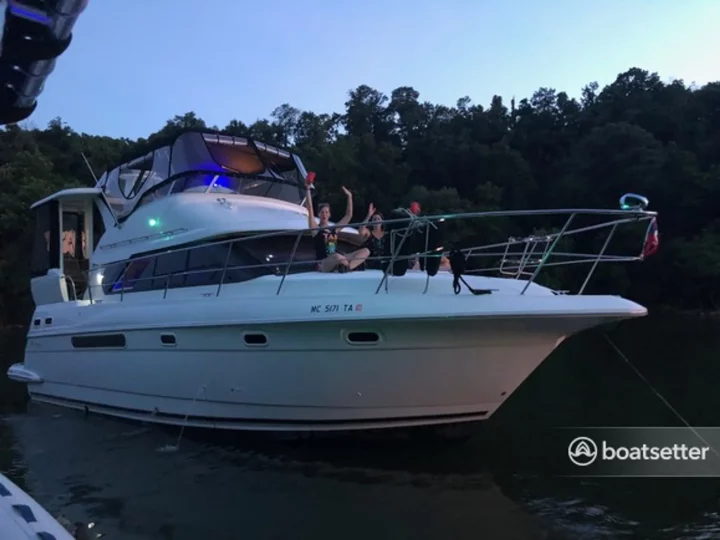
Motor yachts is a broad term that encompasses large(ish) motorboats with accommodations like a bed (sleeping cabin), a head (bathroom), and a galley (kitchen). These boats can be quite large such as an Absolute 50 with a flybridge that provides extra space for outdoor recreation/entertainment, like the backyard of a house.
Models like these usually have three cabins and two heads to accommodate an entire family. Of course, big boats come with big price tags and lots of maintenance needs, so you may not save much over living in a condo.
Consider how much space you need and check out some best liveaboard boats under 40 feet. Cabin cruisers like the Cutwater 32 are great choices. This boat has one cabin as well as a galley and lounge area (living room) with large windows that bring in lots of natural light and air.
The twin outboard engines can transport your home to new surroundings in the blink of an eye. Best of all, boats under 40 feet may save you a million dollars (literally) over large motor yachts and provide many of the same amenities.
2. Trawlers
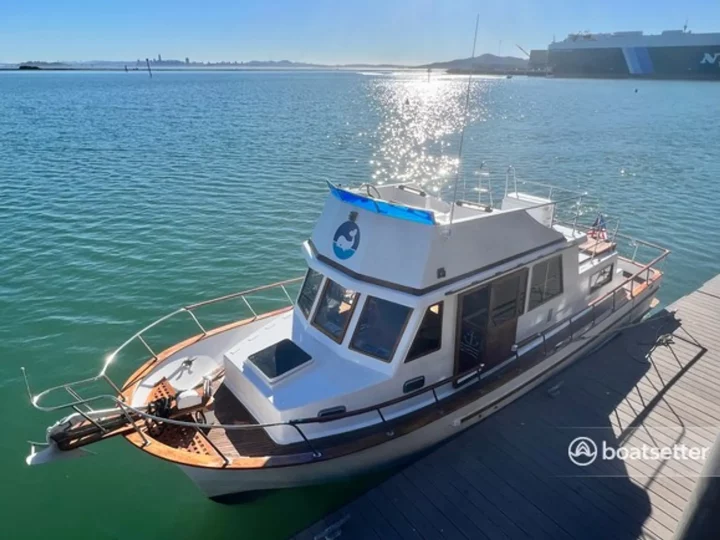
Trawlers are a great option because they are built with the liveaboard lifestyle in mind. They’re typically slower boats designed for long-distance cruising, and they come in many sizes from a large Nordhavn 60 built for tough ocean conditions to a more compact Beneteau Swift 35 that’s ideal for coastal cruising.
Most trawlers have good liveaboard layouts and will travel at speeds 8-10 knots, where they offer good fuel consumption , which is important with high diesel prices.
Pro Tip: Not all trawlers are slow – the French Swift series is designed to run at planning as well as trawling speeds, so you get the best of both.
READ MORE: Don’t Ignore Your Bucket List: Great Loop
3. Sailboats
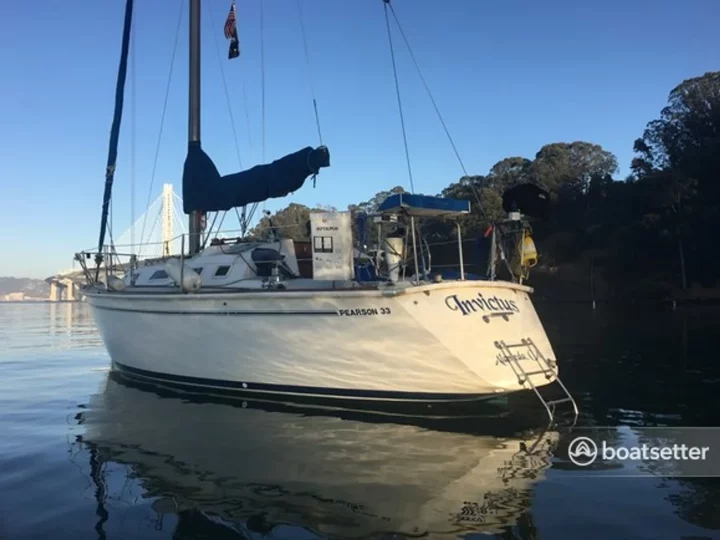
Perhaps you’re contemplating living aboard in preparation for long-distance cruising under sail. Sailboats come in all sizes, just like motor yachts, but they’re usually narrower, and most of the living aboard happens lower down in the boat, so they’re not as airy and light.
On the plus side, because space is more premium, sailboat design is very efficient, so you can pile a lot into a sailboat and still have room for sailing necessities.
Looking for a compact sailboat? Consider the Jeanneau Sun Odyssey 380 with two or three cabins in just 38 feet. For something a bit roomier, check out the new Hanse 510 . This massive model can be spec’d with up to five cabins and even has a tender garage.
The great thing about sailboats is that you can travel long distances when you want to change your neighborhood entirely – and with little money spent on fuel.
4. Catamarans
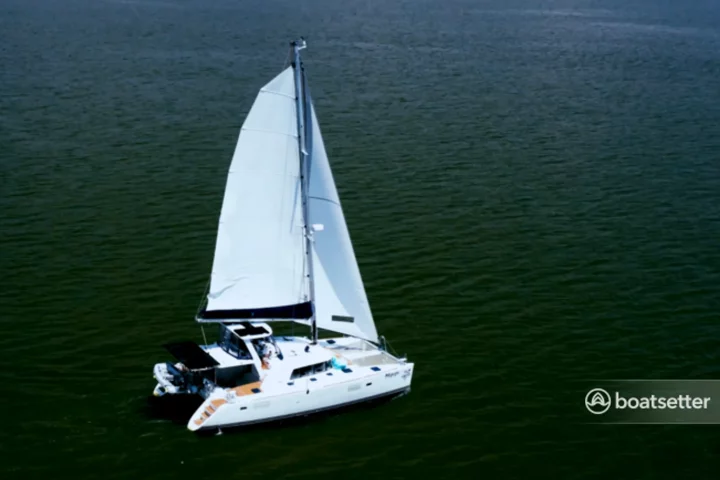
Catamarans are boats with twin hulls and they can be both power and sail models. They have many advantages including more room aboard than the same-length monohulls with better cabin privacy and more system redundancy for backup options.
They’re more stable both in motion and at anchor (dock) so they produce less seasickness and are more comfortable in a rolly anchorage at night. They’re roomy platforms for kids as well as older folks but due to their beam (width), it’s harder to find a slip for them in a marina.
Sailing cat models come in various sizes and prices. Production boats like the Fountaine Pajot Isla 40 and the Excess 11 are both around 40 feet but feel much bigger than a monohull sailboat of equal length.
Many cats come in an “owners’ version” where one entire hull is dedicated to the master suite which is like a bedroom at home. Models like these start around $500,000 but upmarket, carbon fiber, semi-custom designs like the HH55 will set you back multiple millions.
Powercats are growing in popularity and offer the same amenities as their sailing counterparts, except they have bigger engines to travel at much greater speeds. Powers can be on the smaller side, like the 32-foot Aspen C100, or quite sizeable, like the Aquila 54. Cats tend to be more expensive to purchase and to own since there are two of just about everything to maintain.
5. Houseboats
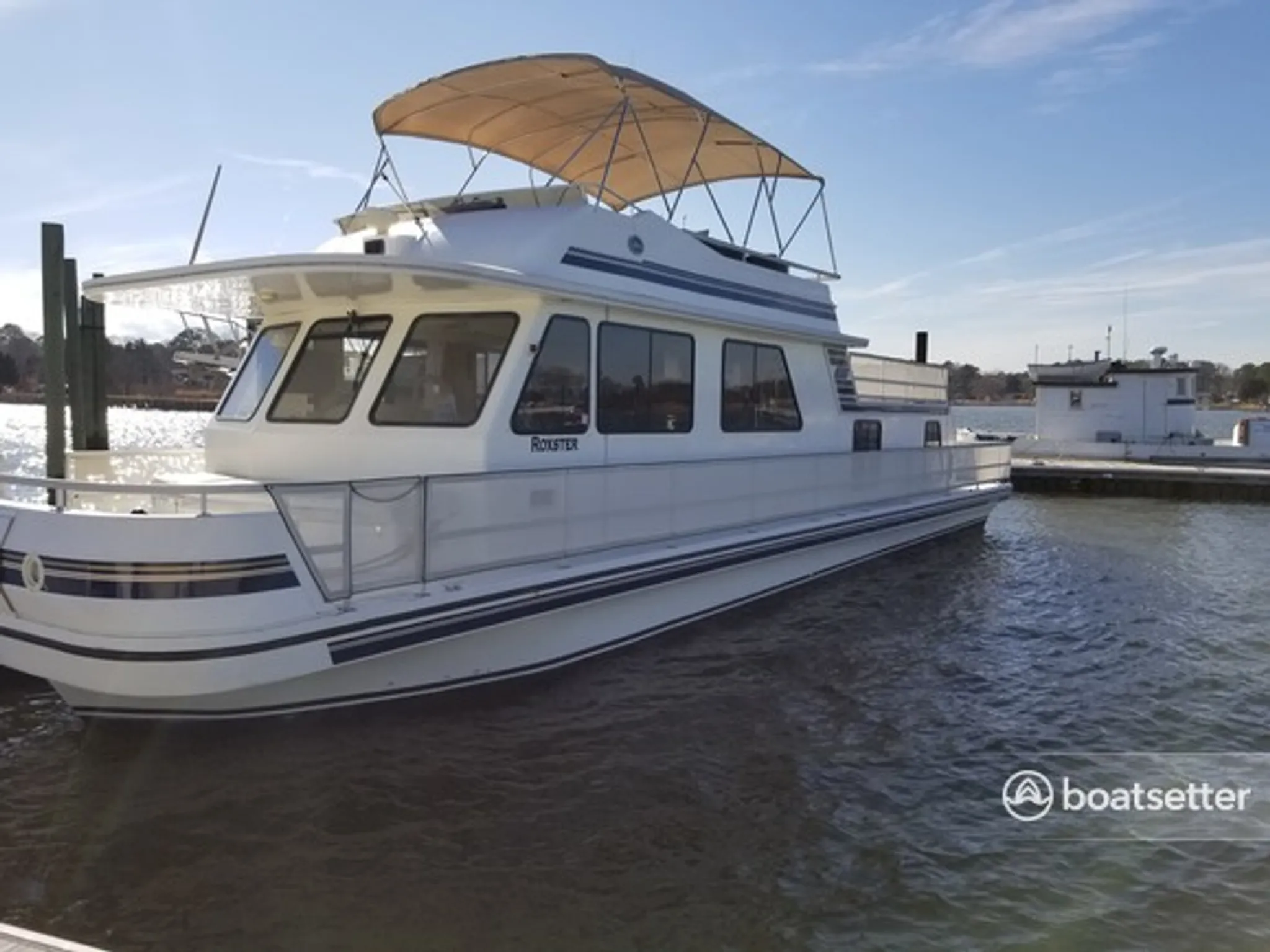
If you want to live aboard but have little interest in being mobile, you may consider a houseboat. These boats usually maximize living space and are shaped more like houses than boats. Household-sized amenities, including side-by-side refrigerators, massive sofas, and large TVs can be had.
Because they don’t require much technical gear like engines, electronics, and advanced power systems, houseboats can be quite affordable and can make the best liveaboard boats under $100k.
A few companies build houseboats like Eco-Sea Cottages, but many will be one-off and home-built designs. Although these boats don’t move (much), they must still have a solid floating foundation to be safe, and only some marinas will allow them to dock there.
One more thing to consider
There are no hard rules as to what makes a great liveaboard boat! You just have to find one that suits you and your budget. Read our Living on a Boat post for more insight, and be sure to browse through Boatsetter to find the perfect liveaboard boat.
About Boatsetter
Boatsetter is a unique boat-sharing platform that gives everyone — whether you own a boat or yyou’rejust renting — the chance to experience life on the water. You can list a boat , book a boat , or make money as a captain .
List. Rent. Earn— Only at Boatsetter

Zuzana Prochazka is an award-winning freelance journalist and photographer with regular contributions to more than a dozen sailing and powerboating magazines and online publications including Southern Boating, SEA, Latitudes & Attitudes and SAIL. She is SAIL magazines Charter Editor and the Executive Director of Boating Writers International. Zuzana serves as judge for SAIL’s Best Boats awards and for Europe’s Best of Boats in Berlin.
A USCG 100 Ton Master, Zuzana founded and manages a flotilla charter organization called Zescapes that takes guests adventure sailing at destinations worldwide.
Zuzana has lived in Europe, Africa and the United States and has traveled extensively in South America, the islands of the South Pacific and Mexico.
Browse by experience

Explore articles
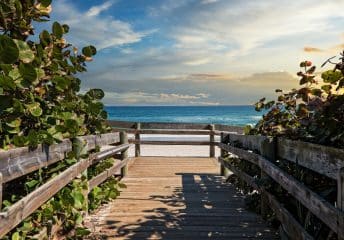
5 Best Beaches in Melbourne, Florida
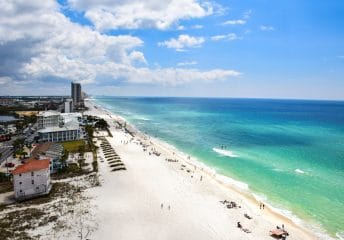
Things to do in Panama City, FL by Boat
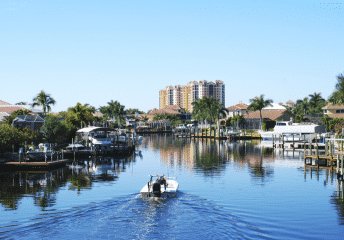
6 Best Cape Coral Restaurants on the Water to Get to By Boat
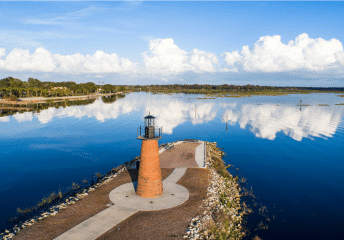
Lake Towns in Florida

- Search Used Yachts For Sale
- Search Boats By Brand
- Search Boats By Type
- Search By Location
- Search By Price
- What's My Boat Worth?
- Search Boats Just Listed
- Small Yachts
- Custom Sport Fishing Boats
- Finance A Boat
- Amer Yachts
- Aquitalia Yachts
- Cabo Yachts
- Century Boats
- French Yachts
- Gulfstream Yachts
- Hatteras Yachts
- Shelter Island Yachts
- Solaris Yachts
- Sunpower Yachts
- Sunreef Yachts
- Vela Boatworks
- Virtus Yachts
- Why List With United?
- Why Own A Boat Or Yacht?
- Custom Website For Your Yacht
- United Sold Boats
- Buy A Yacht With Crypto
- Find a Yacht Broker Near Me
- Search For Broker By Name
- Meet The United Support Team
- Our History
- Fort Lauderdale Boat Show
- Stuart Boat Show
- Miami Boat Show
- Palm Beach Boat Show
- Other Boat Shows
- Yachting News
- Yacht Closing Services
- River Forest Yachting Centers

Search All Yachts
Used Live Aboard Boats For Sale
Narrow your search.
Manufacturer
If your dream is to live aboard a yacht , United Yacht Sales has the inventory to connect you with the perfect boat. We feature more than 1,000 listings at any given time. You can always find a huge selection of live aboard yachts for sale in Florida. These live aboard yachts are made by a number of top brands, including Hatteras , Viking , Sea Ray , Tiara , Sunseeker , Kadey-Krogen , and more. Our inventory also represents a variety of dimensions, ages, amenities, price points and other characteristics and features.
PRE-OWNED Live Aboard Boats

70' Hatteras 1988
Stuart, Florida, United States

63' Viking Motor Yacht 1989
Little River, South Carolina, United States

55' Viking 55 Convertible 2013
Pensacola, Florida, United States

54' Hatteras Motoryacht 1987
Savannah, Georgia, United States

54' Sea Ray Sundancer 2013
Cancun, Mexico

53' Hatteras 53 Motor Yacht 1980
Mystic, Connecticut, United States

52' Hatteras Sport 1999
Miami Beach, Florida, United States

INSPIRATION II
51' Riviera 51 Flybridge 2008
Marathon, Florida, United States

50' Absolute 50 Fly 2019
Manhattan, New York, United States

50' Custom Trawler 1991

50' Carver 506 MY 2000
Richmond, British Columbia, Canada

50' Carver 500 Cockpit Motor Yacht 1996
Bay City, Michigan, United States

50' Chris-Craft 500 Constellation 1987
Isle of Palms, South Carolina, United States
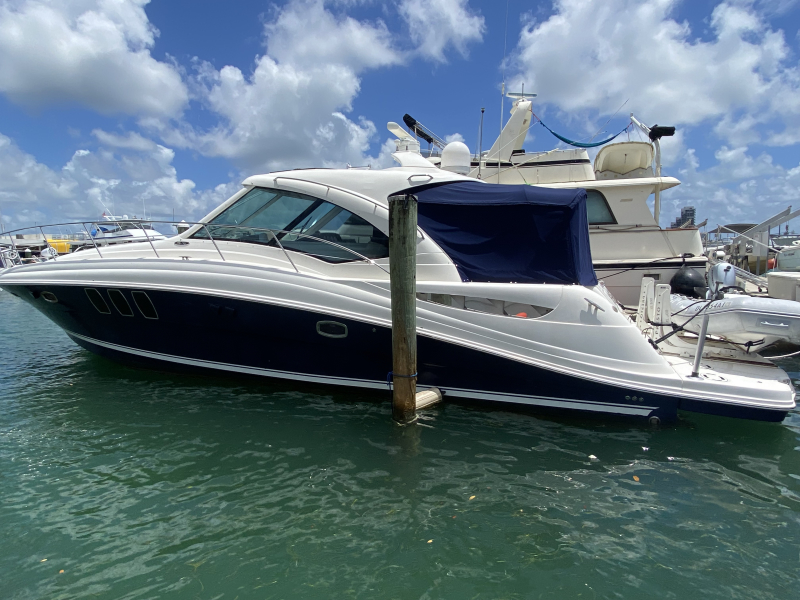
BORN TO BE WILD
48' Sea Ray 48 Sundancer 2008
North Miami, Florida, United States

48' Californian 48 Motor Yacht 1986
North East, Maryland, United States
- Page 1 of 5
SEARCH ALL YACHTS
How We Can Help?
Founded in 2002, United Yachts Sales has grown to become the largest independent yacht brokerage in the world. In addition to our 1,000-plus listings, we have a team of more than 100 brokers spread across the United States and Canada. These brokers are experienced and knowledgeable, and each is more than capable of helping you find the perfect live aboard yacht for sale in Florida. Our team's talent is evidenced by our results - each year, about 600 transactions close representing about $100 million. When you want a live aboard yacht, we know how to find and secure it for you.
Take a moment to read our article, Liveaboard Boats Frequently Asked Questions and then let us know if you have any of your own!
You can read more about 7 unique liveaboard boats and yachts that are currently for sale on the market.
Browse our selection of live aboard yachts for sale in Florida and contact the listed broker to get more details or ask questions. If you don't see a yacht that meets your needs, contact one of our United Yacht Sales brokers directly. We can watch the market for a boat that better fits your requirements.
Browse our inventory or contact us today .
Worldwide Yacht Sales
- Boats For Sale Puerto Rico
- Boats For Sale Stuart FL
- Silent Yacht
- Boats For Sale Bahamas
- Trawlers For Sale New York
- Boats For Sale Corpus Christi TX
- Front Runner Boats
- 15 Million Dollar Yacht
- Boats For Sale Cape May NJ
- Yachts For Sale in Massachusetts
- Million Dollar Boat
- Sailboats For Sale in Georgia
- Yacht Brokers Jacksonville FL
Luxury Boats & Yachts
- 48 Ocean Yacht
- Sabre For Sale
- Broward Yachts For Sale
- Yachts For Sale in Texas
- Used Center Console Boats
- 200000 Boat
- 50 Foot Yacht
- 2 Million Dollar Yacht
- Hinckley Boats
- 60 Ft Yacht For Sale
- Yachts For Sale Near Me
- Trawlers For Sale
- Viking Yachts
Popular Builders & Models
- Used Power Catamaran For Sale
- 44 Sea Ray Sundancer For Sale
- Sea Ray L650
- Used Pursuit Boats For Sale
- Sailboats For Sale in South Carolina
- Is A Yacht A Good Investment?
- Boston Whaler 350 Outrage
- 54 Hatteras Motor Yacht For Sale
- Edgewater Boats For Sale
- 55 Viking For Sale
Trending Brands & Types
- Ocean Alexander 120 Mega Yacht For Sale
- Beneteau Boats For Sale
- Used Hatteras Boats For Sale
- Selene Owners
- Formula Yachts
- Meridian Yachts For Sale
- Tartan Boats
- Egg Harbor For Sale
- Sport Fishing Yachts
- Cheoy Lee Sailboats For Sale
- Live On Boats For Sale
- Contender For Sale
SPEAK TO AN SPECIALIST
Speak to a sales professional.
- BOAT OF THE YEAR
- Newsletters
- Sailboat Reviews
- Boating Safety
- Sailing Totem
- Charter Resources
- Destinations
- Galley Recipes
- Living Aboard
- Sails and Rigging
- Maintenance

10 Best Used Cruising Sailboats
- By John Kretschmer
- Updated: June 4, 2021
The appeal of offshore voyaging is difficult to explain to land people who can’t imagine life without basic human rights like copious quantities of hot water and unlimited data. It can even be challenging to explain to fellow sailors who think the notion of spending days or weeks at sea is a form of waterboarding, some kind of self-inflicted torture.
But for those of us who understand, who relish intimacy with the untamed wilderness that is the ocean and embrace self-reliance and individual expression while accepting the dispassionate whims of Neptune, this is the good life.
There are two essential truths about this life: One, money does not matter. Cruising budgets and lifestyles reflect bank accounts with variously positioned commas; it’s the passages and landfalls that add up, not your investment portfolio. And two, a good bluewater sailboat — not necessarily an expensive boat, but a well-designed, solidly built, imminently seaworthy boat that is only limited by your moxie and imagination — is the key to successful bluewater passagemaking.
So, to that second point, I’ve compiled a list of interesting and affordable cruising sailboats for serious voyaging. A list of 10 sailboats for any purpose, much less world cruising, is sure to evoke outrage from strong-minded sailors, who by nature tend to be a bit opinionated. Stand by before hurling insults my way, and let me explain. I have decided to stay away from the sailboats we know by heart, the iconic old boats that usually populate a list like this: the Westsail 32, Tayana 37, Shannon 38 and Valiant 40 (the last of which, with a bit of searching, can still be found at or just below $100,000).
My list of some of the best liveaboard sailboats is eclectic and includes a mix of well-known and obscure manufacturers, but all the boats are linked in three ways: All are top-quality vessels capable of crossing oceans. They’re affordable, although in a few cases you have to look for older models in less-than-stellar condition to stay below $100,000. Indeed, in some ways, this list of used sailboats is a function of age; most of the boats were priced at more than $100,000 when new but have dipped below our self-imposed threshold in middle age. And finally, they’re all boats that I have encountered in the past few years in far-flung cruising destinations .
Island Packet 35
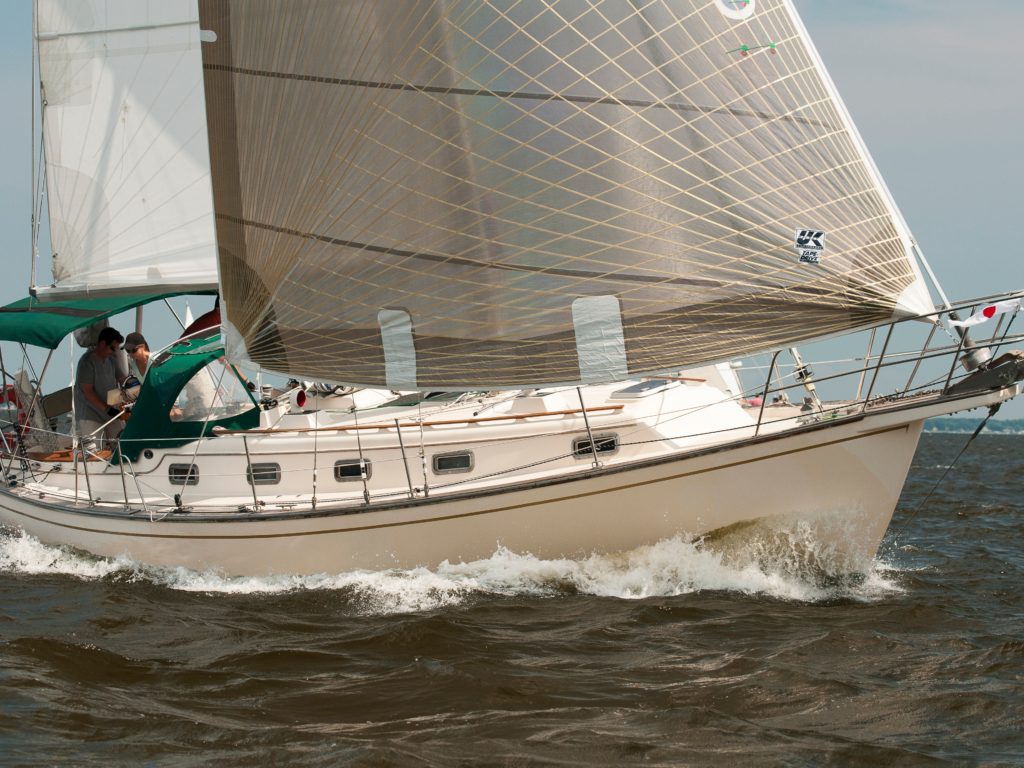
Love them or loathe them, Island Packets are everywhere. To some, the beamy, full-keel, high-freeboard hull designs seem quaint, to put it charitably. To others, the robust construction standards, roomy interiors and overall user-friendliness make them the ideal cruising boat. More than most, sailing vessels are compromises, and Bob Johnson and his crew at Island Packet were brilliant in prioritizing the needs of sailors. The IP 35 was introduced in 1988 and features a huge cockpit, an easy-to-handle cutter rig with a jib boom, and a clever, comfortable interior with the volume of many 40-footers. It might not be the fastest boat upwind, but the long waterline translates to good performance off the breeze, meaning the IP 35 finds its stride in the trade winds. In all, 188 boats were built before production stopped in 1994.
Don’t confuse the IP 35 with the IP 350, which was launched in 1997 and included a stern swim step. You won’t find a 350 for less than $100,000, but you will have a choice among 35s, especially those built before 1990. With two nice staterooms, the 35 is ideal for family cruising. I know of a couple of 35s that have completed the classic Atlantic Circle passage. It’s perfect for a sabbatical cruise because it holds its value and there’s a ready market when it comes time to sell.
Prout Snowgoose 37
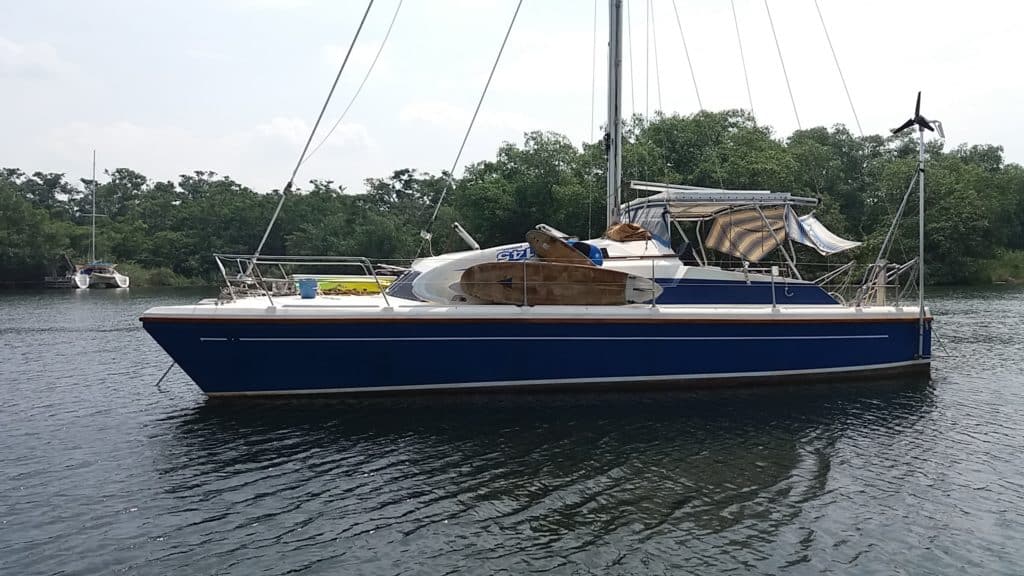
There’s no room for discussion: Catamarans are crossing oceans, and many sailors are choosing cats for world cruising. My last visits to the Azores and Canary Islands, the classic Atlantic waypoints, proved the point. I’m not much of a statistician, but by my count, at least a quarter and maybe a third of the boats I saw were catamarans. There would be more on this list, but they are just too expensive. Finding a quality catamaran for less than $100,000 is tough. One boat to consider is the classic workhorse multihull, the Prout Snowgoose 37.
When the Snowgoose 37 was launched in 1983, English builder Prout & Sons had already been in business for nearly 50 years. The 37 was an updated version of the Snowgoose 35, one of the most successful cruising cats ever. In 1986, the 37 was updated again; the Snowgoose Elite model included more beam and interior upgrades. These models are challenging to find for under $100,000, but it’s possible. A quick glance at yachtworld.com shows several of both models available for less than $100,000. Again, the strong dollar makes European boats an excellent value.
The Snowgoose 37 is not sexy like go-fast cats, and not roomy like modern cruising cats. It is, however, seaworthy. Of the 500 built, many have circumnavigated. Older boats have solid fiberglass hulls, and more recent models are solid glass from the waterline down and cored above. The cockpit is rather compact by catamaran standards, and the bridgedeck is solid (no tramp). Many 37s and all Elites were rigged with staysails, a big plus in heavy weather. The masthead-rigged Snowgoose 37 can be sailed like a monohull offshore, and it’s quite nice not having a huge, roachy mainsail to wrestle with in a storm. With a 15-foot-3-inch beam for the 37 and a 16-foot-3-inch beam for the Elite, it’s easy to find affordable dockage and yards for haulouts. Most boats have three double cabins, making the Snowgoose 37 an ideal family cruiser.
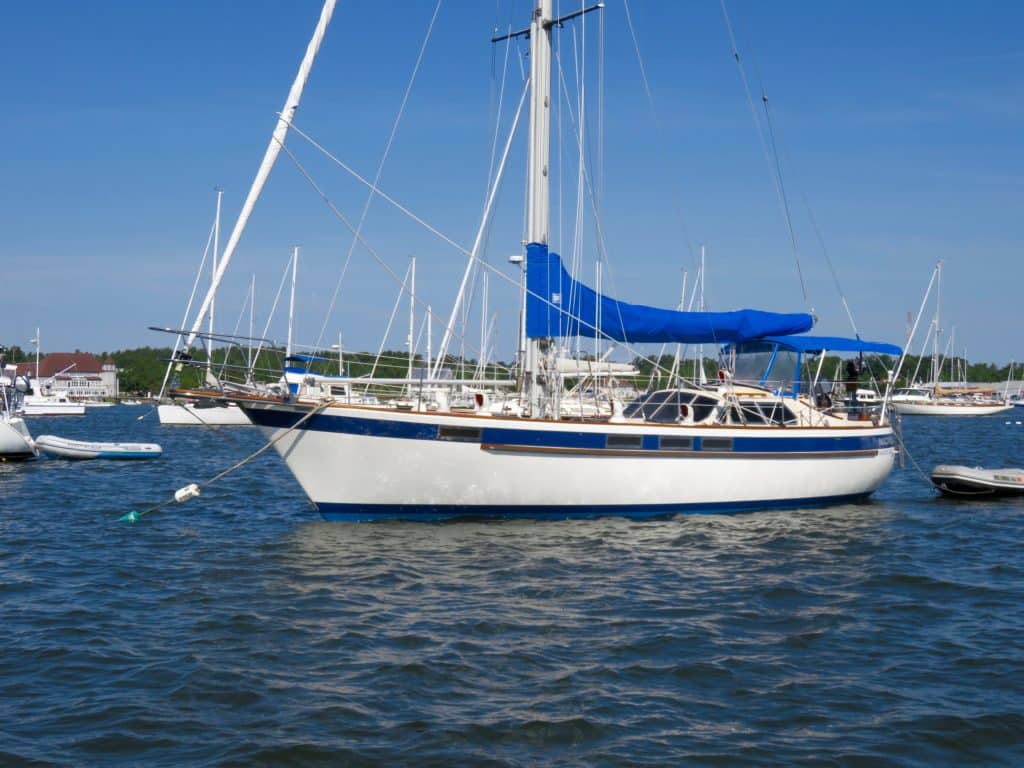
The Corbin 39 is not as well known as it should be. It’s a capable bluewater sailboat cruiser with many impressive voyages logged. My Quetzal spent several weeks moored alongside a handsome 39 in Corfu that had sailed around the world, and I also spent a winter in Malta in the same boatyard as another 39 that had recently crossed the Atlantic. A canoe-stern, flush-deck pilothouse cutter, the 39 was offered with either an aft or center cockpit. Designed by Michael Dufour and constructed by Corbin les Bateaux in Canada, hull number one was launched in 1977. Built in various locations in Quebec, 129 boats were launched before a fire destroyed the deck tooling in 1982. A new deck with a larger cockpit was designed, and 70 more boats were laid up before production ceased in 1990.
The rub on the Corbin 39 is that the majority of boats were sold as kits with owner-finished interiors. Kits varied from just hull-and-deck to “sailaway,” with everything fitted except the interior. Only 15 boats were finished at the factory. Not surprisingly, the interior quality is unpredictable, from rough-hewn lumberyard specials to beautifully handcrafted gems finished by marine professionals. The difference is reflected in the price. A nicely finished, well-equipped model from the mid-’80s typically sells for between $60,000 and $80,000.
The hull shape features a long fin keel and skeg-mounted rudder. The hulls are heavily laid up and include Airex coring. Early decks were plywood-cored, but most boats have Airex in the deck as well. Ballast is 9,000 pounds of internal lead, translating to a 40 percent ballast-to-displacement ratio. The wide flush deck is spacious, and the sleek pilothouse usually includes inside steering. Massive double anchor rollers are incorporated into the bowsprit in later models. Most boats include a double-spreader spar, and almost all were set up as cutters. There’s plenty of freeboard, which becomes obvious below. While interior arrangements vary considerably, there’s a lot of room to work with. I prefer the post-1982 aft-cockpit 39s; they’re generally of a higher quality than earlier boats.
Cabo Rico 38
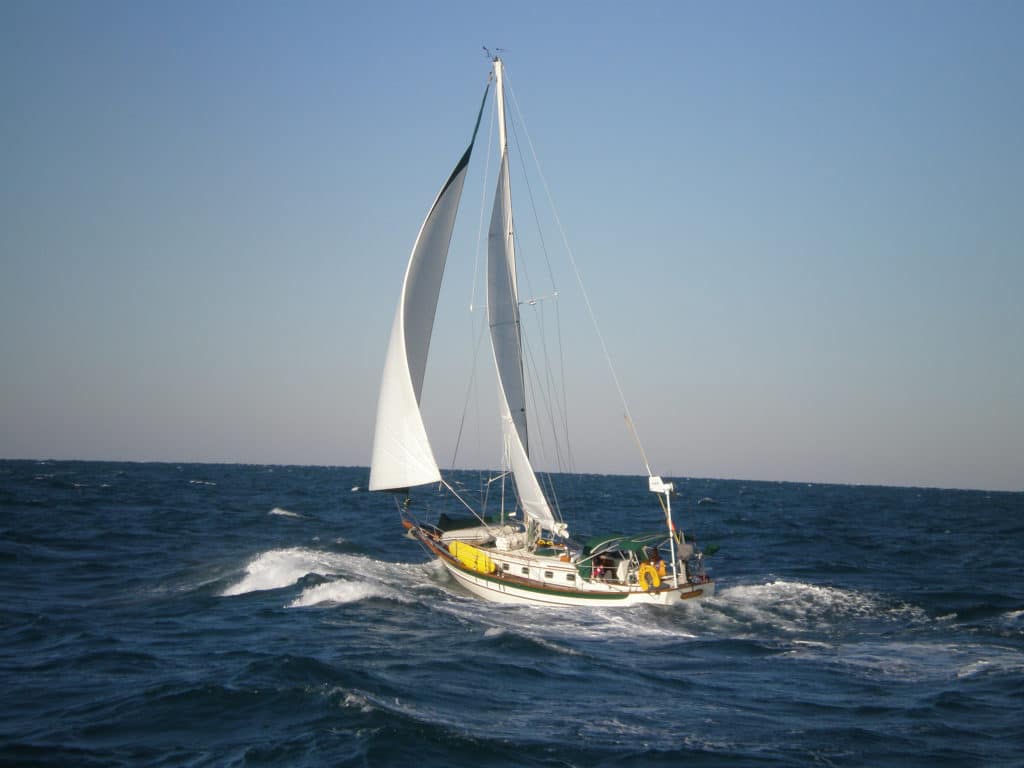
“The Cabo Rico 38 hull shape is the one in which everything came together best,” wrote Bill Crealock in his design notes. He might have changed his mind later in life, considering that the Cabo Rico was introduced in 1977 and he designed many boats after that, but few will dispute that this 38-foot cutter, built in Costa Rica, is flat-out beautiful. From the clipper bow to the sweet sheer to the abundance of honey-colored teak, the Cabo Rico 38 is a boat to inspire the most practical among us to quit their job, buy this vessel, and head for the South Pacific.
Not surprisingly, many people have done just that. Cabo Rico built 200 full-keeled 38s, with most of the production occurring in the 1980s. There’s always a selection of boats for sale for less than $100,000. Cabo Rico was an outlier among manufacturers of the time, building serious cruising boats in Central America instead of Taiwan, but quality control was always excellent. The full keel is slightly cutaway, and the rudder is attached to the trailing edge. The prop is in an aperture and totally protected, but not well suited to backing into a slip. Full-keel boats may make some younger sailors cringe, but the CR 38 has a very soft ride in rough seas and heaves to effectively. It also has a solid fiberglass hull with a layer of balsa for insulation. Sometimes it’s noted that the hull is balsa-cored, but it’s not. After about hull number 40, lead was used instead of iron for internal ballast. The deck is balsa-cored, however, and there’s a substantial bulwark. Items to be wary of are the teak decks (most 38s have them) and the fittings supporting the bobstay.
A true cutter rig, the 38 has just under 1,000 square feet of working sail area and performs better than most people suspect. The staysail was originally set on a boom that cluttered the foredeck and limited sail shape. Many boats have been converted with furling staysails sans the boom — a nice upgrade. When the wind pipes up, the 38 tracks nicely with a reefed main and staysail. I encounter 38s all over the Caribbean. They’re easy to spot; they’re the beautiful boats in the anchorage.
Tayana Vancouver 42
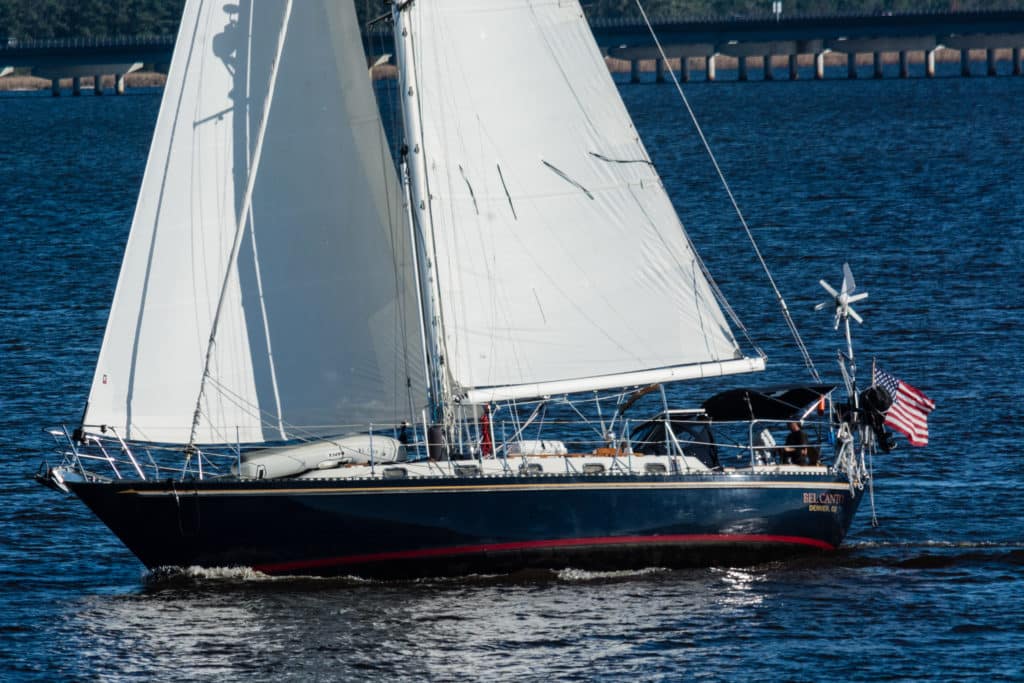
Ta Yang, builder of Tayana sailboats, has been building capable cruising boats forever, it seems. The Robert Harris-designed Tayana Vancouver 42 has been a mainstay of the serious cruising fleet since the day it was launched in 1979, and is still in demand today. The company built 200 boats, mostly in the ’80s and early ’90s, although a few V42s were built into the 2000s. With a bit of digging and some haggling, you can find boats for less than $100,000, but they’re likely to be older models. As of this writing, yachtworld.com has eight V42s listed, with three asking less than $100,000.
I’ve encountered the V42 all over the world, and in my yacht-delivery days, I had the pleasure of delivering a couple of 42s up the East Coast and down to the Caribbean. The double-ended hull shape with a fin-skeg underbody is stiff and seaworthy, if not wickedly fast. Considering the rugged construction, with a solid fiberglass hull and balsa-cored deck, nobody has ever accused Ta Yang of going light on its boats. Ballast is internal iron, a massive single casting that weighs in at 11,800 pounds. Ta Yang has evolved as a builder, and later models included upgrades like vinylester resin and larger Yanmar diesels.
A true cutter, the V42 has a double-spreader rig and is heavily stayed. The seagoing deck is cambered to shed water. Teak decks, with all their virtues and vices, were common; I’d look for a boat that’s been de-teaked. Like the Corbin 39, the V42 came with either a center or aft cockpit, although most boats were aft-cockpit models. The aft cockpit is deep and secure, if a bit tight due to volume sacrificed by the canoe stern. The center cockpit is cramped but offers excellent visibility. The interior is lovely, with exquisite Taiwanese joinery. Although interior arrangements vary because Ta Yang encouraged owner input, across the board, this is a friendly boat for living aboard. The aft-cockpit model includes one head and a traditional layout with excellent light and ventilation. The center-cockpit model features a large owner’s stateroom aft.
Wauquiez Pretorien 35
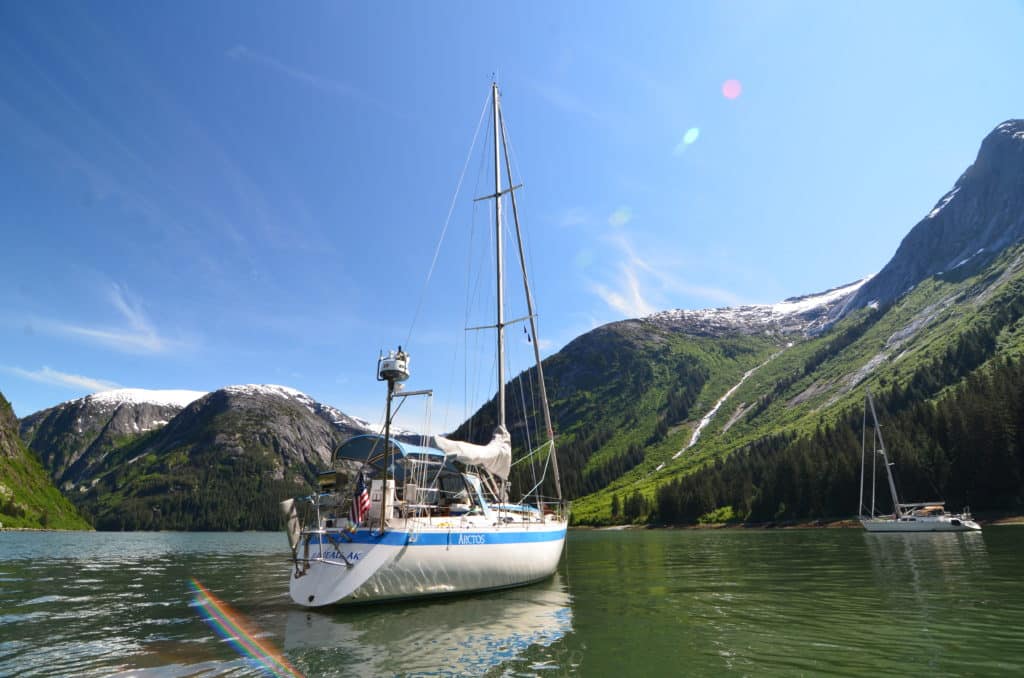
The Pretorien 35 does not pay homage to tradition. The Euro-style low-slung wedge deck and flattish lines were thoroughly modern when the Pretorien was launched in 1979. Sure, there are IOR influences in this well-proven Holman & Pye design, including a slightly pinched stern, cramped cockpit, and a high-aspect, short-boom mainsail that results in a large foretriangle. But a small main is easy to handle offshore, especially in squally conditions, and a large poled-out furling genoa provides a low-stress way to cross oceans. The test of a design is revealed long after the launch, and the Pretorien has aged brilliantly. It’s often mistaken for a Swan or Baltic. Famed voyager and author Hal Roth chose a Pretorien for his last boat.
Below the water, which is what really matters at sea, the Pretorien pushes the right buttons for serious sailing. A fine entry provides enough of a forefoot to prevent pounding in lumpy conditions, and as on the Valiant 40, the fin keel incorporates a stub to which the external ballast is fastened. The rudder is mounted well aft for excellent steering control, especially on a deep reach, and is tucked behind a narrow but full-length skeg. The Pretorien displaces 13,000 pounds, of which 6,000 pounds is ballast, translating to a stiff, seakindly boat.
The construction is superb. The solid fiberglass hull includes longitudinal stringers that stiffen the panels and encapsulate the bulkheads. Tabbing and fiberglass work is first-rate throughout. Wauquiez was one of the first builders to use solid laminate beneath high-load deck fittings. The side decks are wide and, with the chainplates well inboard, easy to navigate. The interior arrangement is conventional, but ample beam amidships helps create a surprisingly spacious feel below.
There were 212 Pretoriens built during a seven-year production run, so there’s usually a good selection of boats on the used market. Today’s strong dollar makes European Pretoriens an excellent value.
Gulfstar 44
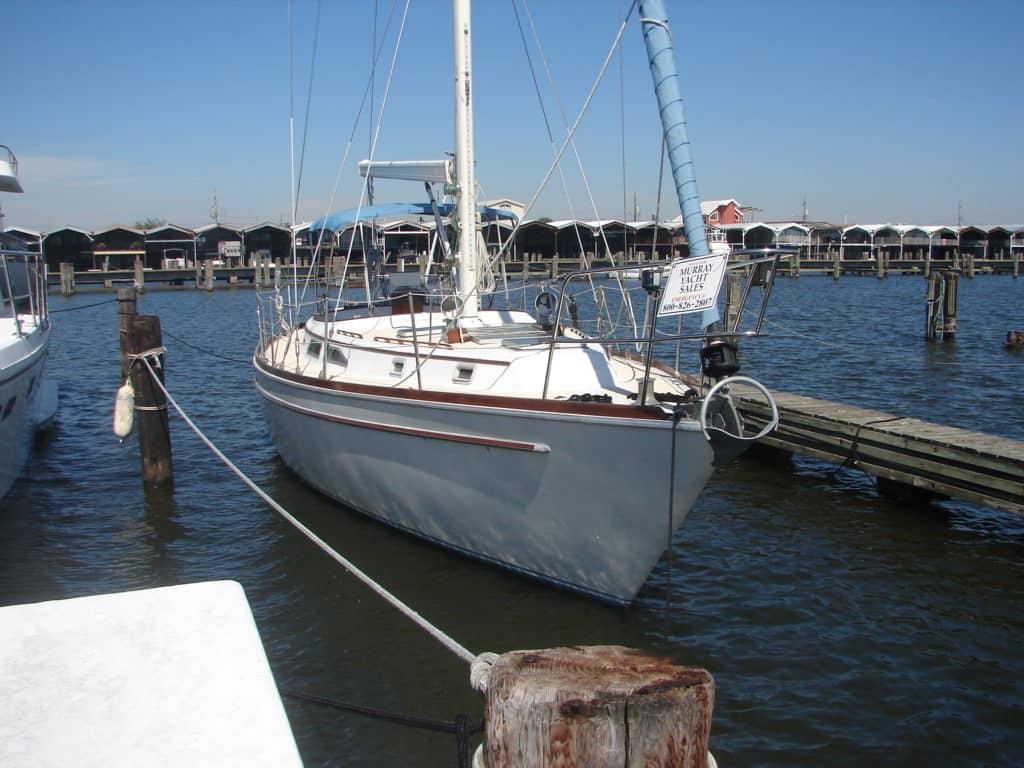
Gulfstar had a terrible reputation in the early ’70s: It was infamous for producing wide-body motorsailers with tiny rigs and chintzy Formica interiors. Company founder Vince Lazzara was adept at reading market trends and upped his game in the late ’70s and ’80s. Lazzara, who also founded Columbia Yachts, was a veteran of the production-sailboat wars and realized that buyers were demanding high-quality boats that sailed well. The Gulfstar 44 was launched in 1978, and 105 were sold before the company started producing the Hirsh 45 in 1985.
Some mistake the G44 for a Bristol, and it has a similar profile, right down to the teak toerail and raked cabin trunk. A sleek center-cockpit design, the hull shape features a 5-foot-6-inch fin keel, a skeg-hung rudder and moderate proportions. I know the boat well, having delivered one from Bermuda to Annapolis and another from Fort Lauderdale to Boston. It has a nice ride in lumpy seas and powers up when the big genoa is drawing on a reach. The construction is typical of the time, with solid fiberglass hulls and cored decks. Gulfstars were known to blister, and it’s likely that any 44 you find will have had an epoxy bottom job along the way — and if it hasn’t, it will need one. The keel-stepped spar has an air draft of 55 feet. Some owners have modified the sloop rig with a staysail. The cockpit is roomy, especially for a center-cockpit design, although there’s not much of a bridgedeck. All sail controls are led aft. Lazzara was an early proponent of this feature, and the boat is user-friendly overall.
The interior sells the boat. It’s nicely finished in teak, and the layout is made for living aboard. The aft cabin includes an enormous double berth with an en suite head and stall shower. The main saloon is spacious and well ventilated, although beware of the plastic opening portlights. If you are looking for a comfortable, well-built center-cockpit cruiser but can’t find one that you can afford, track down a Gulfstar 44; you’ll be pleasantly surprised.
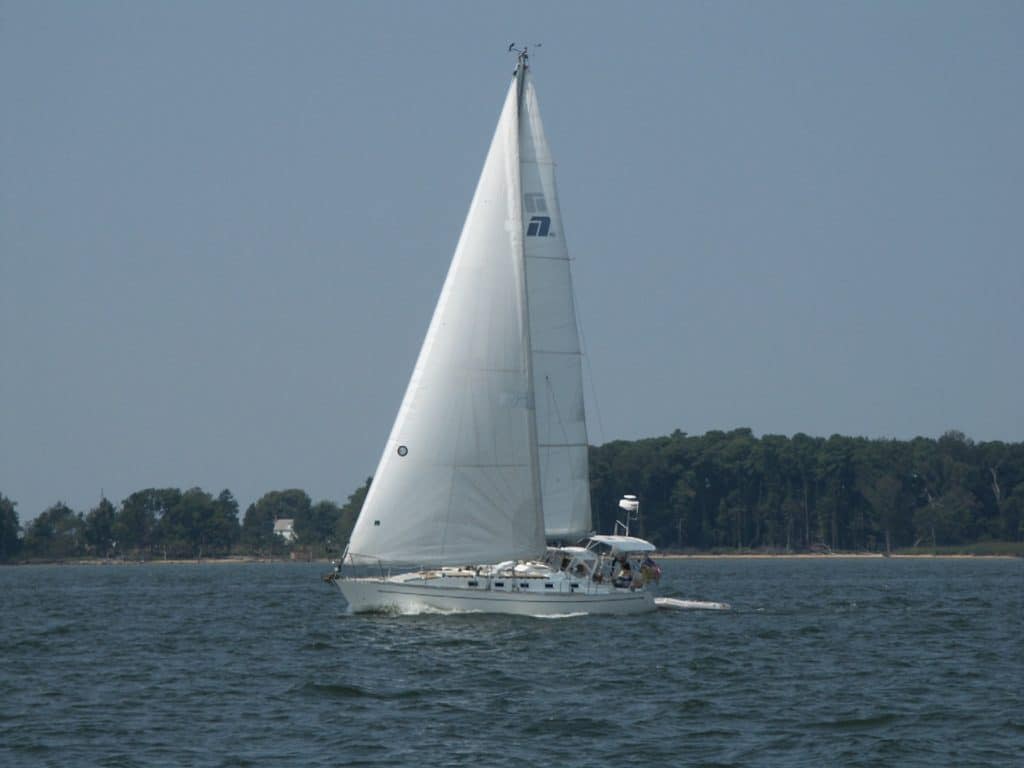
Any list of bluewater cruising sailboats must include a Robert Perry design. I could have easily put together nine Perry boats for this list. The Nordic 40 may surprise some, especially because 40 feet is an iconic length, bringing to mind such boats as the Valiant 40, Hinckley Bermuda 40, Bristol 40, Pacific Seacraft 40, Passport 40 and others. The trick is finding a 40-footer for less than $100,000. Nonetheless, the Nordic 40 and its larger sister ship, the 44, are among my favorite boats.
Based in Bellingham, Washington, Nordic produced world-class yachts during its brief production run in the 1980s. Only 40 Nordic 40s were launched between 1982 and 1987, but they’re worth seeking out on the used-boat market. The 40 features the classic double-ended Perry hull shape, with a fine entry, a deep and powerful fin keel, a skeg-mounted rudder positioned well aft, and a reverse transom. Freeboard is moderate and the sheer line is subtle, but to my eye, with its double-spreader rig and gently sloping deck line, the boat is poetry in the water.
The hull is solid fiberglass and the deck is balsa-cored, with solid laminates below loaded-up deck fittings. Original boats came with Navtec rod rigging and a hydraulic backstay, but many have been upgraded by now. Sail-control lines are led aft to the compact but functional T-shaped cockpit. The traveler is forward of the companionway, allowing for a cockpit dodger. The Nordic 40 is nimble in light to moderate breeze but can also stand up in a blow and heave to decently.
The interior is well suited to a cruising couple. It’s really a two-person boat, with a V-berth forward and large C-shaped galley aft, with plenty of counter space and a huge fridge. It includes the normal deft Perry touches — excellent sea berths, a separate stall shower and generous tankage. If you do find a Nordic 40 on the used market, be sure to take a hard look at the Westerbeke diesel and the V-drive transmission.
Pacific Seacraft 34
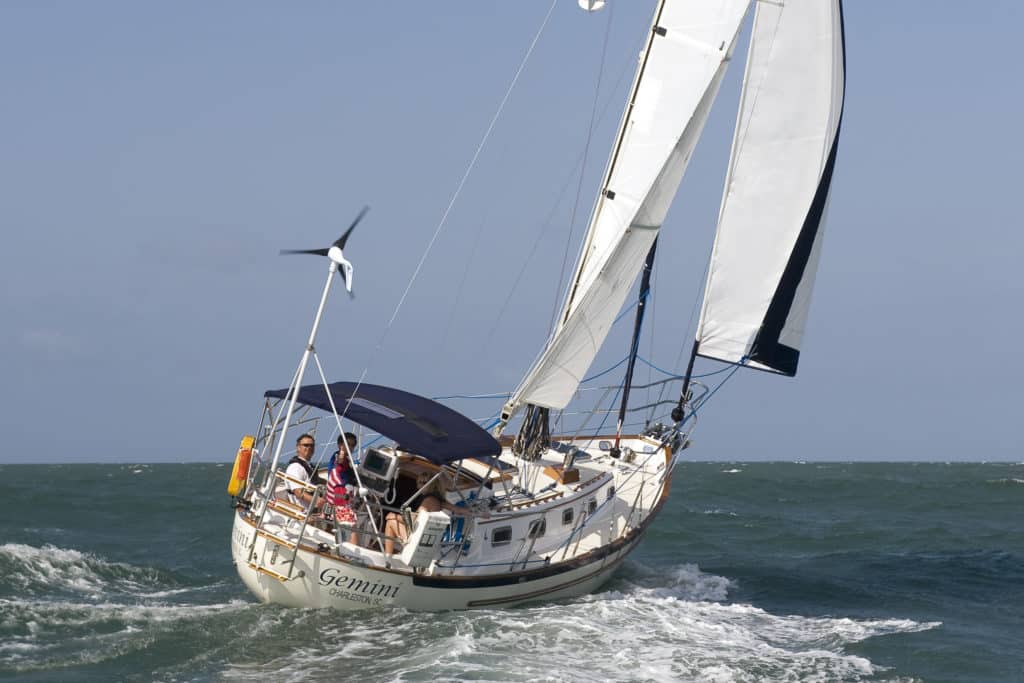
A handsome, nimble and capable double-ender by legendary designer Bill Crealock, the Pacific Seacraft 34 is well proven, with scores of ocean crossings in its wake.
After the boat was first launched as the Crealock 34 in 1979, Pacific Seacraft introduced a fifth model years later, a scaled-down version of the popular PS 37. Though expensive at the time, the 34 was another success story for one of America’s premier builders, and hundreds of boats were built in the company’s yard in Santa Ana, California. There is always a good selection of used boats available for less than $100,000. Another nice perk for used-boat buyers is that the 34 is back in production at the reincarnated Pacific Seacraft yard in Washington, North Carolina, providing an outlet for parts and advice. The company is now owned and operated by marine archaeologist Stephen Brodie and his father, Reid.
The 34 blends traditional values above the waterline with what was then a more modern underbody, with a long fin keel and skeg-hung rudder. A bit hefty at 13,500 pounds of displacement, the design otherwise is a study in moderation, and drawn with a keen eye toward providing a soft ride in a seaway and staying on good terms with Neptune in a blow.
The hull is solid fiberglass, and early decks were plywood-cored before Pacific switched to end-grain balsa. The hull-to-deck joint incorporates a molded bulwark that offers added security when you’re moving about on deck, and a vertical surface for mounting stanchions.
Most 34s are cutter-rigged for versatility but carry moderate-size genoas instead of high-cut yankees for more horsepower off the wind. Down below, the layout is traditional, but the 6-foot-4-inch headroom is a pleasant surprise. The Pacific Seacraft 34 is perfect for a cruising couple.
John Kretschmer is a delivery captain, adventurer and writer, whose own boat Quetzal , a 1987 Kaufman 47, has seen a refit or two over the years. His latest book is Sailing a Serious Ocean: Sailboats, Storms, Stories and Lessons Learned from 30 Years at Sea , also available on his website .
- More: classic plastic , DIY Sailboat Projects , Sailboat Reviews , Sailboats , used boat guide
- More Sailboats
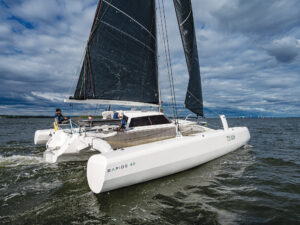
Sailboat Review: Rapido 40
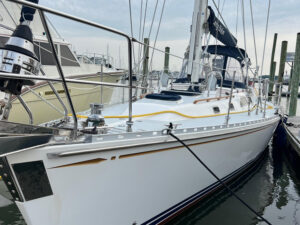
For Sale: 2002 Hylas 46
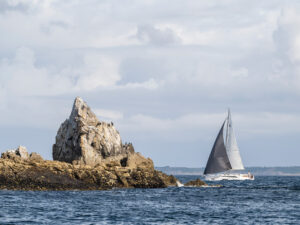
Sailboat Review: Beneteau Oceanis 37.1
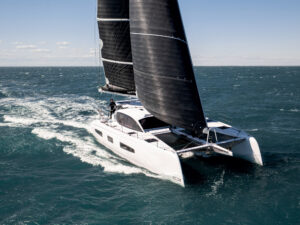
Sailboat Preview: Outremer 52
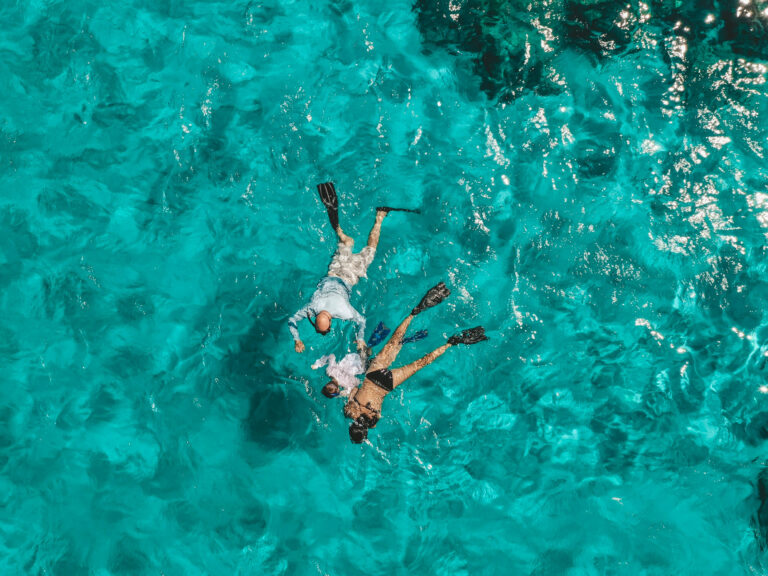
10 Gems of the BVI
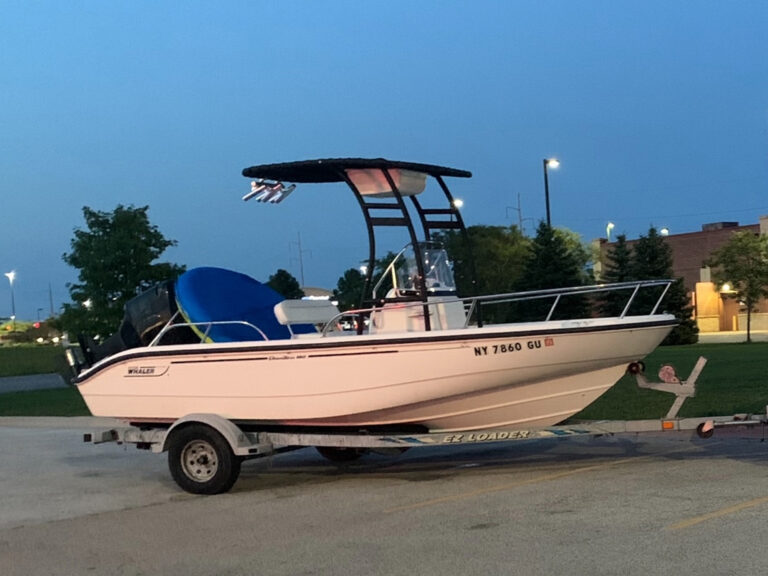
For Sale: A Freshwater Find
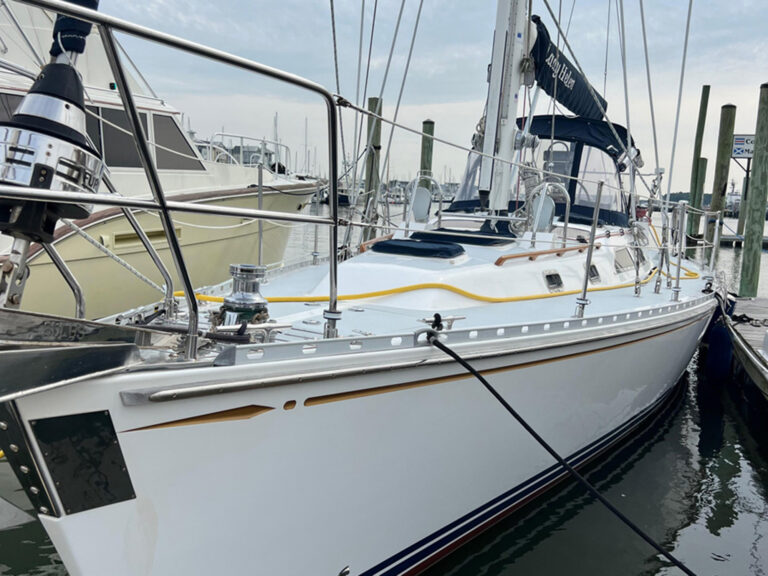
7 Boating Safety Tips for Summer Cruising
- Digital Edition
- Customer Service
- Privacy Policy
- Email Newsletters
- Cruising World
- Sailing World
- Salt Water Sportsman
- Sport Fishing
- Wakeboarding
Save 40% off! Join our newsletter and get 40% off right away!
Sailboat Life
Sailboat Cruising and Lifestyle Magazine.

How to Live on a Sailboat for Beginners

This is a guide for how to live on a sailboat – but be warned, if you have any desire for the liveaboard lifestyle, you might quickly become on of us! Living aboard a sailboat requires an enjoyment of water, being okay with small living, and a sense of adventure. It’s not hard to begin living on a sailboat, but a few tips can help.
Let’s consider a few basic liveaboard questions first:
Is it living on a sailboat a good idea?
Living aboard a sailboat give you freedom that you won’t find in any other lifestyle. A suburban house can not be moved from place to place. But living on a sailboat gives you the options to live anywhere – literally in any country in the world! Living aboard a sailboat offers such a unique feeling of freedom to explore that you won’t find anywhere else.
Is living on a sailboat hard?
It is tough to live on a sailboat in a place like San Francisco where everyone is trying to escape super-high rent. In resort areas, many marinas have years-long waitlists for a liveaboard slip, and these slips cost double than a regular slip. However, not all places, in fact most places are easy to liveaboard.
Are you thinking about living aboard? Well, it takes time, planning, and preparation to being living on a sailboat. Here are a few videos to help you make a few calculations.
Adjusting to Liveaboard Life
Today, Emily sits down with 3 other female friends in the harbor to chat about how they transitioned from being landlubbers to liveaboard sailors in recent years. We’ll let you in on the conversation, and 4 different perspectives (though there are MANY others in the world).
- Emily, 34, aboard Temptress – liveaboard for 5 years
- Kris, 57, aboard Sixth Girl – liveaboard for 1 year
- Meredith, 44, aboard Tla Hla – liveaboard for 3 years
- Hannah, 26, aboard Sojourner – liveaboard for 2 years
How to Afford and Start Living Aboard
Your dream is to become a liveaboard? You want to know more about sailboat life, and what it means to live on a sailboat? You want to know how to afford living on a sailboat and how to afford staying liveaboards? How it feels to daily hoist the sail and follow the wind?
Start Small, Start Now
One philosophy in getting started living aboard a sailboat is to start small, start now. That doesn’t mean you have to buy a major refit project of a sailboat. You can get started in a small 24 foot single cabin boat for less than $10,000 or a mid-size 36 foot sailboat (see video below) for less than $60,000. Or grab a 1980s fixer upper that’s 42 feet in length that costs $25,000 – but beware, a fixer upper is a major expense even when you do it yourself.
Is Living Aboard for You?
No one can answer this question except you. However, if you enjoy freedom, have a sense of adventure, and love the water, then you might enjoy living aboard a sailboat.
We hope you enjoyed this how to guide for life on a sailboat for beginners. Leave us a comment or question a below.
Share this post!
Throw in your two cents, start a discussion cancel reply, related articles.

The Voyage of the Sea Star – 35ft Sloop to Bermuda

Living Aboard a 30-36ft Sailboat: A Guide for the Curious and Adventurous

Summer Sailboat Video, Bikinis, Sails, and Fun

Saved Up For This Dream
Life on a Sailboat: Everything You Need to Know About Living on a Sailboat Full-Time
Living on a sailboat full-time is often romanticized as a life of endless sunsets, gentle waves, and freedom on the open sea. Many dream of casting off the lines and setting sail for a horizon of adventure and tranquility. However, the reality of life aboard a sailboat can be as challenging as it is rewarding, as frustrating as it is relaxing, and, more often than not, as mundane as it is exciting.
This blog post aims to peel back the curtain on the picturesque scenes to reveal what daily life is really like when you call a sailboat home. We will dive into the motivations, preparations, joys, and challenges of living on a sailboat full-time, providing a realistic glimpse into a lifestyle that is far from ordinary.
Our Live-Aboard Life
Our dream of living on a sailboat was a distant one for many years. But as we watched plans and dreams fall by the wayside in the wake of COVID, we made the decision to make our dream a reality. Once the borders opened up, we made a beeline for the Mediterranean and have since spent each summer living aboard our little 29-foot sailboat Whisper. Without any experience sailing or living on a sailboat, we have taught ourselves to sail and manage life on the boat along the way.
Before we took up sail life, we had been living “van life,” and we’ve come to realize there are lots of similarities but quite a few differences between the two . However, on the whole, learning to live van life first put us in good stead to take on life on a sailboat. Unlike most people, we up-sized when we moved onto a boat.
Despite the upgrade in living quarters, the learning curve and the adjustment to living on the sea were no less challenging. Nevertheless, the shift was not as scary as we thought it might be, and the reality of living on a sailboat full-time quickly became our new normal.
Initially, our plan was to buy a boat and spend one season aboard sailing the Mediterranean before selling the boat and settling down. Instead, it’s safe to say we have fallen in love with life on a sailboat. Now, as we enter our third season, we aren’t sure when we will be ready to furl the sails for good…
Get a Taste of Life on a SailBoat
We document some of the realities of living on a sailboat full-time on our YouTube Channel in our The Vanabond Sails series.
Deciding to Live on a Sailboat
The journey to becoming a full-time live aboard often starts with the desire for change.
Some people are transitioning from one stage of life to the next as careers wind up or children move out. Some yearn for adventure and excitement, while others seek a simpler way of life. Many are drawn to the promise of freedom, the allure of the sea, and the appeal of living more closely with nature. However, the decision to live on a sailboat full-time is not one to be taken lightly. It requires thoughtful consideration and planning.
For us, it was a long-held dream to sail and live aboard a sailboat. It was also a natural progression, having spent several years living and traveling by van . We were ready for a new challenge.
It began with a conversation, then a plan, and then trawling classifieds for second-hand boat sales. Before long, the decision was set in stone, and we were on our way to Croatia to buy a boat , learn to sail it, and move aboard.
Choosing the Right Sailboat
The type of sailboat you choose is critical and depends on your budget, sailing skills, and the kind of sailing you plan to do (coastal cruising, bluewater voyaging, etc.).
Will you prefer the size and stability of a catamaran, or will you prioritize the sailing experience of a monohull? Are you looking for something small that’s easily controlled and maneuvered by a limited (and potentially inexperienced) crew, or do you require the space of a larger vessel? Are you interested in the clean lines and comforts of modern boat designs, or do you prefer the style of older boats? There are a thousand decisions to be made when choosing a boat, and your own aspirations for boat life and, of course, your budget will be critical when it comes to making this decision.
Spend as much time researching boats that are available in your price range, ask questions of sailors you know or on sailing forums, and, if possible, spend time aboard different types of sailboats to get a clearer picture of what life is really like on board before making a purchase.
Check out our full article on buying boat .
Emotional and Practical Considerations for Sail Life
Living on a sailboat means embracing minimalism and being comfortable with the idea of having less space and possessions.
You’ll need to consider the impact of such a lifestyle on relationships with family and friends, as it can mean spending long periods away from loved ones.
The decision also involves considering how to manage work or income while living at sea , which might include remote work, seasonal jobs, or living off savings.
There are plenty of options for those planning on working remotely while sailing. With the rise of remote work , there has never been more opportunity to work and sail.
All of these considerations represent potential challenges to adjusting to life at sea, but they are certainly not insurmountable. You just need to be honest with yourself and decide if your love of the open water and the freedom of living aboard a sailboat will be greater than the inconveniences.
Preparations and Adjustments
Transitioning to life on a sailboat involves a series of preparations and adjustments, both practical and psychological, to ensure a smooth and sustainable living experience.
Training and Skills
If you are thinking about taking up sailing, you should, of course, invest time in learning to sail, navigate, and understand weather patterns. While this may seem like a daunting task, it’s not an insurmountable one. Time on the water is the most important thing, so it’s time to sign up for sailing courses, start planning trips with sailing friends, join a local sailing club, or seek out opportunities to crew for other sailors.
Learning basic boat maintenance and repair is essential to manage the myriad challenges that come with life at sea.
Safety courses, such as first aid, sea survival, and radio operation, are also crucial for handling emergencies.
These skills are important for safe and comfortable sailing and are often legally required. Make sure you are aware of the licensing and registration requirements for sailors in the region you are preparing to sail.
In our case, I had experience sailing small dinghies as a child and thus some understanding of the fundamentals, while Kelli had zero experience. My existing marine license issued in Australia was recognized in Croatia, where we bought our boat. I only needed to acquire a VHF radio license to become adequately certified for inshore sailing in the Mediterranean.
We paid some local sailors to come aboard and teach us both the fundamentals of our new boat (lots of docking and anchoring practice).
Downsizing and Adapting to Limited Space and Resources
As mentioned, moving onto a boat was actually upsizing for us. With a second cabin, a flushing toilet, and a large indoor table, our relatively small 29-foot monohull seemed luxurious compared to the vans we had been living in until this point.
However, for most, moving onto a sailboat often means significant downsizing, and space becomes a premium commodity. The process of downsizing for sail life involves prioritizing essential items and learning to live without the comforts of a traditional home.
Space isn’t the only limitation on a boat. Reliance on water tanks (if you don’t have a watermaker) and solar, wind, or generator electricity often means a downshift in access to creature comforts we take for granted in a house on the grid.
Creativity in organizing and making the most of limited space and resources becomes a daily practice, requiring innovative storage solutions and multi-functional furniture. Most modern sailboats are well-designed with endless space-saving measures and designs. Nevertheless, an adjustment will likely be necessary.
Financial Planning
Financial considerations are paramount, as the cost of living on a sailboat can vary widely depending on factors like marina fees, maintenance costs, and lifestyle choices.
Setting a realistic budget that includes regular maintenance, unexpected repairs, and living expenses is essential for sustaining life at sea.
Depending on your personal aspirations for boat life, this lifestyle can be as affordable or as expensive as you want to be. For us, as a couple in our thirties still in the building and saving part of our lives and careers, we are able to live on a boat in the Mediterranean affordably and comfortably for far less than we (estimate) we would spend living a more stationary lifestyle.
Check out our full article on the Costs of Living on Sail Boat Full-Time
Overall, adjusting to the confines and challenges of sailboat living demands not only physical preparation but also mental resilience and adaptability. The transition from land to sea is a profound shift, requiring a willingness to embrace simplicity, flexibility, and a sense of adventure.
Daily Life Aboard
While there is no typical day aboard, and experiences will differ wildly from person to person and day to day, we can describe what many of our days do look like.
As we work from the boat, our weeks are generally divided into work days, Monday to Friday morning and weekends. The truth is that the novelty does wear off, and many days, especially during the working week, become just as mundane as any other lifestyle. However it never stays mundane for long, one exhilarating sail, a dolphin sighting, a picture perfect anchorage or even surviving an impromptu weather event and the thrill of living on a sailboat quickly returns.
A typical workday for us living on a sailboat often starts with the sunrise (or a little bit before if we have a lot on). Ideally, we are well rested after a still night without rolling swell or, worse, strong wind, but that isn’t always assured at sea. Mornings involve checking the weather first and foremost, all plans revolve around the direction and strength of the wind and waves.
If the weather is calm, we usually try to work in the mornings when we are fresh and focused.
We travel slowly, often spending a few days in a quiet, well-protected anchorage, on a town quay, or in a marina before moving on a short distance along the coast. On sailing days, we often sail in the afternoon when the winds are a bit stronger in the Mediterranean. On days we are staying put, the afternoon might be spent exploring a new town, getting provisions, swimming, or finding a beach to lie on and read a book. In the evening, we will cook dinner onboard and get some more work done or watch some TV.
Weekends look different, and we will take advantage of not needing to be close to reliable network services, completing longer passages along the coast, or visiting islands.
Daily Differences in Sail Life
Living spaces on a sailboat are compact and multifunctional, necessitating an organized and tidy approach to prevent clutter and ensure safety. Cooking in a small galley kitchen presents its challenges, from securing pots and pans on a constantly moving boat to managing limited ingredients and storage.
Meals often need to be simple yet nutritious, requiring creativity and planning. Our approach is to cook simple, one-pot, vegetarian meals like dal or vegetable curry two or three times during the workweek and eat leftovers for lunch and dinner. On the weekend, we like to get more creative with our meals, seeking out local produce or fresh seafood and taking our time to prepare something special.
As mentioned, resource management is a critical aspect of daily sailboat life, especially when it comes to conserving water, fuel, and electricity. Efficient use of these resources is vital, whether it involves careful water usage, monitoring power consumption, or planning the next opportunity to resupply. For us, an electricity supply is mainly dependent on the sun when we are not under motor or plugged into shore power. Extended periods of cloud can alter our plans. Similarly, if we are not careful with water, more frequent visits to refill are required, which can be limiting.
Personal hygiene and privacy take on a new meaning in the confined space of a sailboat. Showers may be quick and infrequent. In our case, we generally rinse off after a swim to bathe and take proper showers during marina stops. Personal space is limited on a sailboat and managing personal relationships can have extra challenges.
Sleeping on the boat can take some getting used to, especially when on anchor. Even on a calm day, the constant rocking of the water can be disruptive at first, and novice sailors may find they get seasick, although these symptoms usually go away after a few days. When it’s windy, or there is some swell, the noise, movement, and the ever-present worry that the boat may pull off its anchor with the movement can make it very difficult to get a good night’s sleep.
Unforecast storms, gear failure, or some other emergency can occasionally create scary and challenging scenarios, especially if disaster strikes late at night. These situations are part of the adventure but can certainly be stressful.
Despite the challenges, daily life on a sailboat is interspersed with moments of profound beauty and peace. Whether watching dolphins play in the bow wave, enjoying a sunset over the ocean, or stargazing on a clear night, these experiences often make the hardships worthwhile, offering a sense of freedom and connection to nature that is hard to find elsewhere.
The Pros and Cons of Living on a Sailboat Full-Time
Pros: the joys of sailboat living.
Living on a sailboat brings a unique set of joys and rewards that can make the challenges seem insignificant.
+ One of the most significant benefits is the sense of freedom and adventure. Sailboat dwellers have the luxury of exploring new destinations, anchoring in secluded bays, and experiencing different cultures in a way that most people never will. The ability to call a variety of picturesque locations home, even if only temporarily, is a remarkable aspect of this lifestyle. Even compared to other forms of nomadic lifestyle, waking up in your own private bay or cove is hard to re-create.
+ The connection with nature is unparalleled in sailboat living. Being surrounded by the vastness of the ocean, witnessing marine life up close, and experiencing the rhythms of the sea create a deep sense of harmony and peace. The simplicity of life on a boat can lead to a greater appreciation for the small things, like the beauty of a sunset, the changing colors of the sea, or the silence of a night watch under the stars.
+ Community and camaraderie are also central to the sailboat lifestyle. The sailing community is known for its close-knit, supportive nature, with fellow sailors often ready to lend a hand, share advice, or offer companionship. This sense of community extends across harbors and anchorages around the world, creating a global network of friends and contacts.
+ The personal growth and self-reliance developed through sailboat living are profound. Navigating the challenges and unpredictability of the sea fosters resilience, problem-solving skills, and a strong sense of self-confidence. The lifestyle encourages continuous learning, from mastering sailing and navigational skills to understanding weather patterns and marine ecosystems.
The Cons: The Challenges and Hardships of Liveaboard Life
While the joys of living on a sailboat are plentiful, the lifestyle also comes with its fair share of challenges and hardships. These difficulties test the resilience and adaptability of those who choose this way of life.
– One of the most significant challenges is dealing with bad weather. Storms, high winds, and rough seas can be terrifying and dangerous, requiring skill, experience (which you can only get by …experiencing it), and a calm demeanor to navigate safely (perhaps the trickiest thing to achieve). The stress from poor weather can be mentally draining, disrupt work, and put a strain on relationships.
– The learning curve required to become a confident and comfortable sailor is not small and can take many seasons while mastering sailing can take a lifetime.
– The constant exposure to the elements also means that maintenance is a never-ending task, with saltwater and sun causing wear and tear that must be regularly addressed to keep the boat functional and safe. Especially on an older boat like ours, fixing and maintaining gear and rigging is an endless cycle. Most systems and hardware on the boat are essential, and when they fail, there is often no one around to help. Constantly sorting out jammed anchors, engine or electrical issues can quickly become tiresome and (if you are trying to work) quite disruptive. It can also be quite stressful when critical systems fail.
– Isolation is another aspect of sailboat living that can be challenging. Long periods at sea or anchored in remote locations can lead to feelings of loneliness and disconnection from land-based communities. The confined space of a sailboat can strain relationships, making it essential for the crew, be it a couple, a family, or friends, to communicate effectively and give each other personal space.
– The financial aspect of sailboat living can also be a hardship. Unexpected repairs and maintenance can quickly drain savings, and the cost of mooring, fuel, and supplies can add up. Sailors must be adept at budgeting and often need to be resourceful in finding ways to sustain their lifestyle, which might include picking up temporary jobs or remote work.
– The physical demands of managing a sailboat should not be underestimated. It requires strength, stamina, and a willingness to tackle everything from sail repairs to engine troubleshooting. The learning curve can be steep, and the responsibility of keeping the boat and its occupants safe is a constant pressure.
Despite these challenges, many sailboat dwellers find that the hardships are part of what makes the lifestyle rewarding. Overcoming difficulties and learning to live in harmony with the sea can provide a profound sense of achievement and satisfaction.
Final Thoughts About Life on a Sailboat
Living on a sailboat full-time is a journey that encompasses the full spectrum of human experience, blending moments of sheer joy and beauty with times of challenge and adversity. It’s a lifestyle that demands resilience, adaptability, and a willingness to embrace the unknown. While the romantic allure of sailing the high seas is undeniable, the realities of daily life on a sailboat are grounded in practical challenges and the necessity of continual learning and personal growth.
The decision to live on a sailboat should not be made lightly, as it involves significant changes in lifestyle, mindset, and social dynamics. However, for those who choose to embark on this adventure, it offers unparalleled opportunities for freedom, exploration, and connection with nature. The hardships encountered along the way are not just obstacles but also catalysts for growth, leading to a deeper understanding of oneself and the world.
If you have a question about living on a sailboat full-time, let us know in the comments below or shoot us an email anytime!
Fair winds and following seas!
In 2016, I had been dumped by my girlfriend, fired from my job, and the lease on my house was running out. Facing moving back in with my parents, 26, jobless and alone I decided to listen to the message the universe was trying to send me. I took off on my first solo backpacking trip, with a one-way ticket to Bangkok and a well-thumbed Lonely Planet guide. From there I wandered Southeast and Central Asia, traveled the Great Steppe, and made my way across Russia and throughout Europe.
In Estonia I met Kelli, who, despite having a less frantic travel style, shared my my restless spirit and passion for exploration. Together, we embarked on a new journey, van life. Over four years we travelled across three different continents with three different vans.
In 2022, as the world began to re-open post COVID we took an opportunity to realise a long held dream, to live aboard a sailboat. Since then we have spent two summers in the Mediterranean, sailing and living aboard our little sail boat Whisper. When we aren't sailing we continue to live our nomadic lifestyle, guided by a philosophy of slow travel and self directed adventure be it by van or backpacking.
We find excitement through our journey into the unknown, stillness and content in the beauty of the places we discover and we find ourselves in the vastness of our world.
Hopefully, we can help you find what you're looking for too. Get lost with us and find your own path.

Leave a Reply Cancel reply
Your email address will not be published. Required fields are marked *
- Yachting World
- Digital Edition

43 of the best bluewater sailboat designs of all time
- January 5, 2022
How do you choose the right yacht for you? We highlight the very best bluewater sailboat designs for every type of cruising

Which yacht is the best for bluewater boating? This question generates even more debate among sailors than questions about what’s the coolest yacht , or the best for racing. Whereas racing designs are measured against each other, cruising sailors get very limited opportunities to experience different yachts in real oceangoing conditions, so what is the best bluewater sailboat?
Here, we bring you our top choices from decades of designs and launches. Over the years, the Yachting World team has sailed these boats, tested them or judged them for European Yacht of the Year awards, and we have sifted through the many to curate a selection that we believe should be on your wishlist.
Making the right choice may come down to how you foresee your yacht being used after it has crossed an ocean or completed a passage: will you be living at anchor or cruising along the coast? If so, your guiding requirements will be space, cabin size, ease of launching a tender and anchoring closer to shore, and whether it can comfortably accommodate non-expert-sailor guests.
Article continues below…

The perfect boat: what makes an ideal offshore cruising yacht?
Choosing a boat for offshore cruising is not a decision to be taken lightly. I have researched this topic on…

European Yacht of the Year 2019: Best luxury cruisers
Before the sea trials began, I would have put money on a Hallberg-Rassy or the Wauquiez winning an award. The…
All of these considerations have generated the inexorable rise of the bluewater catamaran – monohulls can’t easily compete on these points. We have a full separate feature on the best bluewater multihulls of all time and here we mostly focus on monohulls. The only exceptions to that rule are two multihulls which made it into our best bluewater sailboats of 2022 list.
As so much of making the right choice is selecting the right boat for the venture in mind, we have separated out our edit into categories: best for comfort; for families; for performance; and for expedition or high latitudes sailing .
Best bluewater sailboats of 2022
The new flagship Allures 51.9, for example, is a no-nonsense adventure cruising design built and finished to a high standard. It retains Allures’ niche of using aluminium hulls with glassfibre decks and superstructures, which, the yard maintains, gives the optimum combination of least maintenance and less weight higher up. Priorities for this design were a full beam aft cabin and a spacious, long cockpit. Both are excellent, with the latter, at 6m long, offering formidable social, sailing and aft deck zones.
It likes some breeze to come to life on the wheel, but I appreciate that it’s designed to take up to five tonnes payload. And I like the ease with which you can change gears using the furling headsails and the positioning of the powerful Andersen winches inboard. The arch is standard and comes with a textile sprayhood or hard bimini.
Below decks you’ll find abundant headroom and natural light, a deep U-shape galley and cavernous stowage. For those who like the layout of the Amel 50 but would prefer aluminium or shoal draught, look no further.
Allures 51.9 price: €766,000
The Ovni 370 is another cunning new aluminum centreboard offering, a true deck saloon cruiser for two. The designers say the biggest challenge was to create a Category A ocean going yacht at this size with a lifting keel, hence the hull had to be very stable.
Enjoyable to helm, it has a practical, deep cockpit behind a large sprayhood, which can link to the bimini on the arch. Many of its most appealing features lie in the bright, light, contemporary, clever, voluminous interior, which has good stowage and tankage allocation. There’s also a practical navstation, a large workroom and a vast separate shower. I particularly like the convertible saloom, which can double as a large secure daybed or pilot berth.
Potentially the least expensive Category A lift keel boat available, the Ovni will get you dreaming of remote places again.
Ovni 370 price: €282,080

There’s no shortage of spirit in the Windelo 50. We gave this a sustainability award after it’s founders spent two years researching environmentally-friendly composite materials, developing an eco-composite of basalt fibre and recycled PET foam so it could build boats that halve the environmental impact of standard glassfibre yachts.
The Windelo 50 is an intriguing package – from the styling, modular interior and novel layout to the solar field on the roof and the standard electric propulsion, it is completely fresh.
Windelo 50 price: €795,000
Best bluewater sailboat of 2022 – Outremer 55
I would argue that this is the most successful new production yacht on the market. Well over 50 have already sold (an equipped model typically costs €1.6m) – and I can understand why. After all, were money no object, I had this design earmarked as the new yacht I would most likely choose for a world trip.
Indeed 55 number one Sanya, was fully equipped for a family’s world cruise, and left during our stay for the Grand Large Odyssey tour. Whereas we sailed Magic Kili, which was tricked up with performance options, including foam-cored deckheads and supports, carbon crossbeam and bulkheads, and synthetic rigging.
At rest, these are enticing space ships. Taking one out to sea is another matter though. These are speed machines with the size, scale and loads to be rightly weary of. Last month Nikki Henderson wrote a feature for us about how to manage a new breed of performance cruising cats just like this and how she coaches new owners. I could not think of wiser money spent for those who do not have ample multihull sailing experience.
Under sail, the most fun was obviously reserved for the reaching leg under asymmetric, where we clocked between 11-16 knots in 15-16 knots wind. But it was the stability and of those sustained low teen speeds which really hit home – passagemaking where you really cover miles.
Key features include the swing helms, which give you views from outboard, over the coachroof or from a protected position in the cockpit through the coachroof windows, and the vast island in the galley, which is key to an open plan main living area. It helps provide cavernous stowage and acts as the heart of the entertaining space as it would in a modern home. As Danish judge Morten Brandt-Rasmussen comments: “Apart from being the TGV of ocean passages the boat offers the most spacious, open and best integration of the cockpit and salon areas in the market.”
Outremer has done a top job in packing in the creature comforts, stowage space and payload capacity, while keeping it light enough to eat miles. Although a lot to absorb and handle, the 55 offers a formidable blend of speed and luxury cruising.
Outremer 55 price: €1.35m
Best bluewater sailboats for comfort
This is the successor to the legendary Super Maramu, a ketch design that for several decades defined easy downwind handling and fostered a cult following for the French yard. Nearly a decade old, the Amel 55 is the bridge between those world-girdling stalwarts and Amel’s more recent and totally re-imagined sloop designs, the Amel 50 and 60.
The 55 boasts all the serious features Amel aficionados loved and valued: a skeg-hung rudder, solidly built hull, watertight bulkheads, solid guardrails and rampart bulwarks. And, most noticeable, the solid doghouse in which the helmsman sits in perfect shelter at the wheel.
This is a design to live on comfortably for long periods and the list of standard features just goes on and on: passarelle; proper sea berths with lee cloths; electric furling main and genoa; and a multitude of practical items that go right down to a dishwasher and crockery.
There’s no getting around the fact these designs do look rather dated now, and through the development of easier sail handling systems the ketch rig has fallen out of fashion, but the Amel is nothing short of a phenomenon, and if you’ve never even peeked on board one, you really have missed a treat.

Photo: Sander van der Borch
Contest 50CS
A centre cockpit cruiser with true longevity, the Contest 50CS was launched by Conyplex back in 2003 and is still being built by the family-owned Dutch company, now in updated and restyled form.
With a fully balanced rudder, large wheel and modern underwater sections, the Contest 50CS is a surprisingly good performer for a boat that has a dry weight of 17.5 tonnes. Many were fitted with in-mast furling, which clearly curtails that performance, but even without, this boat is set up for a small crew.
Electric winches and mainsheet traveller are all easy to reach from the helm. On our test of the Contest 50CS, we saw for ourselves how two people can gybe downwind under spinnaker without undue drama. Upwind, a 105% genoa is so easy to tack it flatters even the weediest crewmember.
Down below, the finish level of the joinery work is up there among the best and the interior is full of clever touches, again updated and modernised since the early models. Never the cheapest bluewater sailing yacht around, the Contest 50CS has remained in demand as a brokerage buy. She is a reassuringly sure-footed, easily handled, very well built yacht that for all those reasons has stood the test of time.
This is a yacht that would be well capable of helping you extend your cruising grounds, almost without realising it.
Read more about the Contest 50CS and the new Contest 49CS

Photo: Rick Tomlinson
Hallberg-Rassy 48 Mk II
For many, the Swedish Hallberg-Rassy yard makes the quintessential bluewater cruiser for couples. With their distinctive blue cove line, these designs are famous for their seakindly behaviour, solid-as-a-rock build and beautifully finished, traditional interiors.
To some eyes, Hallberg-Rassys aren’t quite cool enough, but it’s been company owner Magnus Rassy’s confidence in the formula and belief in incremental ‘step-by-step’ evolution that has been such an exceptional guarantor of reliable quality, reputation and resale value.
The centre cockpit Hallberg-Rassy 48 epitomises the concept of comfort at sea and, like all the Frers-designed Hallberg-Rassys since the 1990s, is surprisingly fleet upwind as well as steady downwind. The 48 is perfectly able to be handled by a couple (as we found a few years back in the Pacific), and could with no great effort crack out 200-mile days.
The Hallberg-Rassy 48 was launched nearly a decade ago, but the Mk II from 2014 is our pick, updated with a more modern profile, larger windows and hull portlights that flood the saloon and aft cabin with light. With a large chart table, secure linear galley, heaps of stowage and space for bluewater extras such as machinery and gear, this yacht pretty much ticks all the boxes.

Discovery 55
First launched in 2000, the Discovery 55 has stood the test of time. Designed by Ron Holland, it hit a sweet spot in size that appealed to couples and families with world girdling plans.
Elegantly styled and well balanced, the 55 is also a practical design, with a deep and secure cockpit, comfortable seating, a self-tacking jib, dedicated stowage for the liferaft , a decent sugar scoop transom that’s useful for swimming or dinghy access, and very comfortable accommodation below. In short, it is a design that has been well thought out by those who’ve been there, got the bruises, stubbed their toes and vowed to change things in the future if they ever got the chance.
Throughout the accommodation there are plenty of examples of good detailing, from the proliferation of handholds and grabrails, to deep sinks in the galley offering immediate stowage when under way and the stand up/sit down showers. Stowage is good, too, with plenty of sensibly sized lockers in easily accessible positions.
The Discovery 55 has practical ideas and nifty details aplenty. She’s not, and never was, a breakthrough in modern luxury cruising but she is pretty, comfortable to sail and live on, and well mannered.

Photo: Latitudes Picture Library
You can’t get much more Cornish than a Rustler. The hulls of this Stephen Jones design are hand-moulded and fitted out in Falmouth – and few are more ruggedly built than this traditional, up-for-anything offshore cruiser.
She boasts an encapsulated lead keel, eliminating keel bolts and creating a sump for generous fuel and water tankage, while a chunky skeg protects the rudder. She is designed for good directional stability and load carrying ability. These are all features that lend this yacht confidence as it shoulders aside the rough stuff.
Most of those built have had a cutter rig, a flexible arrangement that makes sense for long passages in all sea and weather conditions. Down below, the galley and saloon berths are comfortable and sensible for living in port and at sea, with joinery that Rustler’s builders are rightly proud of.
As modern yachts have got wider, higher and fatter, the Rustler 42 is an exception. This is an exceptionally well-mannered seagoing yacht in the traditional vein, with elegant lines and pleasing overhangs, yet also surprisingly powerful. And although now over 20 years old, timeless looks and qualities mean this design makes her look ever more like a perennial, a modern classic.
The definitive crossover size, the point at which a yacht can be handled by a couple but is just large enough to have a professional skipper and be chartered, sits at around the 60ft mark. At 58ft 8in, the Oyster 575 fitted perfectly into this growing market when launched in 2010. It went on to be one of the most popular models from the yard, and is only now being superseded by the newer Rob Humphreys-designed Oyster 565 (just launched this spring).
Built in various configurations with either a deep keel, shoal draught keel or centreboard with twin rudders, owners could trade off better performance against easy access to shallower coves and anchorages. The deep-bodied hull, also by Rob Humphreys, is known for its easy motion at sea.
Some of the Oyster 575’s best features include its hallmark coachroof windows style and centre cockpit – almost everyone will know at first glance this is an Oyster – and superb interior finish. If she has a flaw, it is arguably the high cockpit, but the flip side is the galley headroom and passageway berth to the large aft stateroom.
This design also has a host of practical features for long-distance cruising, such as high guardrails, dedicated liferaft stowage, a vast lazarette for swallowing sails, tender, fenders etc, and a penthouse engine room.

Privilege Serie 5
A true luxury catamaran which, fully fitted out, will top €1m, this deserves to be seen alongside the likes of the Oyster 575, Gunfleet 58 and Hallberg-Rassy 55. It boasts a large cockpit and living area, and a light and spacious saloon with an emphasis on indoor-outdoor living, masses of refrigeration and a big galley.
Standout features are finish quality and solid build in a yacht designed to take a high payload, a secure walkaround deck and all-round views from the helm station. The new Privilege 510 that will replace this launches in February 2020.
Gunfleet 43
It was with this Tony Castro design that Richard Matthews, founder of Oyster Yachts, launched a brand new rival brand in 2012, the smallest of a range stretching to the flagship Gunfleet 74. The combination of short overhangs and centre cockpit at this size do make the Gunfleet 43 look modern if a little boxy, but time and subsequent design trends have been kind to her lines, and the build quality is excellent. The saloon, galley and aft cabin space is exceptional on a yacht of this size.

Photo: David Harding
Conceived as a belt-and-braces cruiser, the Kraken 50 launched last year. Its unique points lie underwater in the guise of a full skeg-hung rudder and so-called ‘Zero Keel’, an encapsulated long keel with lead ballast.
Kraken Yachts is the brainchild of British businessman and highly experienced cruiser Dick Beaumont, who is adamant that safety should be foremost in cruising yacht design and build. “There is no such thing as ‘one yacht for all purposes’… You cannot have the best of all worlds, whatever the salesman tells you,” he says.
Read our full review of the Kraken 50 .

Wauquiez Centurion 57
Few yachts can claim to be both an exciting Med-style design and a serious and practical northern European offshore cruiser, but the Wauquiez Centurion 57 tries to blend both. She slightly misses if you judge solely by either criterion, but is pretty and practical enough to suit her purpose.
A very pleasant, well-considered yacht, she is impressively built and finished with a warm and comfortable interior. More versatile than radical, she could be used for sailing across the Atlantic in comfort and raced with equal enjoyment at Antigua Sailing Week .

A modern classic if ever there was one. A medium to heavy displacement yacht, stiff and easily capable of standing up to her canvas. Pretty, traditional lines and layout below.

Photo: Voyage of Swell
Well-proven US legacy design dating back to the mid-1960s that once conquered the Transpac Race . Still admired as pretty, with slight spoon bow and overhanging transom.

Capable medium displacement cruiser, ideal size and good accommodation for couples or family cruising, and much less costly than similar luxury brands.

Photo: Peter Szamer
Swedish-built aft cockpit cruiser, smaller than many here, but a well-built and finished, super-durable pocket ocean cruiser.

Tartan 3700
Designed as a performance cruiser there are nimbler alternatives now, but this is still an extremely pretty yacht.
Broker ’ s choice

Discovery 55 Brizo
This yacht has already circumnavigated the globe and is ‘prepared for her next adventure,’ says broker Berthon. Price: £535,000 + VAT

Oyster 575 Ayesha
‘Stunning, and perfectly equipped for bluewater cruising,’ says broker Ancasta International. Price: £845,000 (tax not paid)

Oyster 575 Pearls of Nautilus
Nearly new and with a high spec, this Oyster Brokerage yacht features American white oak joinery and white leather upholstery and has a shoal draught keel. Price: $1.49m
Best bluewater yachts for performance
The Frers-designed Swan 54 may not be the newest hull shape but heralded Swan’s latest generation of displacement bluewater cruisers when launched four years ago. With raked stem, deep V hull form, lower freeboard and slight curve to the topsides she has a more timeless aesthetic than many modern slab-sided high volume yachts, and with that a seakindly motion in waves. If you plan to cover many miles to weather, this is probably the yacht you want to be on.

Photo: Carlo Borlenghi
Besides Swan’s superlative build quality, the 54 brings many true bluewater features, including a dedicated sail locker. There’s also a cockpit locker that functions as a utility cabin, with potential to hold your generator and washing machine, or be a workshop space.
The sloping transom opens out to reveal a 2.5m bathing platform, and although the cabins are not huge there is copious stowage space. Down below the top-notch oak joinery is well thought through with deep fiddles, and there is a substantial nav station. But the Swan 54 wins for handling above all, with well laid-out sail controls that can be easily managed between a couple, while offering real sailing enjoyment to the helmsman.

Photo: Graham Snook
The Performance Cruiser winner at the 2019 European Yacht of the Year awards, the Arcona 435 is all about the sailing experience. She has genuine potential as a cruiser-racer, but her strengths are as an enjoyable cruiser rather than a full-blown liveaboard bluewater boat.
Build quality is excellent, there is the option of a carbon hull and deck, and elegant lines and a plumb bow give the Arcona 435 good looks as well as excellent performance in light airs. Besides slick sail handling systems, there are well thought-out features for cruising, such as ample built-in rope bins and an optional semi-closed stern with stowage and swim platform.

Outremer 51
If you want the space and stability of a cat but still prioritise sailing performance, Outremer has built a reputation on building catamarans with true bluewater characteristics that have cruised the planet for the past 30 years.
Lighter and slimmer-hulled than most cruising cats, the Outremer 51 is all about sailing at faster speeds, more easily. The lower volume hulls and higher bridgedeck make for a better motion in waves, while owners report that being able to maintain a decent pace even under reduced canvas makes for stress-free passages. Deep daggerboards also give good upwind performance.
With bucket seats and tiller steering options, the Outremer 51 rewards sailors who want to spend time steering, while they’re famously well set up for handling with one person on deck. The compromise comes with the interior space – even with a relatively minimalist style, there is less cabin space and stowage volume than on the bulkier cats, but the Outremer 51 still packs in plenty of practical features.

The Xc45 was the first cruising yacht X-Yachts ever built, and designed to give the same X-Yachts sailing experience for sailors who’d spent years racing 30/40-footer X- and IMX designs, but in a cruising package.
Launched over 10 years ago, the Xc45 has been revisited a few times to increase the stowage and modernise some of the styling, but the key features remain the same, including substantial tanks set low for a low centre of gravity, and X-Yachts’ trademark steel keel grid structure. She has fairly traditional styling and layout, matched with solid build quality.
A soft bilge and V-shaped hull gives a kindly motion in waves, and the cockpit is secure, if narrow by modern standards.

A three or four cabin catamaran that’s fleet of foot with high bridgedeck clearance for comfortable motion at sea. With tall daggerboards and carbon construction in some high load areas, Catana cats are light and quick to accelerate.

Sweden Yachts 45
An established bluewater design that also features in plenty of offshore races. Some examples are specced with carbon rig and retractable bowsprits. All have a self-tacking jib for ease. Expect sweeping areas of teak above decks and a traditionally wooded interior with hanging wet locker.

A vintage performer, first launched in 1981, the 51 was the first Frers-designed Swan and marked a new era of iconic cruiser-racers. Some 36 of the Swan 51 were built, many still actively racing and cruising nearly 40 years on. Classic lines and a split cockpit make this a boat for helming, not sunbathing.

Photo: Julien Girardot / EYOTY
The JPK 45 comes from a French racing stable, combining race-winning design heritage with cruising amenities. What you see is what you get – there are no superfluous headliners or floorboards, but there are plenty of ocean sailing details, like inboard winches for safe trimming. The JPK 45 also has a brilliantly designed cockpit with an optional doghouse creating all-weather shelter, twin wheels and superb clutch and rope bin arrangement.

Photo: Andreas Lindlahr
For sailors who don’t mind exchanging a few creature comforts for downwind planing performance, the Pogo 50 offers double-digit surfing speeds for exhilarating tradewind sailing. There’s an open transom, tiller steering and no backstay or runners. The Pogo 50 also has a swing keel, to nose into shallow anchorages.

Seawind 1600
Seawinds are relatively unknown in Europe, but these bluewater cats are very popular in Australia. As would be expected from a Reichel-Pugh design, this 52-footer combines striking good looks and high performance, with fine entry bows and comparatively low freeboard. Rudders are foam cored lifting designs in cassettes, which offer straightforward access in case of repairs, while daggerboards are housed under the deck.
Best bluewater sailboats for families
It’s unsurprising that, for many families, it’s a catamaran that meets their requirements best of increased space – both living space and separate cabins for privacy-seeking teenagers, additional crew or visiting family – as well as stable and predictable handling.

Photo: Nicholas Claris
Undoubtedly one of the biggest success stories has been the Lagoon 450, which, together with boats like the Fountaine Pajot 44, helped drive up the popularity of catamaran cruising by making it affordable and accessible. They have sold in huge numbers – over 1,000 Lagoon 450s have been built since its launch in 2010.
The VPLP-designed 450 was originally launched with a flybridge with a near central helming position and upper level lounging areas (450F). The later ‘sport top’ option (450S) offered a starboard helm station and lower boom (and hence lower centre of gravity for reduced pitching). The 450S also gained a hull chine to create additional volume above the waterline. The Lagoon features forward lounging and aft cockpit areas for additional outdoor living space.
Besides being a big hit among charter operators, Lagoons have proven themselves over thousands of bluewater miles – there were seven Lagoon 450s in last year’s ARC alone. In what remains a competitive sector of the market, Lagoon has recently launched a new 46, with a larger self-tacking jib and mast moved aft, and more lounging areas.

Photo: Gilles Martin-Raget
Fountaine Pajot Helia 44
The FP Helia 44 is lighter, lower volume, and has a lower freeboard than the Lagoon, weighing in at 10.8 tonnes unloaded (compared to 15 for the 450). The helm station is on a mezzanine level two steps up from the bridgedeck, with a bench seat behind. A later ‘Evolution’ version was designed for liveaboard cruisers, featuring beefed up dinghy davits and an improved saloon space.
Available in three or four cabin layouts, the Helia 44 was also popular with charter owners as well as families. The new 45 promises additional volume, and an optional hydraulically lowered ‘beach club’ swim platform.

Photo: Arnaud De Buyzer / graphikup.com
The French RM 1370 might be less well known than the big brand names, but offers something a little bit different for anyone who wants a relatively voluminous cruising yacht. Designed by Marc Lombard, and beautifully built from plywood/epoxy, the RM is stiff and responsive, and sails superbly.
The RM yachts have a more individual look – in part down to the painted finish, which encourages many owners to personalise their yachts, but also thanks to their distinctive lines with reverse sheer and dreadnought bow. The cockpit is well laid out with the primary winches inboard for a secure trimming position. The interior is light, airy and modern, although the open transom won’t appeal to everyone.
For those wanting a monohull, the Hanse 575 hits a similar sweet spot to the popular multis, maximising accommodation for a realistic price, yet with responsive performance.
The Hanse offers a vast amount of living space thanks to the ‘loft design’ concept of having all the living areas on a single level, which gives a real feeling of spaciousness with no raised saloon or steps to accommodation. The trade-off for such lofty head height is a substantial freeboard – it towers above the pontoon, while, below, a stepladder is provided to reach some hatches.
Galley options include drawer fridge-freezers, microwave and coffee machine, and the full size nav station can double up as an office or study space.
But while the Hanse 575 is a seriously large boat, its popularity is also down to the fact that it is genuinely able to be handled by a couple. It was innovative in its deck layout: with a self-tacking jib and mainsheet winches immediately to hand next to the helm, one person could both steer and trim.
Direct steering gives a feeling of control and some tangible sailing fun, while the waterline length makes for rapid passage times. In 2016 the German yard launched the newer Hanse 588 model, having already sold 175 of the 575s in just four years.

Photo: Bertel Kolthof
Jeanneau 54
Jeanneau leads the way among production builders for versatile all-rounder yachts that balance sail performance and handling, ergonomics, liveaboard functionality and good looks. The Jeanneau 54 , part of the range designed by Philippe Briand with interior by Andrew Winch, melds the best of the larger and smaller models and is available in a vast array of layout options from two cabins/two heads right up to five cabins and three heads.
We’ve tested the Jeanneau 54 in a gale and very light winds, and it acquitted itself handsomely in both extremes. The primary and mainsheet winches are to hand next to the wheel, and the cockpit is spacious, protected and child-friendly. An electric folding swim and sun deck makes for quick fun in the water.

Nautitech Open 46
This was the first Nautitech catamaran to be built under the ownership of Bavaria, designed with an open-plan bridgedeck and cockpit for free-flowing living space. But with good pace for eating up bluewater miles, and aft twin helms rather than a flybridge, the Nautitech Open 46 also appeals to monohull sailors who prefer a more direct sailing experience.

Made by Robertson and Caine, who produce catamarans under a dual identity as both Leopard and the Sunsail/Moorings charter cats, the Leopard 45 is set to be another big seller. Reflecting its charter DNA, the Leopard 45 is voluminous, with stepped hulls for reduced waterline, and a separate forward cockpit.
Built in South Africa, they are robustly tested off the Cape and constructed ruggedly enough to handle heavy weather sailing as well as the demands of chartering.

Photo: Olivier Blanchet
If space is king then three hulls might be even better than two. The Neel 51 is rare as a cruising trimaran with enough space for proper liveaboard sailing. The galley and saloon are in the large central hull, together with an owner’s cabin on one level for a unique sensation of living above the water. Guest or family cabins lie in the outer hulls for privacy and there is a cavernous full height engine room under the cabin sole.
Performance is notably higher than an equivalent cruising cat, particularly in light winds, with a single rudder giving a truly direct feel in the helm, although manoeuvring a 50ft trimaran may daunt many sailors.

Beneteau Oceanis 46.1
A brilliant new model from Beneteau, this Finot Conq design has a modern stepped hull, which offers exhilarating and confidence-inspiring handling in big breezes, and slippery performance in lighter winds.
The Beneteau Oceanis 46.1 was the standout performer at this year’s European Yacht of the Year awards, and, in replacing the popular Oceanis 45, looks set to be another bestseller. Interior space is well used with a double island berth in the forepeak. An additional inboard unit creates a secure galley area, but tank capacity is moderate for long periods aboard.

Beneteau Oceanis 473
A popular model that offers beam and height in a functional layout, although, as with many boats of this age (she was launched in 2002), the mainsheet is not within reach of the helmsman.

Jeanneau Sun Odyssey 49
The Philippe Briand-designed Sun Odyssey range has a solid reputation as family production cruisers. Like the 473, the Sun Odyssey 49 was popular for charter so there are plenty of four-cabin models on the market.

Nautitech 441
The hull design dates back to 1995, but was relaunched in 2012. Though the saloon interior has dated, the 441 has solid practical features, such as a rainwater run-off collection gutter around the coachroof.

Atlantic 42
Chris White-designed cats feature a pilothouse and forward waist-high working cockpit with helm position, as well as an inside wheel at the nav station. The Atlantic 42 offers limited accommodation by modern cat standards but a very different sailing experience.
Best bluewater sailing yachts for expeditions
Bestevaer 56.
All of the yachts in our ‘expedition’ category are aluminium-hulled designs suitable for high latitude sailing, and all are exceptional yachts. But the Bestevaer 56 is a spectacular amount of boat to take on a true adventure. Each Bestevaer is a near-custom build with plenty of bespoke options for owners to customise the layout and where they fall on the scale of rugged off-grid adventurer to 4×4-style luxury fit out.

The Bestevaer range began when renowned naval architect Gerard Dijkstra chose to design his own personal yacht for liveaboard adventure cruising, a 53-footer. The concept drew plenty of interest from bluewater sailors wanting to make longer expeditions and Bestevaers are now available in a range of sizes, with the 56-footer proving a popular mid-range length.
The well-known Bestevaer 56 Tranquilo (pictured above) has a deep, secure cockpit, voluminous tanks (700lt water and over 1,100lt fuel) and a lifting keel plus water ballast, with classically styled teak clad decks and pilot house. Other owners have opted for functional bare aluminium hull and deck, some choose a doghouse and others a pilothouse.

Photo: Jean-Marie Liot
The Boreal 52 also offers Land Rover-esque practicality, with utilitarian bare aluminium hulls and a distinctive double-level doghouse/coachroof arrangement for added protection in all weathers. The cockpit is clean and uncluttered, thanks to the mainsheet position on top of the doghouse, although for visibility in close manoeuvring the helmsman will want to step up onto the aft deck.
Twin daggerboards, a lifting centreboard and long skeg on which she can settle make this a true go-anywhere expedition yacht. The metres of chain required for adventurous anchoring is stowed in a special locker by the mast to keep the weight central. Down below has been thought through with equally practical touches, including plenty of bracing points and lighting that switches on to red light first to protect your night vision.

Photo: Morris Adant / Garcia Yachts
Garcia Exploration 45
The Garcia Exploration 45 comes with real experience behind her – she was created in association with Jimmy Cornell, based on his many hundreds of thousands of miles of bluewater cruising, to go anywhere from high latitudes to the tropics.
Arguably less of a looker than the Bestevaer, the Garcia Exploration 45 features a rounded aluminium hull, centreboard with deep skeg and twin daggerboards. The considerable anchor chain weight has again been brought aft, this time via a special conduit to a watertight locker in front of the centreboard.
This is a yacht designed to be lived on for extended periods with ample storage, and panoramic portlights to give a near 360° view of whichever extraordinary landscape you are exploring. Safety features include a watertight companionway door to keep extreme weather out and through-hull fittings placed above the waterline. When former Vendée Globe skipper Pete Goss went cruising , this was the boat he chose to do it in.

Photo: svnaima.com
A truly well-proven expedition design, some 1,500 Ovnis have been built and many sailed to some of the most far-flung corners of the world. (Jimmy Cornell sailed his Aventura some 30,000 miles, including two Drake Passage crossings, one in 50 knots of wind).

Futuna Exploration 54
Another aluminium design with a swinging centreboard and a solid enclosed pilothouse with protected cockpit area. There’s a chunky bowsprit and substantial transom arch to house all manner of electronics and power generation.
Previous boats have been spec’d for North West Passage crossings with additional heating and engine power, although there’s a carbon rig option for those that want a touch of the black stuff. The tanks are capacious, with 1,000lt capability for both fresh water and fuel.
If you enjoyed this….
Yachting World is the world’s leading magazine for bluewater cruisers and offshore sailors. Every month we have inspirational adventures and practical features to help you realise your sailing dreams. Build your knowledge with a subscription delivered to your door. See our latest offers and save at least 30% off the cover price.
- Our Sailing Schools:
- Fort Lauderdale
- Virgin Islands
- Newport, RI

Blue Water Sailing School Courses

Blue Water Sailing School follows internationally accepted standards of the American Sailing Association ( ASA ). We offer basic, intermediate and advanced courses in sailing and navigation. Our week-long, live-aboard cruising course format provides the most immersive environment possible and a more thorough experience than being on the boat just a few hours a day. Sure, we have textbooks and required reading, but that’s to prepare you for “hands on” instruction and practice.
We not only teach sailing techniques, we prepare you for a sailor’s way of life.
Courses for All Experience Levels
All of our courses are summarized below. You can check availability and dates, inquire about a particular class, or even apply online by clicking the Enroll Now button. For full details about the ASA curriculum, see the ASA Course Summaries . Information about class times, procedures, policies, and equipment can be found in our FAQ and Travel Planning sections.
Course A: Bareboat Monohull Skipper
Our most popular course - learn to sail on a live-aboard cruise and become certified for bareboat chartering and big boat sailing. This course combines the Basic Sailing ( ASA 101), Basic Coastal Cruising ( ASA 103), and Bareboat Chartering ( ASA 104) levels of the ASA curriculum. No prior experience or certification is necessary for this course. If you’re completely new to sailing, however, it’s very important to study and prepare before the first day of class. You’ll receive course material in advance to help you do this.

Fort Lauderdale Newport, RI U.S. Virgin Islands
Course A+ Cat: Bareboat Catamaran Skipper
Learn how to sail and Bareboat Charter a cruising catamaran. A 7 day, 6 night live-aboard cruise entirely on a cruising catamaran. Includes everything from Course A: Bareboat Skipper (above), with additional catamaran training that meets the ASA Cruising Catamaran (ASA 114) certification standard.
For more details, see Catamaran Sailing .
Fort Lauderdale Bahamas U.S. Virgin Islands
Course N: Coastal Navigation
In conjunction with the Starpath School of Navigation, a home study program for Coastal Navigation - ASA 105. Cost includes textbooks, ebooks, additional study materials, software & online support, testing and certification fees. This course, or previous certification in ASA 105: (Coastal Navigation), is required for the Advanced Coastal Cruising (ASA 106) certification.
For more information and to register: Click here
Course C: Advanced Coastal Skipper
In this class for experienced coastal sailors you’ll learn advanced seamanship skills, maintenance, and troubleshooting of boat systems. Leaving from our Fort Lauderdale base, this course includes a Gulf Steam crossing to Bimini, Bahamas. After a few days cruising the Bimini Islands, you’ll make a return crossing of the Gulf Stream to Fort Lauderdale.
This course covers the skills and knowledge necessary to achieve the Advanced Coastal Cruising (ASA 106) certification, with practical application of the Coastal Navigation (ASA 105) material.
Requires previous certification in ASA 101, 103, and 104. These are earned as part of Course A+ - Bareboat Skipper (above). Also requires previous certification in ASA 105 - Coastal Navigation, or concurrent registration in Course N (above).
Fort Lauderdale U.S. Virgin Islands
Course C+ Cat: Advanced Catamaran Skipper
A class for experienced coastal sailors, in which you’ll apply the navigation theory of Coastal Navigation (ASA 105) on a passage to the Bahamas and back. Learn and practice advanced seamanship skills, onboard maintenance, and troubleshooting of boat systems.
This course covers the skills and knowledge necessary to achieve the Advanced Coastal Cruising (ASA 106) certification, with practical application of the Coastal Navigation (ASA 105) material. It also includes coursework and certification for ASA 114, Cruising Catamaran.
Students must have prior certification in ASA 101, 103, and 104 (earned in Course A - Bareboat Chartering, above). Also requires previous certification in ASA 105 - Coastal Navigation, or concurrent registration in Course N (above).
Fort Lauderdale U.S. Virgin Islands and Caribbean
Course D: Celestial Navigation
In conjunction with the Starpath School of Navigation, a home study program for Celestial Navigation - ASA 107. Cost includes textbooks, ebooks, additional study materials, software & online support, testing and certification fees. This course, or previous certification in ASA 107: Celestial Navigation, is required for the Offshore Passagemaking: ASA 108 certification.
Course O: Offshore Passagemaking
The ultimate in sailing education and the highest level of ASA certification. Upon successfully completing this course you’ll be able to act as captain or crew on sailing yachts up to 50 feet, anywhere in the world, in any condition. An unforgettable experience of open ocean and faraway islands. Requires all previous ASA certifications, except Cruising Catamaran (ASA 114).
Learn more about the Offshore Passagemaking course .
Your next step will be to sail around the world on your own boat…
We actually went somewhere (Key Largo), rather than returning to the dock each evening. The course was made to be an adventure, as well as simply instructional. The weather was “made to order” — sun and gentle breeze Saturday through Wednesday, then Force 8 for our ‘foul weather instruction’ on Thursday.
I thought it was an excellent, challenging course. It definitely wasn’t a “cruise.” The instructor expected a lot from the students. I like that.
I have nothing but the utmost praise for your entire operation and the quality of the instruction that I received. Al Hatch is a consummate instructor and brings to this activity a love and a passion that is genuine and expansive. I hope to be able to return to Blue Water to experience some of the higher-level courses of instruction, and I certainly would have no trouble at all recommending your company to anyone.

What Is A Good Size Sailboat To Live On?

Last Updated by
June 15, 2022
These days it seems like everybody is interested in buying a boat and sailing away from all the craziness of this world. So, what is a good size sailboat to live on?
For a sailboat to be considered as a liveaboard, it needs to be at least 30ft. Anything smaller and the boat will be cramped for anyone other than a solo sailor. However, the larger the boat, the greater the cost of ownership. The ideal size sailboat to live on would be 35-45 feet for most people.
There is an almost overwhelming number of sailboats on the market. Therefore, it’s necessary to have a clear idea of what you’re looking for in your sailboat. Determining what size your sailboat needs to be can be a challenge and it’s different for every sailor. A single person might be able to get by on a 30 footer while a family of six would need a boat more in the 50 ft range. One must also take into account how much gear they intend to stow onboard. If you’re into SCUBA diving or kite surfing, the gear will need it’s own dedicated space. The key is to find a boat in that sweet spot of ‘big enough without being too big’.
I’ve always been able to stay below 40ft with my liveaboard boats. However, gear has always been kept to a minimum and guests are rare and far between. As I get older, I find myself more interested in having the comforts of ‘home’ on board. A washing machine, freezer, and two heads has started to find its place on my priority list, which undoubtedly requires a 45+ ft boat length. There is no one answer for ‘What is a good size sailboat to live on?’. It all depends on you, what is on your list of necessary comforts, and what you’re willing to do without.
Table of contents
The Best Boat Size For You
There are a plethora of websites selling sailboats online, as well as countless brokers willing to help you find your new boat. Having some idea of your ideal length will help in narrowing down the search. Here are some tips to help you identify your sweet spot in boat lengths.
Get On Board
Boat shopping is an exciting activity, and while you’ve inevitably looked through boat listings online, physically getting on a boat is important. I recently viewed a 38ft catamaran which looked spacious and gorgeous in it’s pictures. However, once on board it was clear that the pictures had deceived me. I found it to be cramped, honestly.
Prior to the viewing, I would have said with confidence that a 38ft catamaran would have more than enough room for my family’s liveaboard needs. Actually getting onboard the boat was an eye opening experience.
Before you make up your mind about what size boat you need to be shopping for, get on a few different boats of various lengths. You may find that you will need less boat than you thought.
Out On The Water
Smaller boats are much more reactive to the sea state than larger vessels. This means that in 4 foot seas, a 30ft boat may be very uncomfortable, while a 45 ft boat would be a far more pleasant ride. The longer the vessel, generally the less rocking you’ll encounter.
If you’re planning on living on your boat in a marina or a very protected anchorage, then sea state may not be something that you need to consider. But if you’re planning on cruising on your boat, it’s smart to take into consideration how it feels in rough seas. If possible, take potential boats out on the water to get a feel for how they rock and roll in different waves.
The beam (width of a boat at its widest point) of a boat will greatly affect how much it rocks. A very wide 35ft monohull can sit almost as steady as a catamaran. If you value comfort over speed in your vessel, I recommend a wide boat. It may not get you there as quickly as possible, but if you were trying to get there fast you’d be shopping for a motorboat.
Interior Accommodations
Number of cabins.
Privacy is something to be valued while living on a boat. While most vessels in the 35-45 foot range have a dinette that converts into a sleeping space, no one wants to sleep in the middle of a shared living space for long. If you’re planning on living on your boat full time, I recommend that you purchase a vessel that allows for privacy.
I have always prefered center cockpit sailboats as they provide the greatest level of privacy. Center cockpit sailboats have an aft cabin separate from the main living space of the boat. Usually the aft cabin has its own head, or bathroom, as well. For families, this setup is ideal.
My 30ft sailboat is a center cockpit, so I may be a bit biased.
Creature Comforts
If you’re hoping to have a washing machine, dishwasher, watermaker, freezer, or stand up shower you’re likely going to need to look at 40ft and above. These sorts of luxuries take up quite a bit of space and are almost never found on a boat under 40ft. While you can certainly live on a sailboat without any of those items, they can greatly improve your comfort while onboard.
I personally have none of the comforts I listed above on board my boat and my family has lived happily on board for the last 3 years. However, we’ve mostly traveled in protected waters and have not crossed any oceans. As our cruising grounds grow, so does the length of my ‘wants’ list. You will likely find that your first boat will not be your last as your needs grow and change.
Tank And Storage Space
Another aspect in determining a good size sailboat to live on is the ‘behind the scenes’ space. How large is the water tank? Fuel tank? Holding tank? If you’re planning on living on board your boat close to a marina then you may not need your tanks to be large. You will be able to fill your water and fuel regularly and have pump outs as needed. However, if you’re planning on being in remote anchorages or sailing long passages, large tank size may be high on your priority list.
A 30ft boat will naturally have small tanks as there is simply less room for the tanks to take up. My 30ft sailboat has a 40 gallon water tank, 30 gallon fuel tank, and 19 gallon holding tank. We can go about a week before we need to fill our water tank and get a pump out. This is one reason why my sailboat would not be a boat in which to cross an ocean.
While I could install a watermaker, there is also limited storage on a 30ft sailboat and a watermaker requires a dedicated space. Storage is precious on a small boat and we’ve not been willing to sacrifice storage for a watermaker on this boat.
A larger sailboat naturally has more storage space. This leads to larger tank size and more amenities. If your needs require that you are away from civilization for extended periods of time, I would recommend a vessel in the 40-50ft range. The tanks will be sufficient for long term cruising and there will be room to add additional tanks if needed.
Disadvantages Of A Large Boat
While most of us feel that more is better, this philosophy doesn’t necessarily translate to boats. There are obvious disadvantages like cost. A larger boat is going to cost more money to purchase. Maintenance is also going to be more expensive as there is simply more boat to maintain. The generally accepted amount for yearly boat maintenance is 10% of the boat's value.
Also, a larger boat has larger tanks. It will cost more to fill a 100 gallon fuel tank than a 30 gallon fuel tank. It’s always prudent to keep your fuel tanks as full as possible as this decreases the amount of ‘sloshing’ that can stir up particulates within your fuel tank and clog your fuel filter. So you’re looking at a hefty fuel bill at fill-up time.
A larger boat will likely have a larger engine. This means greater fuel consumption and increased cost. A larger engine will also be more expensive to maintain as it’s parts will cost more than a smaller engine.
Dock space will cost more, as well. Dock space is charged by the foot, so if a marina charges $1.50/foot, that’s a difference of $25/night between a 30ft boat and a 50ft boat. Storage fees are higher for larger boats, too.
The costs of cruising permits for foreign countries also charge by size. For example, the Bahamas charges $150 for boats up to 35ft and $300 for boats over 35ft.
Navigating a 45-50ft boat is more challenging than a 30-3ft boat as the turning radius is wider on a larger vessel. They are also slower to react to speed changes due to their increased weight. If you are hoping to navigate in tight marinas or anchorages, having a larger sailboat is a disadvantage.
Larger Sailboats also have deeper drafts (how deep the hull goes down into the water). This can limit where you’re able to cruise. Most of the Florida Keys are very shallow and deep draft boats are prohibited from cruising the majority of that area. Some vessels have adjustable drafts so that they can enjoy the stability of a deep keel and lift the keel to enjoy the calm of a shallow anchorage.
Disadvantages Of A Small Boat
While it’s not a good idea to buy a boat that is larger than you need, it can also be a mistake to purchase a boat that is too small for your needs.
Despite the fact that small boats generally cost less and are easier to maneuver, they do have their downsides. There is less storage, less living space, and less amenities. That means you’ll need to purchase supplies more often as you will not have room onboard to store them.
A 30 ft boat is limited in when it can travel on the open ocean. A 50 ft boat would likely be able to handle 5-10 ft seas without much difficulty. However, a 30ft boat could become swamped easily in seas that size. Even in 4-5 ft seas, a 30ft boat can become a pretty uncomfortable place depending on the spacing of the waves.
A 30 ft boat is generally too small for dinghy davits, as the weight of the davits and dingy will affect the boats ability to handle waves. A boat over 35 ft is necessary if you intend to have dinghy davits on board.
Smaller boats are generally slower than larger sailboats as they have smaller engines. Travel time increases at slower speeds.
How To Calculate Your Ideal Size
There is no one answer for what is a good size sailboat to live on. Most cruisers have sailboats in the 35-45 ft range, but there are those that feel that less is more. And alternately, there are plenty of cruisers out there who have far more boat than they need, but exactly as much boat as they want.
My family of 3 (+2 dogs!) have fully enjoyed our 30 ft boat. We’ve cruised it around the Florida Keys, the Bahamas, and all along the coast of Florida. It’s been ideal for us as most of our cruising grounds have been in shallow waters with a great deal of protection. As my son grows along with our desire to increase our travels, it’s clear that we need a bigger boat. I’m boat shopping right along with you!
You just have to get on board some sailboats and get a feel for the right sort of length and design for you. Boat buying can be a fun yet daunting experience. The more boats you view, the more effectively you can narrow down your future sailboat needs.
Related Articles
Beth lives on board her 1983 30ft S2 sailboat with her husband, 6 year-old son, and her two fur babies. She has been sailing and boating for most of her life. Beth has been blessed to experience cruising in the Great Lakes, the Bahamas, and in Alaska. She loves to travel and adores living on her tiny boat with her family.
by this author
Most Recent

What Does "Sailing By The Lee" Mean?
Daniel Wade
October 3, 2023

The Best Sailing Schools And Programs: Reviews & Ratings
September 26, 2023
Important Legal Info
Lifeofsailing.com is a participant in the Amazon Services LLC Associates Program, an affiliate advertising program designed to provide a means for sites to earn advertising fees by advertising and linking to Amazon. This site also participates in other affiliate programs and is compensated for referring traffic and business to these companies.
Similar Posts

How To Choose The Right Sailing Instructor
August 16, 2023

Cost To Sail Around The World
May 16, 2023

Small Sailboat Sizes: A Complete Guide
October 30, 2022
Popular Posts

Best Liveaboard Catamaran Sailboats
December 28, 2023

Can a Novice Sail Around the World?
Elizabeth O'Malley

4 Best Electric Outboard Motors

How Long Did It Take The Vikings To Sail To England?

10 Best Sailboat Brands (And Why)
December 20, 2023

7 Best Places To Liveaboard A Sailboat
Get the best sailing content.
Top Rated Posts
Lifeofsailing.com is a participant in the Amazon Services LLC Associates Program, an affiliate advertising program designed to provide a means for sites to earn advertising fees by advertising and linking to Amazon. This site also participates in other affiliate programs and is compensated for referring traffic and business to these companies. (866) 342-SAIL
© 2024 Life of Sailing Email: [email protected] Address: 11816 Inwood Rd #3024 Dallas, TX 75244 Disclaimer Privacy Policy
13 Most Practical Boat Liveaboard Places in the US
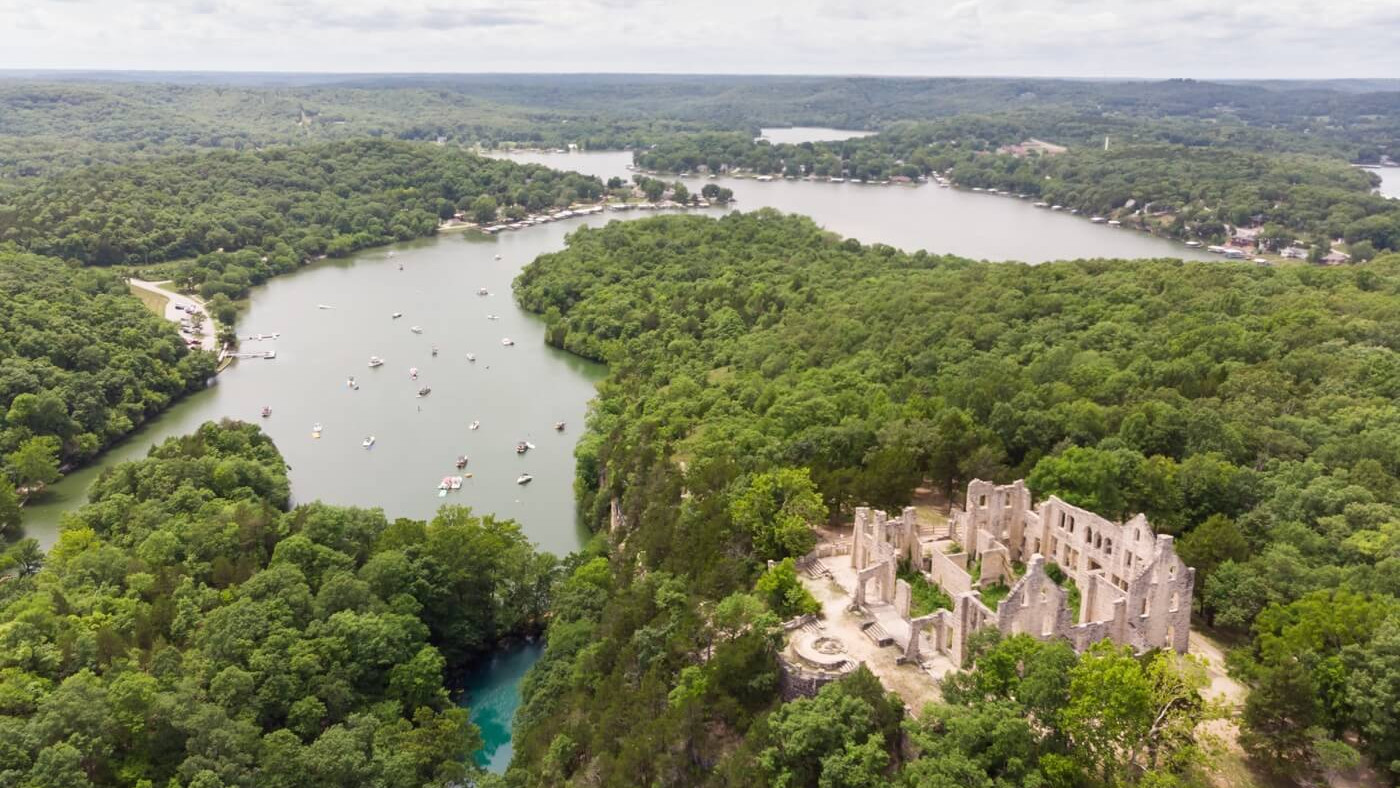
If you’re considering moving onto your boat full-time, there is a range of practical issues you need to take into account before choosing a permanent liveaboard location in the U.S.. For starters, if you’re hoping to live aboard whilst working, you’ll obviously need to be close enough to commute to your office every day. For those of you who are retried or remote workers, you can count yourselves among the lucky ones and you have a bit more freedom to choose where you want to live.
There are plenty of stunning spots in the U.S. but not all of them are practical for year round living. At the same time, you need to be aware of hidden fees and taxes that different states impose so be sure to research any destination thoroughly before packing your bags and heading across the country. Living aboard can be a fantastic adventure, giving you the freedom to live in beautiful destinations for lower prices than waterside properties and the added bonus of being able to sail away whenever the feeling hits you. This list takes into consideration practicality and adventure because really the two go hand in hand when it comes to living on your boat!
Read on for 13 of the best places to liveaboard in the U.S. to maximise your quality of life and quality of sailing.
On this page:
San francisco bay, california, newport, rhode island, green bay, lake michigan, corpus christi, texas, san juan island, washington, tacoma, washington, lake of the ozarks, missouri, long beach, california, chesapeake bay, maryland, long island, new york, tampa bay, florida, destin, florida, oahu, hawaii.
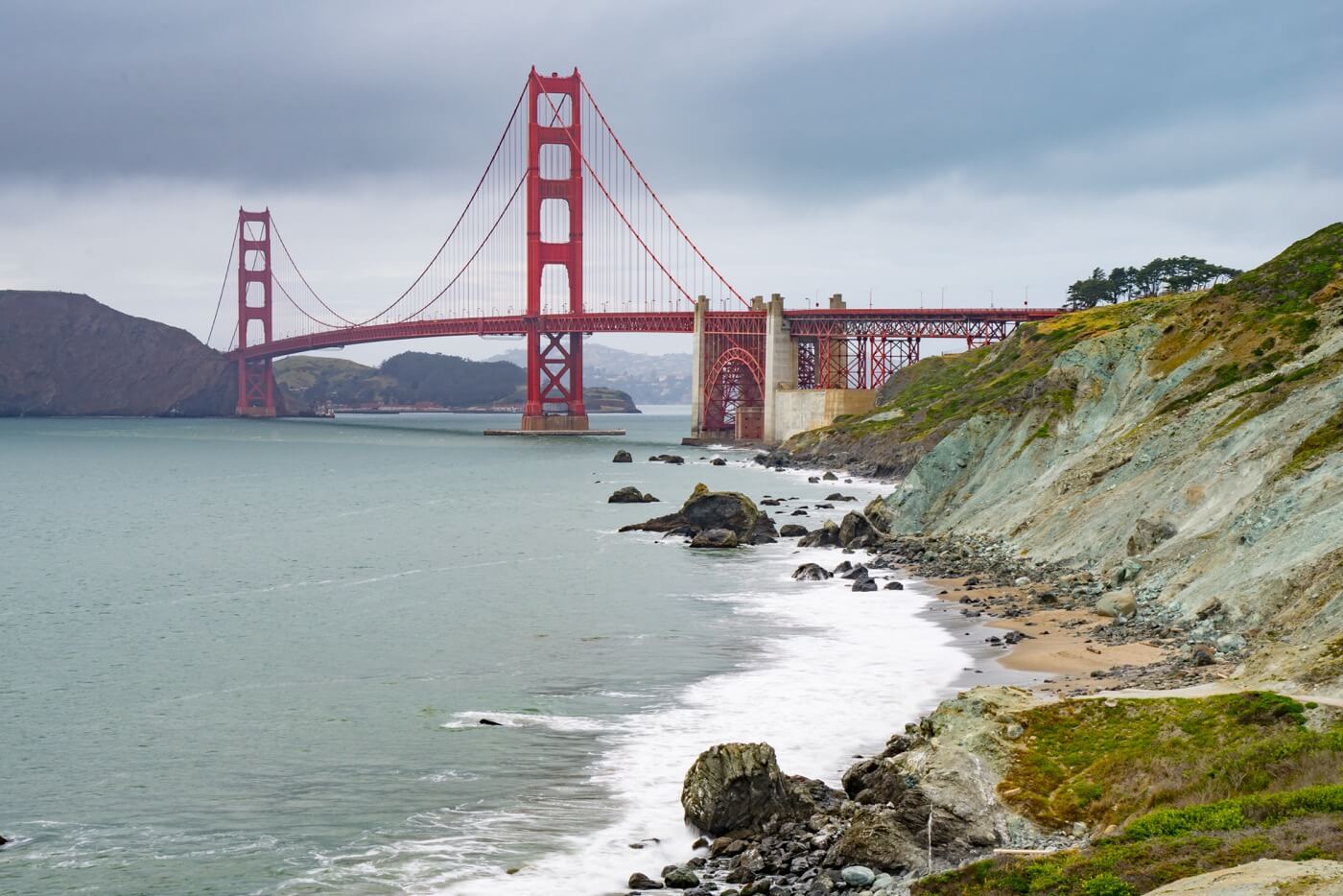
San Francisco Bay is a paradise for sailing. The sheer variety of conditions and scenery you can find in the bay makes it an ideal destination for anyone who loves a challenge. Whilst the weather is not as warm as others on this list, if you wrap up well when you’re out and make sure your boat is fitted with a good heater, it can make an excellent choice. From the Tiburon Peninsula to Richardson Bay to the Farallones, there is a wide range of conditions and winds to contend with. At the same time, there’s plenty of developed waterfront areas to eat, grab a drink or go shopping.
One of the cheapest places to live aboard in San Francisco Bay is Oyster Point Marina where reports put the monthly cost at $350 plus a live aboard fee of $200. Generally, the harbours get less expensive as you go further inland. Good choices include San Rafael and Vallejo.
For cruising at the weekends there’s plenty of destinations on offer including Angel Island or the Petaluma or Napa Rivers. If you have longer, you could consider sailing south to Half Moon Bay or Monterey. A combination of cheap rates (if you know where to look), varied sailing, and plenty of destinations nearby make San Francisco Bay a top choice for liveaboards.
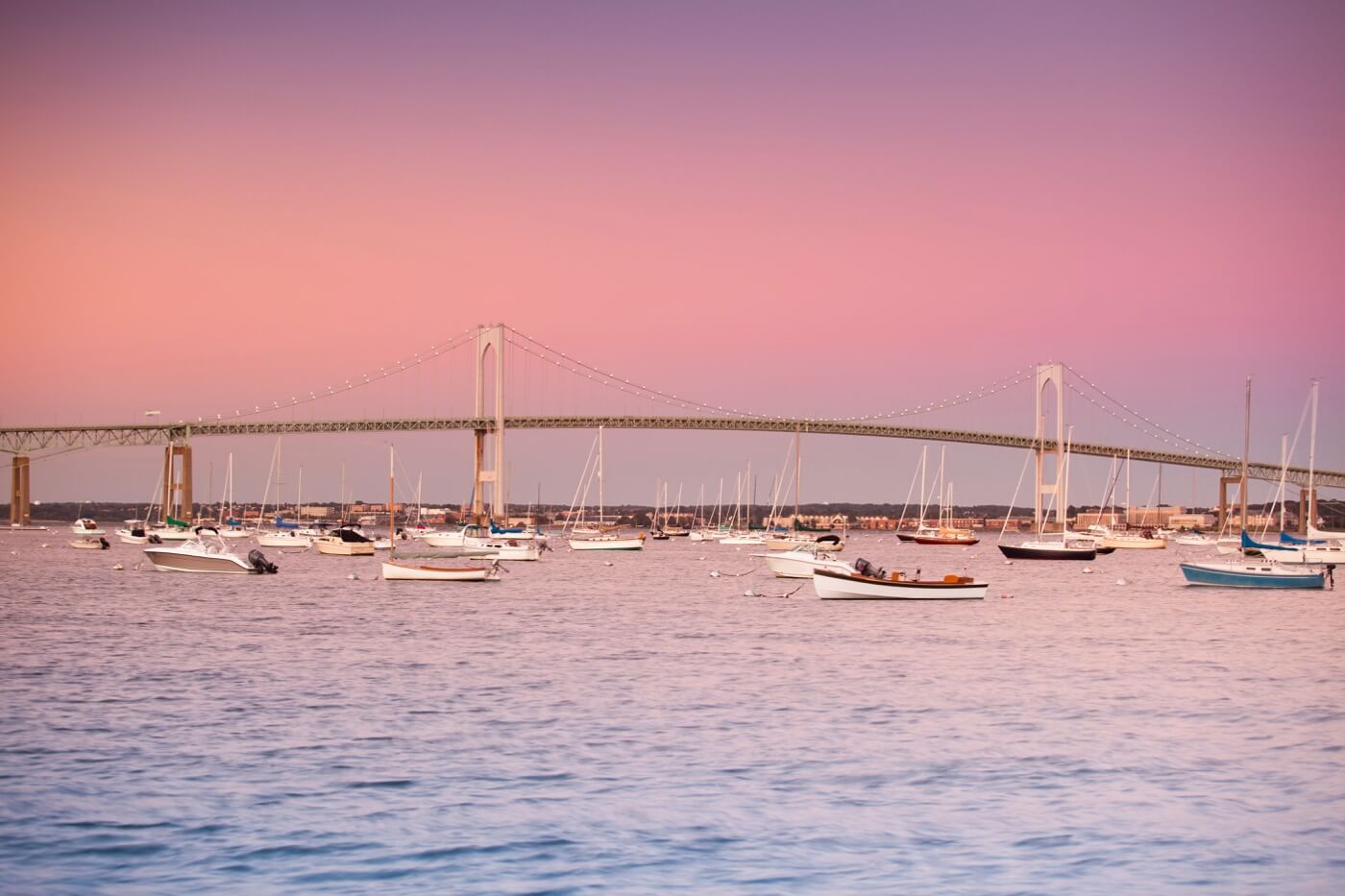
Perfectly positioned on Aquidneck Island, near the mouth of Narragansett Bay, Newport is known as the sailing capital of the world. Whilst this title is certainly up for debate and there’s plenty of other destinations claiming the same, it’s a really popular destination on the East Coast. The area is blessed with a beautiful shoreline and more than 400 miles of coast dotted with beaches. There are yacht tours and a regatta during the sailing season, which runs from mid-April to late October, and there’s some good liveaboard spots available too.
Newport’s popularity makes it an expensive choice but there are some areas that are more reasonable options. Wickford, on the west side of Newport, has rates starting at around $500 per month for a medium-sized boat with access to the town. Jamestown across the bay is also a less expensive option. Getting across to Newport itself is easy enough and the proximity means you can still enjoy all the city has to offer. If walking is more your idea of a good time, there’s a 3.5 mile cliff walk to sink your teeth (feet?) into.
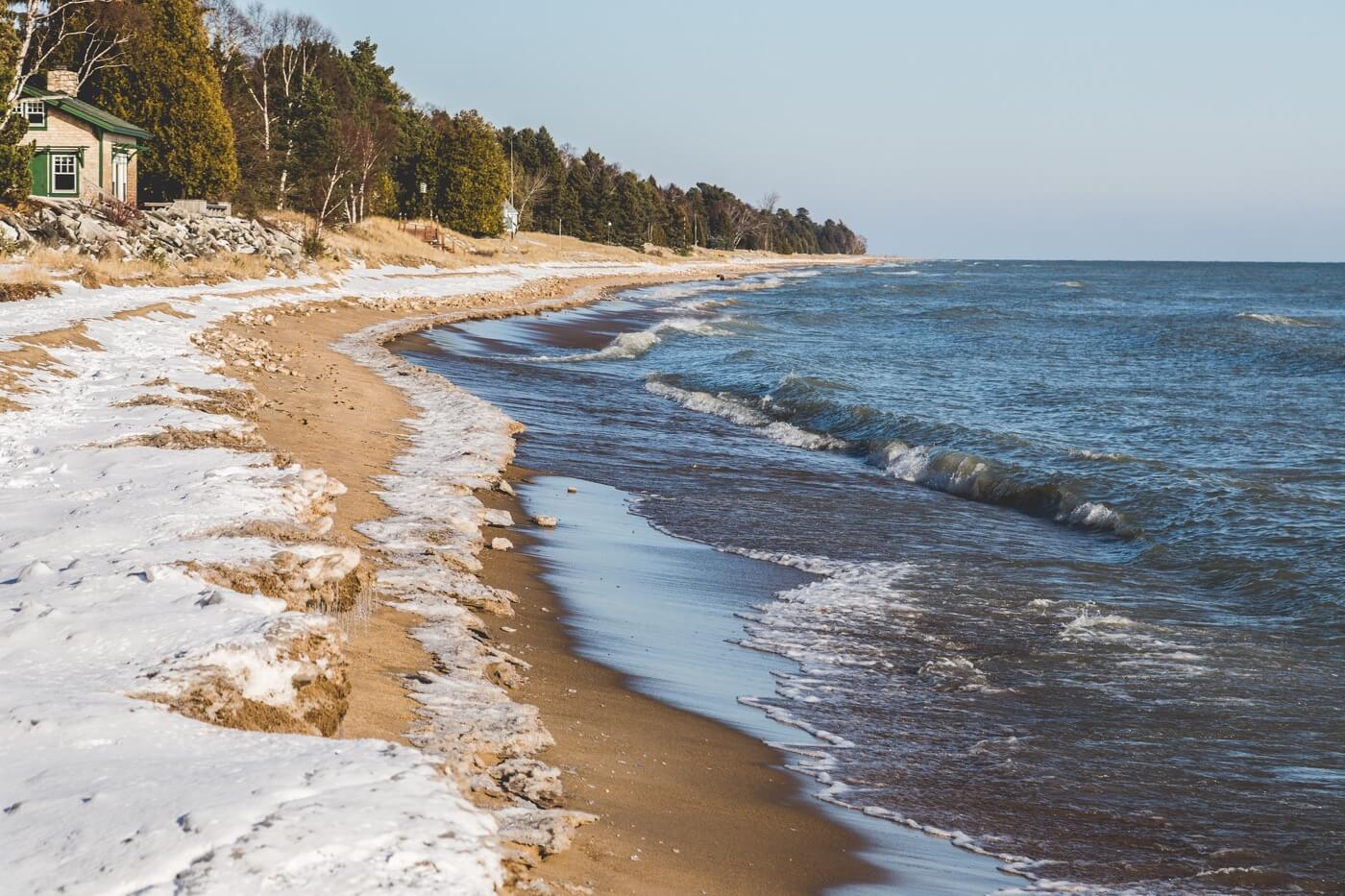
Green Bay on Lake Michigan is another picturesque and convenient choice for liveaboard hopefuls. Green Bay is separated from the rest of the lake by the Door Peninsula and the Garden Peninsula and the islands between them. The waters around Green Bay have been important for hundreds of years, serving as a key waterway for trading fur and pelts. Its history as a port can be traced back to Native American use before British, French and American traders began building military fortifications to secure their hold on the territory in the early 1800s.
You can get to Green Bay via the Fox River, Sturgeon River and Porte des Mortes. Green Bay is ideal for fishing fans as well as offering a large variety of onshore activities from shopping to eating out to the Green Bay Botanical Garden. Green Bay rates start as low as $150 a month if you’re on a strict budget. Be warned, for this price the space will be basic. For higher prices you can find somewhere nicer - you pay for what you get in this area.
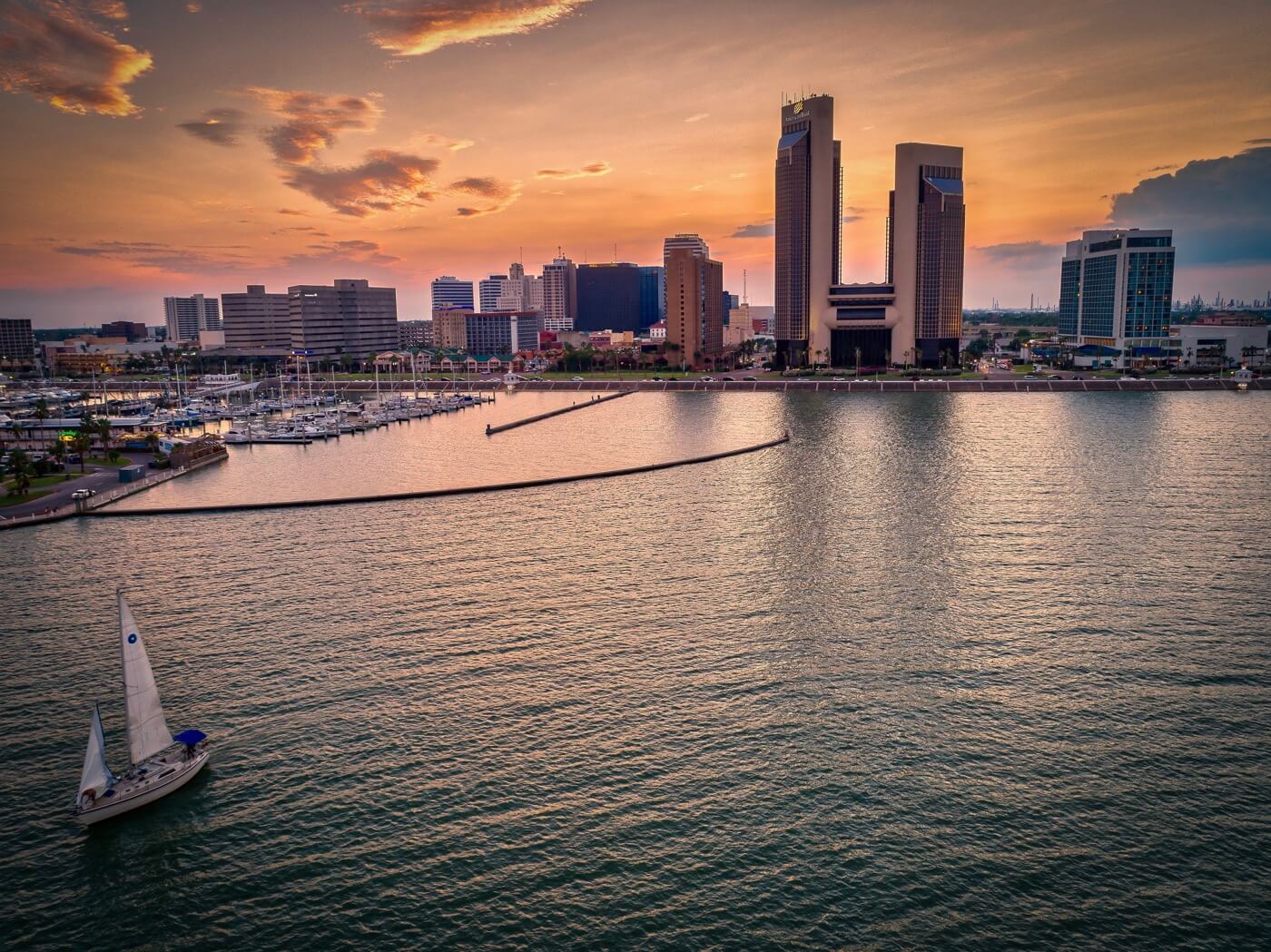
A coastal city on the Gulf Coast of Texas, Corpus Cristi is an affordable and popular option for living aboard, offering the practicality of being close to the city but the romance of life at sea. Sheltered by the Padre and Mustang Islands, the waters are home to sea turtles and migratory birds can be seen flying overhead. At the same time, the waterfront is undergoing increasing amounts of development. It’s known as a safe and laid-back city, making it a popular choice if you’re looking for an easy life.
Texas is a great state for liveaboards as boat taxes are relatively low. You can find slips starting at just $150 per month for smaller boats though prices go up for larger boats of course. One example is a 60-foot slip for $3,000 per year, working out at just $250 per month. Some marinas in Texas allow you to pay annually instead of monthly, which can also save you money long-term.
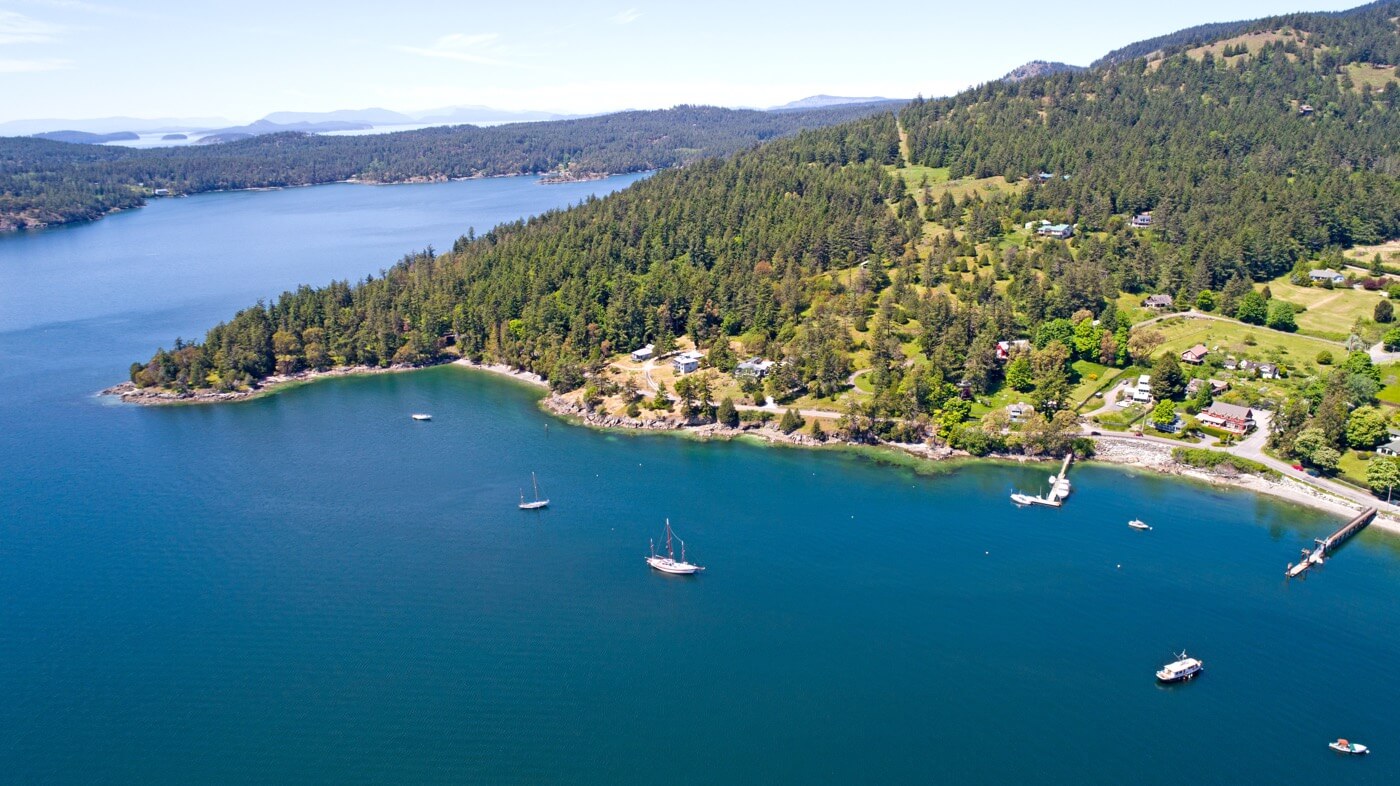
Stunning views, regular festivals and friendly locals - San Juan Island can offer a lot if you’re looking to liveaboard. San Juan is the second largest island in the archipelago between Vancouver Island in British Columbia and mainland Washington. In spite of this, at only 24 miles long, 9 miles wide and a population of 7,500, it’s definitely a small town spot. Here’s a location where everyone knows everyone.
Visitors are drawn by the woods, the beaches and the impressive views of the Olympic Mountains. For cultural activities, there’s a wide range of galleries and studios on the islands thanks to the large number of artists who call the area home. It is also the best spot in Washington for sailing. Despite the drop in temperatures, it’s suitable for sailing year-round, making it an ideal location if you’re planning to liveaboard for 12 months of the year. The best time to sail is from April to October and in the summer you can see orca wales on their annual migration. Be warned, rates tend to be higher for San Juan than other locations but if you have the budget, it’s worth it.
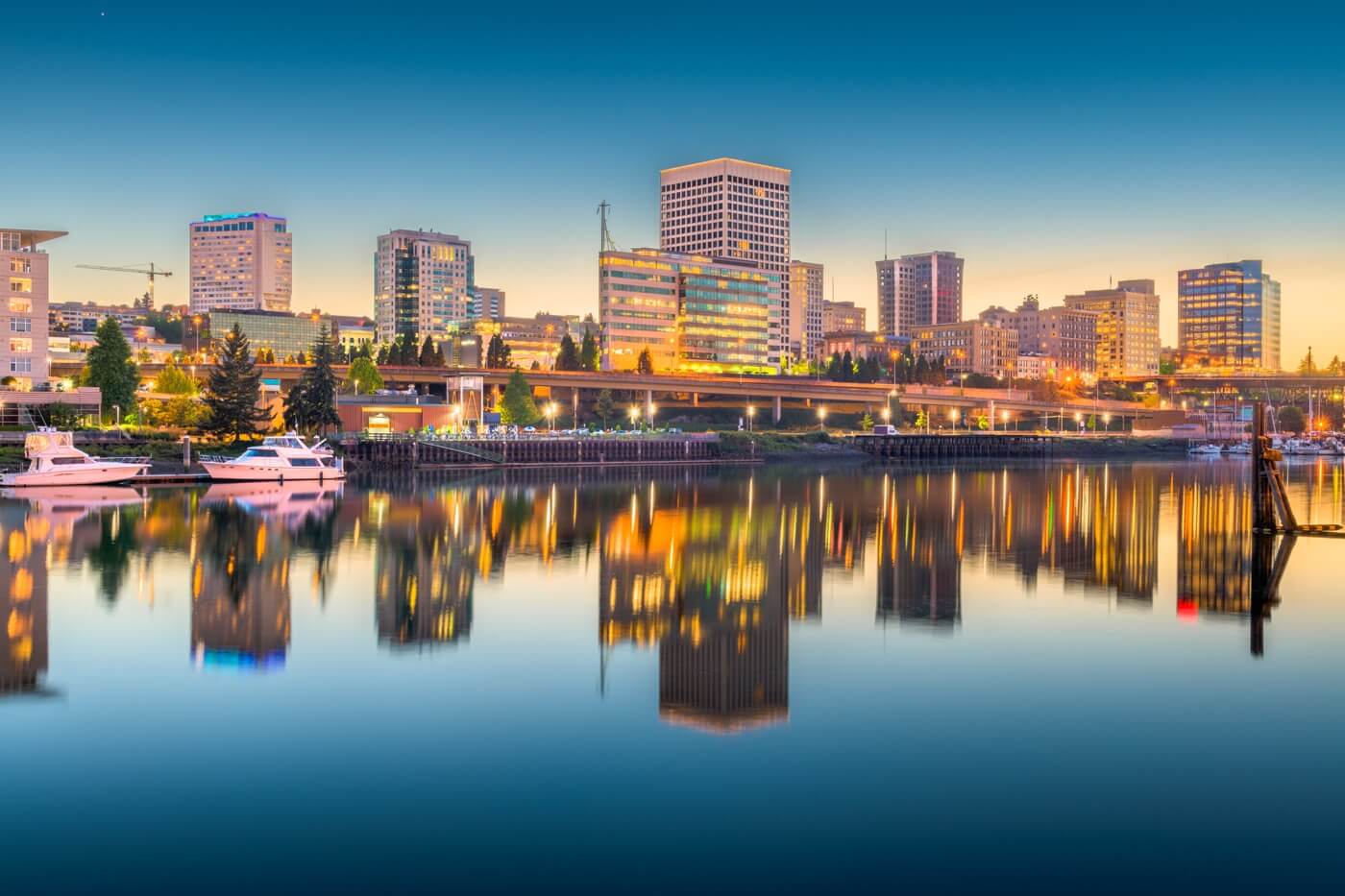
Tacoma is a practical choice for those looking for reasonably priced slips in Washington. Perched on the Puget Sound, Tacoma’s Commencement Bay offers liveaboards city conveniences combined with great sailing. The Puget Sound itself offers good cruising grounds and you can head north to the San Juan Islands for trips. In the South Sound, there are plenty of state parks to be found and fantastic scenery thanks to Mount Rainier only 42 miles away. This is also handy if you’re looking for adventure activities on dry land. What’s more, Tacoma neighbors Seattle and is close enough that you can head over there whenever you’re looking for a taste of the big city.
Rates for liveaboards vary depending on where you’re looking in Puget Sound. Reports for Tacoma put slips at $500 per month compared to $750 in Seattle. Nearby Bremerton is another good choice for keeping costs fairly low. The great news about this location is that there’s a lot of choices for liveaboard marinas so you can find one that suits your needs, be it an on-site gym, a kitchen, showers or storage facilities.
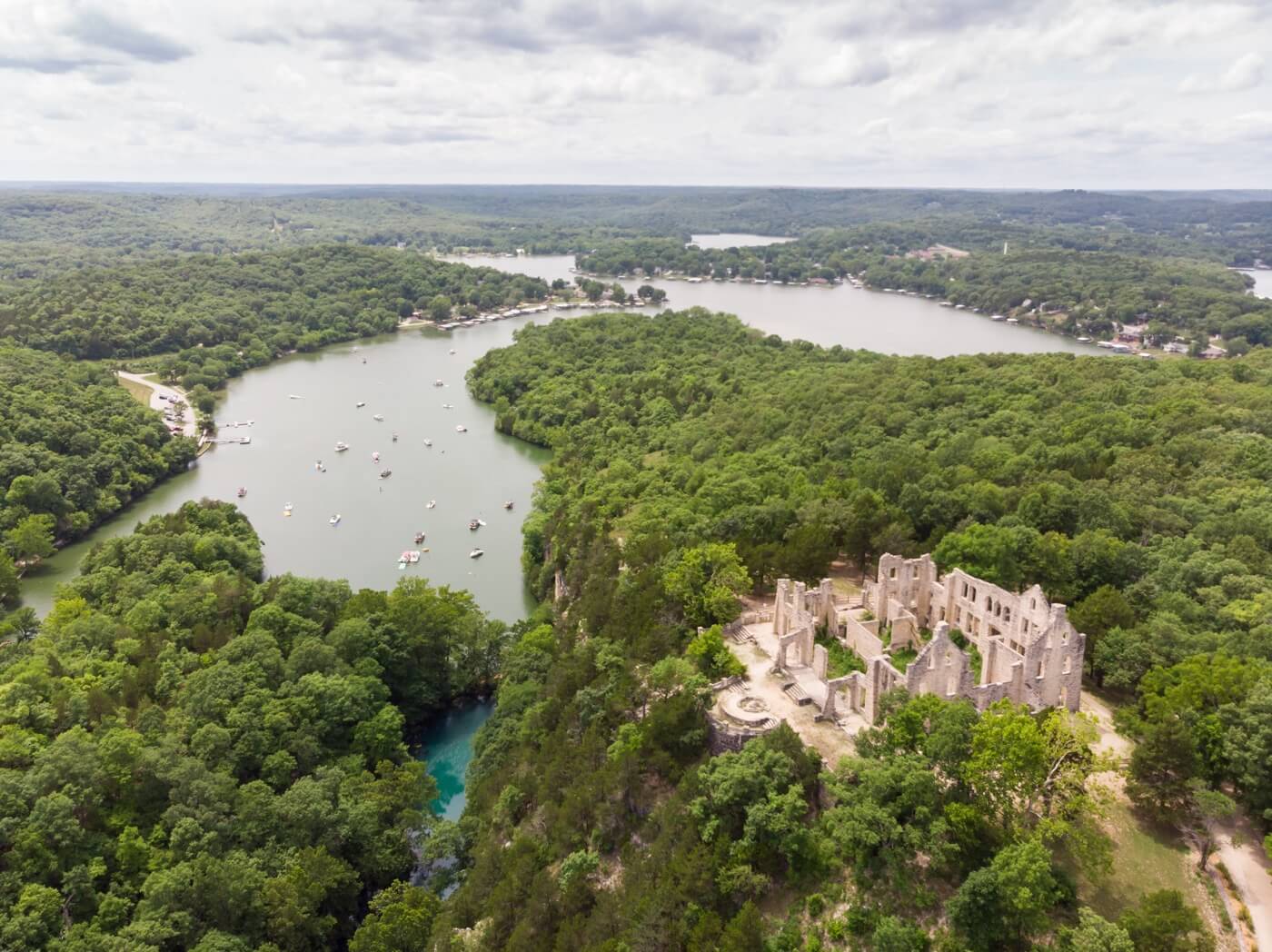
Coming in top for the most break-taking scenery, the Lake of the Ozarks is a truly stunning place to live. Thankfully, living aboard your boat is also fairly cheap, giving you a much better deal than if you tried to buy or rent a lake-side property. The water levels are fairly stable year round and there is a wide range of marinas to choose from who are happy to accommodate liveaboards. Different marinas offer different amenities with some set up for entertaining, with access to BBQs and bars and others better for a quieter lifestyle. It’s a good idea to tour some of them before you decide where to stay to get a feel for the different atmospheres and what you can expect.
There’s no end to the conveniences on offer in this the Ozarks with dockside cafes and restaurants aplenty, placed at convenient points along the shore. The Lake of the Ozarks is so well set up for liveaboards that you can even get food delivered to your boat! This is the ultimate spot for convenience and practicality, if takeout is your idea of being practical!
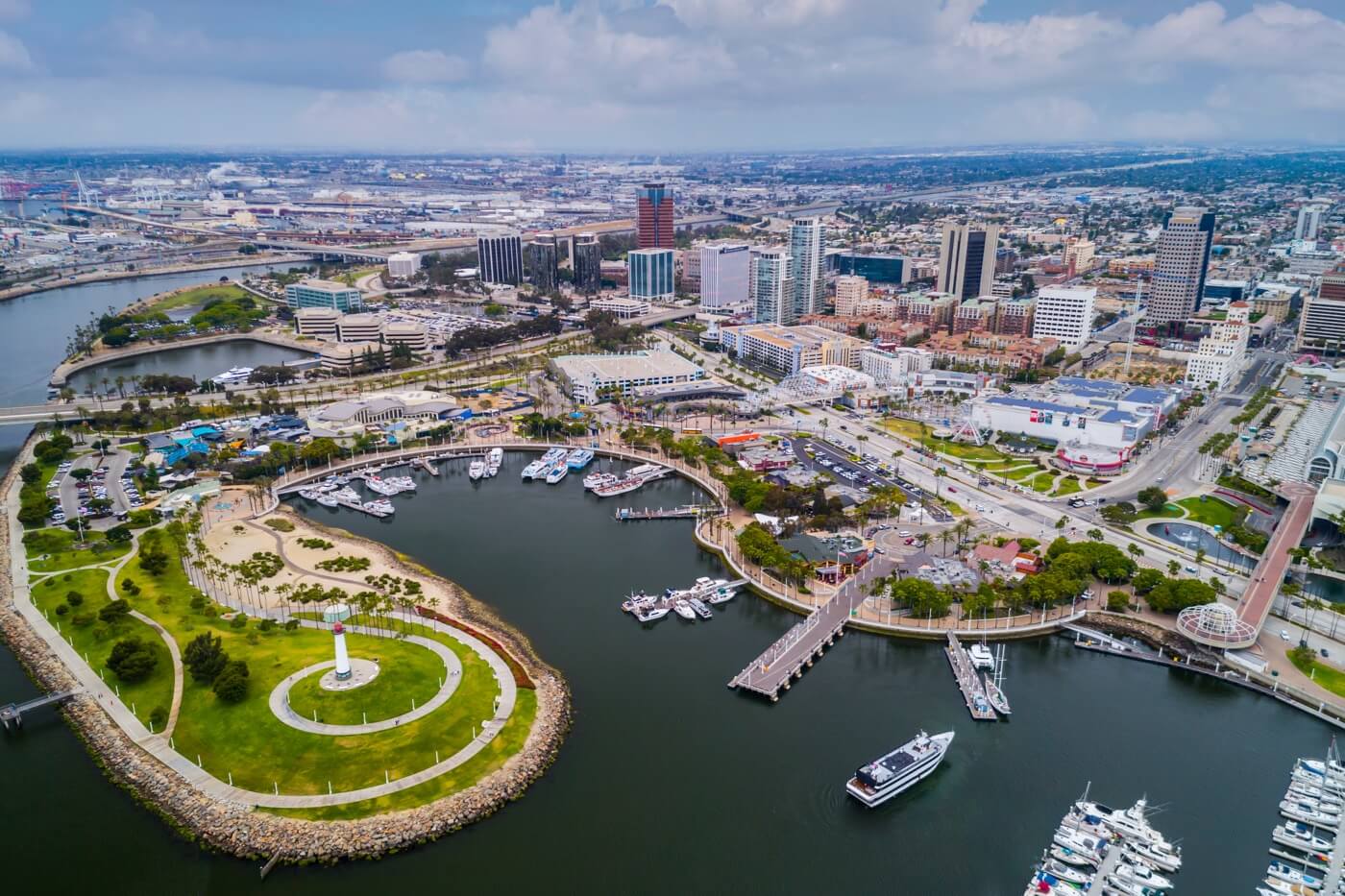
A really popular destination for liveaboards, Long Beach offers a large number of liveaboard locations that you can take advantage of. The nearby Channel Islands make a nice destination for sailing trips and you can enjoy other water-based activities like scuba diving and kayaking too. This is a fantastic choice if you want to live in a place where it’s summer all year round.
The only drawback for living aboard in Long Beach is the waitlist for slips. Thanks to a restrictive cap of 10% for liveaboards in each marina, it can be tough to find a free space. There is no fee for putting in a ‘Liveaboard Request’ but you’ll need to be patient. If you have time to spare then the rewards are worth it and it’s a good option for practicality and a high quality of life. However, this destination is not for spur of the moment decisions!
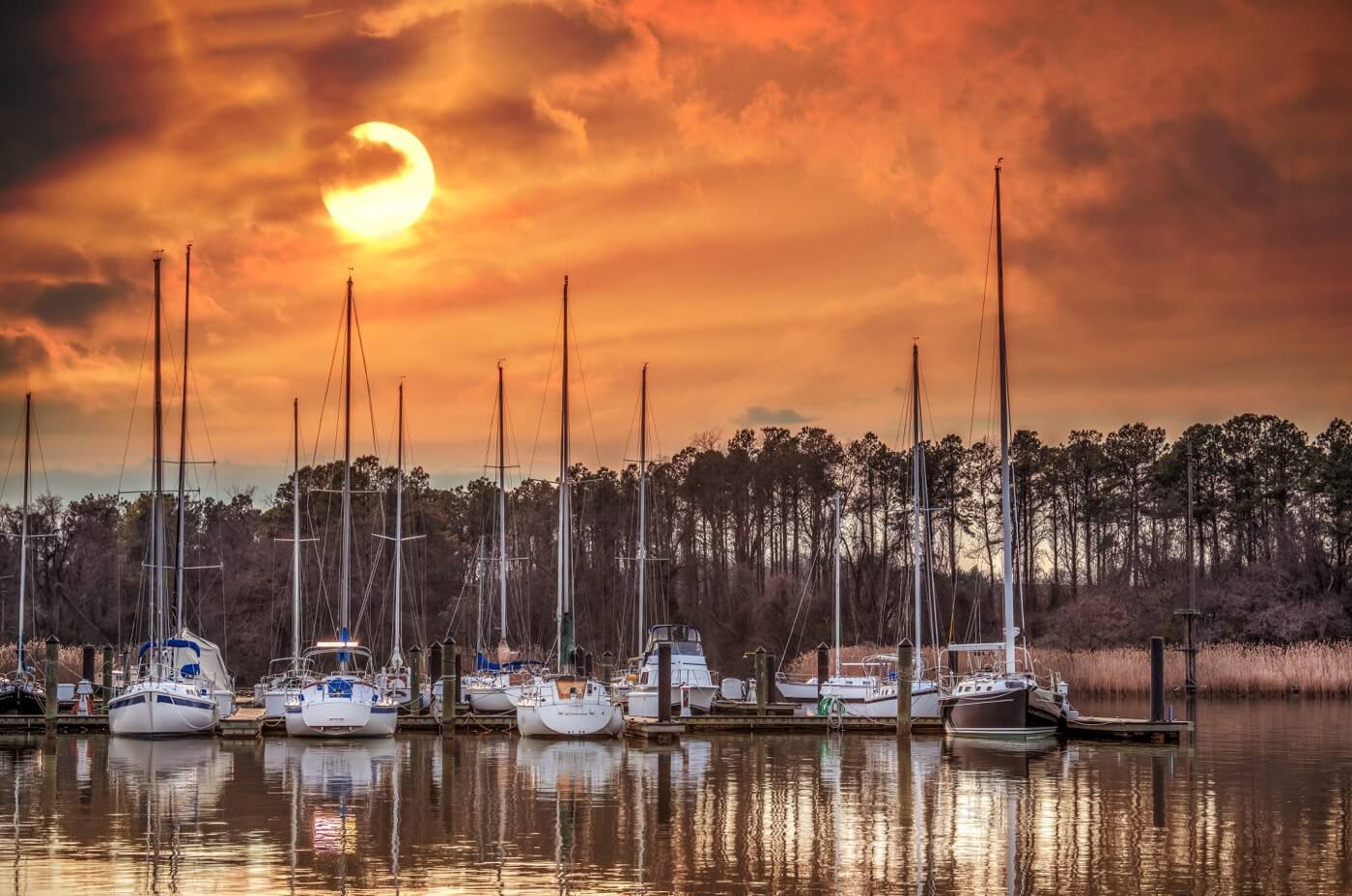
One of the most popular destinations for year-round living, Chesapeake Bay has a lot to offer liveaboards. From rich biodiversity to stunning sailing destinations nearby, there’s a whole range of reasons that this one is on the list. You can choose from a large number of different marinas around the Bay so it’s up to you if you prefer to live near Baltimore, Virginia Beach or anywhere else in the area. At the same time, the Bay offers protection against bad winter weather so it’s a practical choice for all seasons.
Prices can vary depending on where you go and how close you want to stay to urban areas. The starting point is around $300 per month and rates go up from there. For city living on board your boat, you’re going to pay between $5,000 to $8,000 a year here.

Long Island is the perfect choice for living aboard if you’re looking for plenty of destinations to sail to in your free time. You’re at the gateway to New England and can easily head to Connecticut, Rhode Island and Massachusetts in less than an hour. Of course, you can’t forget about New York City as well! Have you ever fancied sailing through Manhattan? It’s a challenging but rewarding cruise with plenty of iconic views along the way. Alternatively, head to The Hamptons for an upmarket experience in the destination of choice for wealthy city-dwellers during the summer.
Long Island itself is 100 miles long and 20 miles wide with bays and inlets, extending into the open ocean. This makes it an awesome destination for sailing, sight-seeing and living aboard. Unsurprisingly, prices are more expensive than others on this list at approximately $600 per month for a 40-foot slip.
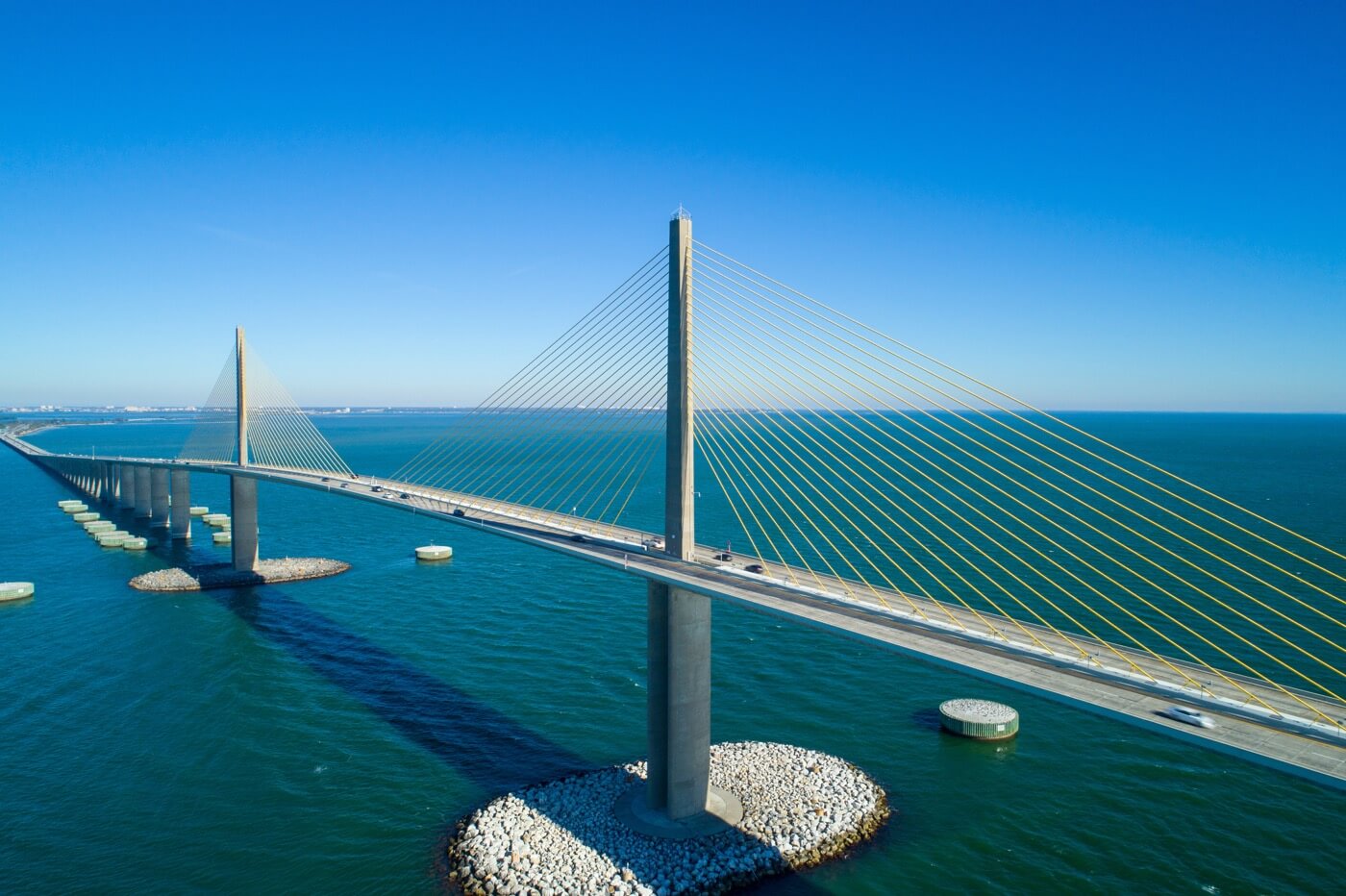
One of the biggest attractions for living aboard in Florida is the weather. You can’t beat the year long summer climate that makes really comfortable conditions for liveaboards. There’s a whole range of options if you’re looking to live aboard in Florida but Tampa Bay is an affordable choice compared to other locations closer to big cities. You’ll find a wide range of rates reflecting the location you choose.
In Tampa and neighboring St. Petersburg, you should be able to find marinas offering $500 per month for a 40-foot slip and other spots that are lower. The beauty of Tampa is that the waterfront is well developed with food, shopping and leisure options to keep you entertained. This means there’s no commute inland to get somewhere fun. Be warned, insurance can be high in Florida and local laws means there’s hoops you have to jump through in order to live on your boat. If you can take this in your stride than Florida makes a great choice.
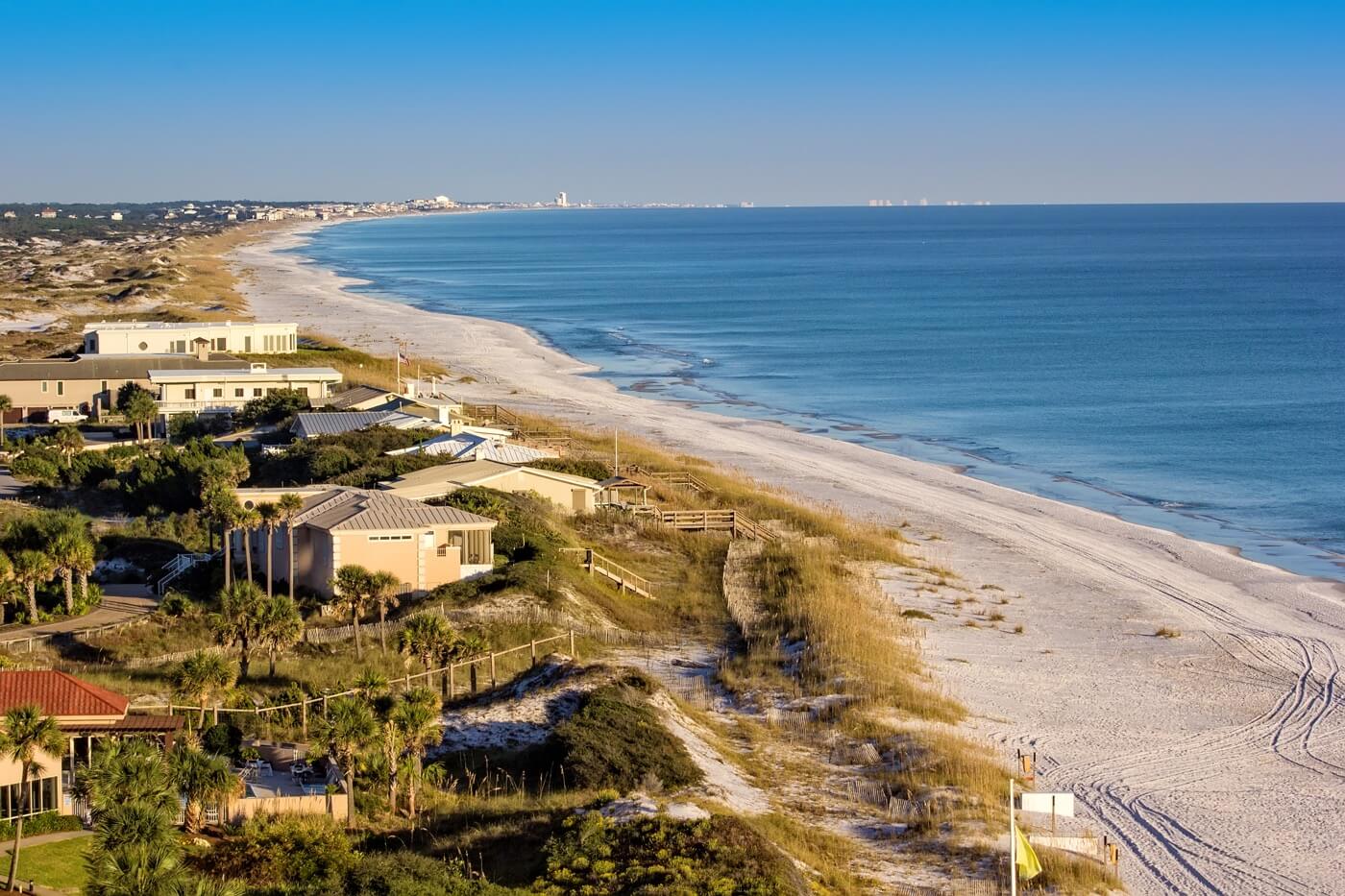
Staying with Florida, Destin is another blissful choice for would-be liveaboards who are looking for a relaxed, subtropical lifestyle. Destin’s beaches are one of the biggest draws for this location, as well as the number of barrier islands to explore. Located on the Panhandle of Florida, Destin is a paradise for leisure activities. The bay and Intracoastal Waterway is perfect for sailing beginners but getting out to the east Pass and the Gulf of Mexico is where the real fun begins. Tides, swells and cross-currents make it a challenging and exciting sailing destination.
The popularity of this destination makes Destin a more expensive choice. You will most likely have to go on a wait-list before you can find a slip. On the other hand, Florida is one of the states with the lowest taxes on boats so that can work in your favour. What’s more, Panama City is within easy reach of Destin for a weekend or head to Choctawhatchee Bay and discover the inland waterways and islands of the Santa Rosa Sound.
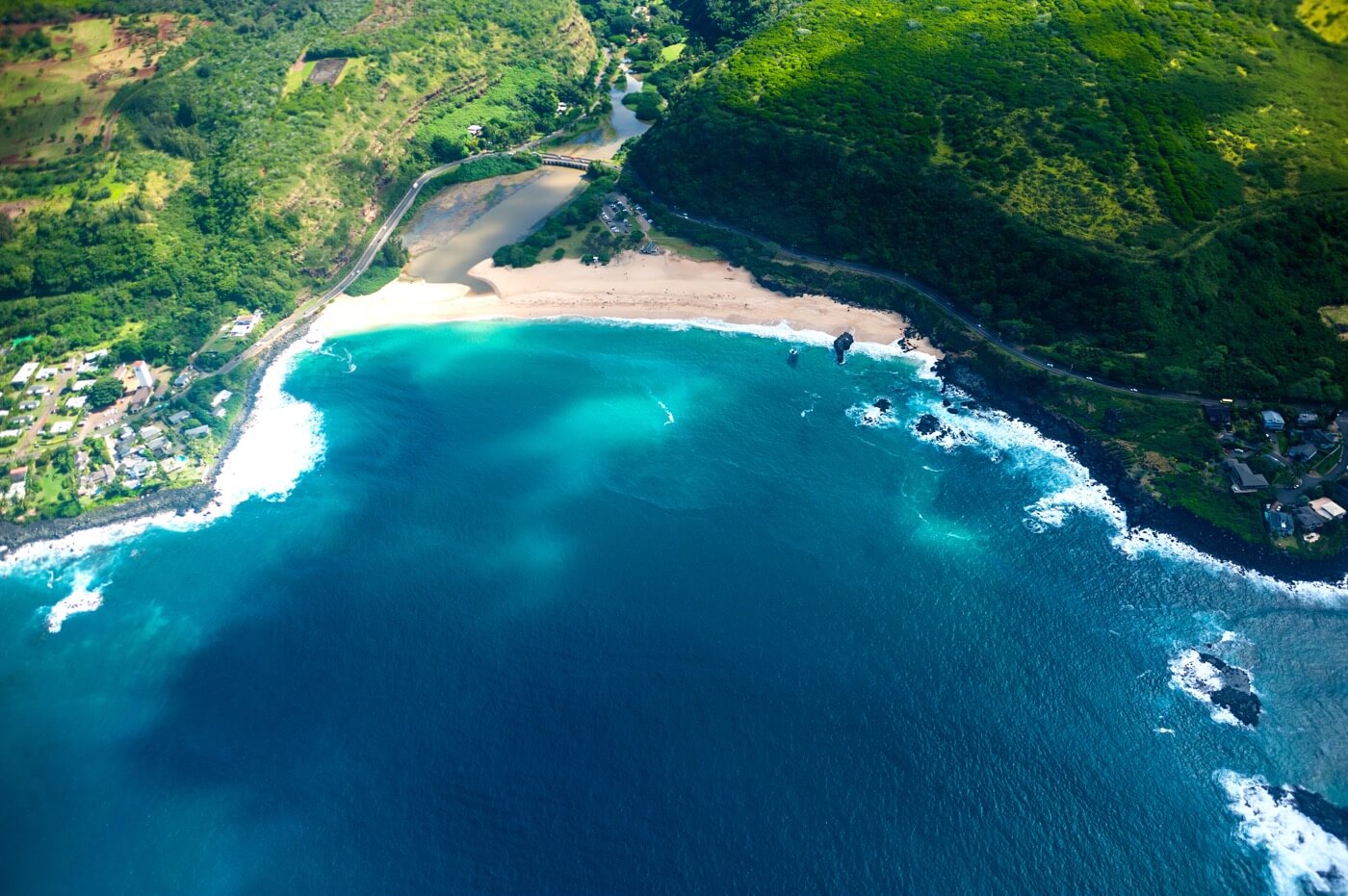
Hawaii is an awesome spot for sailing and the island of Maui is considered to be one of the best in the U.S. but Oahu island has a lot to offer liveaboard hopefuls. Honolulu may seem like an obvious choice but there are other options elsewhere on the island that offer practical alternatives. As with other sought-after locations, many of the liveaboard marinas on Oahu have long wait lists and it can be hard to find spaces for permanent stays. Some of the most popular options, including Haleiwa Harbour on the North Shore have wait times of up to 20 years! This is because it’s the only safe harbour on this shore.
If you can find a space, Hawaii life is worth it. From snorkelling to diving, the island life is truly tempting. In the summer months, you can sail to Waimea Bay and anchor on the sand for a romantic getaway. Thanks to the conditions, you can sail year-round and the infamous Hawaiian winds give you plenty to work with, ensuring you’ll never get bored.
Now the only question is, which destination will you choose?
lee rawlings
ahoy do you know list of low price live a boards in south florida, miami to port st lucie area
Katherine Lindell
Thinking about living aboard your boat in Hawaii? Don’t even go there. Hawaii is considered to be one of the worst sailing destinations in the country if not is the entire world. The entire boating scene in Hawaii is tightly controlled by the division of boating and ocean recreation, well known here to be corrupt and dysfunctional under the leadership of a certain Edward underwood, himself A stunning example of compromised agenda. You are currently not allowed to live anywhere in the state of Hawaii on board your vessel. And because the state’s government is so incredibly corrupt we don’t see this changing anytime soon.
Leave a comment
Own your first boat within a year on any budget.
A sailboat doesn't have to be expensive if you know what you're doing. If you want to learn how to make your sailing dream reality within a year, leave your email and I'll send you free updates . I don't like spam - I will only send helpful content.
Ready to Own Your First Boat?
Just tell us the best email address to send your tips to:
Man gets realistic picture of his boat painted on a fence intended to hide it
A California man who was ordered to keep his boat out of sight has had the last laugh by commissioning an artist to paint a realistic image of it on the fence that obscures it.
Local government officials told Etienne Constable, of Seaside, California, in July that he had to build a 6-foot fence to hide the boat from view of his neighbors.
In a light-hearted jibe at officialdom, Constable decided to follow the directive, which said nothing about how the fence should be decorated, and asked local artist Hanif Panni to create a mural that makes it look as if the fence isn't there.
"I’m not a rule-breaker, but I like to make a political statement as necessary, as well as a humorous statement and a creative statement," he told NBC affiliate KSBW of Monterey Bay .
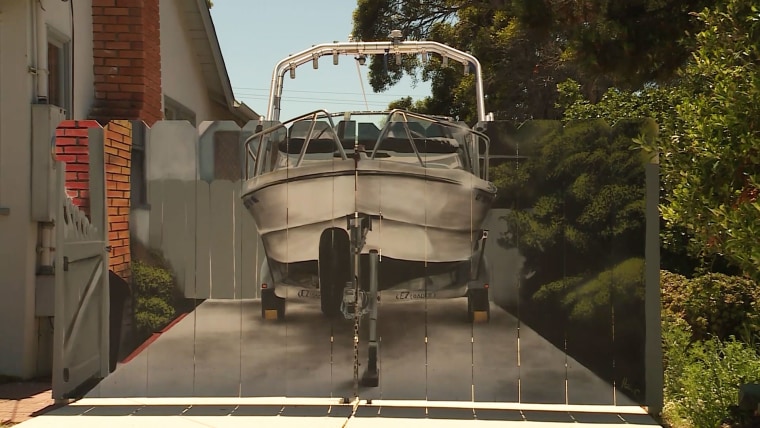
He is yet to have had any contact from the city about the mural — but he said he considers it to be covered by the right to freedom of expression as enshrined in the First Amendment.
"The reaction is extremely more than we ever expected, and we’re both just tickled about it," Constable said, referring to the stir the image has made on social media, where it has been shared many times.
Panni, who paints images across the Central Coast area, told KSBW: "I’m a big proponent of public art in spaces. It engages people in ways that reaching out and having conversations doesn’t sometimes."
And Panni added that since the Seaside boat mural has gone viral, other boat owners have approached him to see whether he can do the same for them.
Patrick Smith is a London-based editor and reporter for NBC News Digital.

Killer whales attack and sink sailing boat off Gibraltar
A n unknown number of orcas rammed a sailing yacht in Moroccan waters in the Strait of Gibraltar on Sunday morning, causing it to later sink, the latest attack in a trend that has been terrifying sailors in the region for the past four years.
The latest incident took place at around 9 a.m. when crew members aboard the 50-foot-long Alboran Cognac called rescue services for help, saying that their ship had been damaged by the apex predators about 14 miles from Cape Spartel, local outlet El Pais reports, citing Spain's maritime rescue service. Cape Spartel is located at the southern entrance to the Strait of Gibraltar.
A helicopter was mobilized and the oil tanker MT Lascaux which was sailing nearby was also asked to provide assistance.
KILLER WHALES MAY BE ATTACKING BOATS AS REVENGE FOR INJURED MATRIARCH: SCIENTISTS
The tanker eventually rescued the two people onboard and transported them to Gibraltar. The yacht was left adrift and eventually sank.
The incident is the latest example of recurring orca rammings around the Gibraltar Strait that separates Europe from Africa and off the Atlantic coast of Portugal and northwestern Spain.
READ ON THE FOX NEWS APP
Experts believe them to involve a subpopulation of about 15 individuals given the designation "Gladis."
According to the research group An Atlantic Orca Task Force (GTOA), which tracks populations of the Iberian orca subspecies, there have been nearly 700 interactions since orca attacks on ships in the region were first reported in May 2020.
VIDEO SHOWS KILLER WHALE NEAR SPAIN BITING RUDDERS OFF BOAT
It is unclear why the orcas are targeting boats but some experts believe they may be acts of revenge.
Marine biologist Alfredo Lopez Fernandez told Live Science previously that the lead whale, a female orca scientists have called White Gladis, suffered a "critical moment of agony," likely a collision with a boat or entanglement with a fishing line , that turned her more aggressive.
Other theories include it being a playful manifestation of the mammals' curiosity, a social fad or the intentional targeting of what they perceive as competitors for their favorite prey, the local bluefin tuna.
All but a handful resulted in only minor injuries or damage. However, the attacks have grown more frequent and a few have led to boats sinking.
For instance, in August last year, Phep Philouceros, 77, was sailing off the coast of Cape Vincent in Portugal, when his boat was attacked by orcas. The sailor, who has 55 years of experience, said the orcas continued for 30 minutes — even following the boat as it was towed to shore. He caught part of the attack on video.
Fox News’ Peter Aitken and Reuters contributed to this report.
Original article source: Killer whales attack and sink sailing boat off Gibraltar

See aboard USS George Washington, an aircraft carrier with a checkered recent history
- USS George Washington departed for South America before heading to its new homeport in Japan.
- It was deployed for the first time in nearly a decade to replace USS Ronald Reagan in Yokosuka.
- Nine sailors died by suicide while the ship underwent a major overhaul that took nearly six years.

USS George Washington, the Nimitz-class nuclear-powered aircraft carrier , departed Naval Station Norfolk in Virginia last month for its new homeport in Japan.
On April 25, the GW was deployed to participate in maritime exercises in the US Southern Command area of operations , marking the vessel's first deployment in nearly a decade after its midlife refueling.
The GW is finally operational after an extended and troubled time going through a major overhaul.
'Team Warfighter is ready to go'
The Washington is set to replace USS Ronald Reagan at the US Navy's naval base in Yokosuka as the service's only forward-deployed aircraft carrier. The Reagan is heading to the Bremerton shipyard in Washington for maintenance.
"Team Warfighter is ready to go," Capt. Tim Waits, commanding officer of George Washington, said in a statement, "not only for the adventure that awaits in South America but ready to serve as the nation's forward-deployed naval forces carrier in Yokosuka."
Southern Seas 2024
Along with the Washington, guided-missile destroyer USS Porter and replenishment oiler USNS John Lenthall are scheduled to conduct exercises and operations at sea with other allied maritime forces in South America for Southern Seas 2024.
Fourth US Navy ship named after the first US president
Built by Huntington Ingalls Industries' Newport News Shipbuilding, the GW is the Navy's sixth Nimitz-class aircraft carrier and the fourth vessel to bear the name of the first US president. The 1,092-foot-long steel vessel accommodates more than 6,000 crewmembers.
The Washington can carry up to 90 fixed-wing and rotary-wing aircraft , including F-35 Lightning and F/A-18 Super Hornet fighter jets.
Armed seagoing airbase
In addition to its primary purpose as a seagoing airbase, the vessel is also equipped with a 20mm radar-guided air-defense gun, a Sea Sparrow surface-to-air missile launcher , and two RIM-116 Rolling Airframe Missile launchers.
First nuclear-powered warship permanently stationed outside the US
Since its commission in 1992, the GW has played key roles in several operations over the last three decades. The ship was deployed to provide air support to New York City following the 9/11 attacks and later to the Mediterranean Sea and the Persian Gulf as part of the US campaign against terrorism .
In 2008, it replaced the first-in-class USS Kitty Hawk as the forward-deployed carrier at Yokosuka, becoming the first nuclear-powered surface warship to be permanently stationed outside the US.
A troubled stay at the shipyard
Last May, the Washington was redelivered to the Navy after a challenging nearly six years in the shipyard.
In 2017, the ship began its midlife refueling and complex overhaul (RCOH) at Newport News Shipbuilding in Virginia, which normally takes four years to repair and upgrade nearly every system and space on the vessel. This includes the time-consuming tasks of removing the reactor's spent core and replacing it with one that has rods fresh with enriched uranium.
The refitting process was delayed amid supply chain issues and staffing shortages brought on by the COVID-19 pandemic, as well as other higher-priority shipbuilding projects taking precedence over the Washington's maintenance.
An unprecedented streak of suicides
During the almost six-year-long maintenance period, an unprecedented string of suicides — a number of whom were junior sailors — occurred among the Washington's crew.
Following several complaints from the crew and the deaths of three sailors by suicide within a week , the Navy launched a series of investigations into the quality of life aboard the carrier in April 2022.
While the monthlong investigation concluded that the deaths were "not related or connected," it found it was a result of "unique and individualized" challenges they faced aboard the GW during the major overhaul.
Months turn into years
Investigators found Navy leadership failed to address uninhabitable living conditions for sailors who moved back aboard the ship prematurely due to housing shortages at the shipyard .
A crew usually returns to reside on their assigned ship within six to nine months before it is redelivered to the Navy. When sailors moved back aboard the Washington, the expected redelivery was August 2022, but shipyard delays led to crews living aboard the ship for nearly two years.
Crewmembers assigned to vessels in the shipyard reside in Huntington Hall, a 149-unit residence building operated by HII. The Navy spends more than $4 million to provide housing for eligible personnel.
Uninhabitable living conditions
But as shipbuilding and repair projects at Newport News piled up, so did the number of crew who needed accommodation. Lower-ranking sailors who were not given a basic housing allowance to help pay for off-base apartments were forced to live aboard the ship before it was ready, lacking hot water and privacy, facing power outages, and enduring unbearable temperatures.
One of the Navy's investigations found that sailors who weren't living aboard the ship resorted to sleeping in their cars or paying for rent in the Norfolk area. Some sailors faced complicated commutes lasting up to three hours, involving unpredictable traffic, catching shuttle buses, and mile-long walks.
"Collectively, Navy senior leadership, officer and civilian, let our standards slip — and in doing so, we let our people down," Navy Secretary Carlos Del Toro and then-Chief of Naval Operations Adm. Michael Gilday in a memo.
'Reduced quality of life in the shipyard'
Surveys conducted while the vessel was in the shipyard found that the crew had the highest number of suicidal ideation and suicide attempts compared to all aircraft carriers on the East Coast from 2017 to 2019.
Despite a sharp rise in "awareness of suicidal ideations" while the Washington underwent the overhaul, the Navy's report found that leadership missed the warning signs.
"It is safe to say that generations of Navy leaders had become accustomed to the reduced quality of life in the shipyard and accepted the status quo as par for the course for shipyard life," Rear Adm. John Meier, now-retired commander of Naval Air Force Atlantic, said in an October 2022 investigation report . "As senior sailors, it is easy to forget our Navy life in the beginning."
The ship's assigned officers receive housing allowances and typically only stay aboard the ship for duty or overnight maintenance projects.
'Shipyard environment is always a challenge'
According to USNI News , of the 42 sailors assigned to aircraft carriers who died by suicide from 2017 to 2022, nine of them were assigned to the GW.
Cmdr. Dawn Stankus, a spokesperson for Naval Air Force Atlantic, told Military.com that the "shipyard environment is always a challenge."
"When you're in a shipyard, you don't necessarily get to do what you signed up to do in the military," Stankus added.
A 2023 Pentagon report found that the Navy had a suicide rate of 20.6 deaths per 100,000 sailors — the highest in four years.
More mental health resources
The Navy is taking strides to improve the quality of life for sailors aboard the Washington.
Kellylynn Zuni, the GW's clinical psychologist , told Health News Florida that the permanent mental health staff on the ship has doubled, allowing them to see any sailor who needs immediate help. The Navy is also creating a psychiatrist intervention team to provide mental health care in emergencies.
In February, the ship also opened a new rest and recreation area for sailors that includes a library, TV, videogames, computers, and phones to stay in contact with their families.
"The underlying theory there is by improving quality of service — which is the combined effort of quality of life and quality of work — we believe that that reduction in friction in a sailor's life will be one less thing in their rucksack if you will," Adm. Daryl Caudle, commander of Fleet Forces, told USNI News in October.
Caudle continued: "But the premise is if I can lower that stress and lower what's on sailors by making their quality of life and quality of work more efficient, more effective, more desirable, then the propensity to actually think about completing suicide will not be on the table."
If you or someone you know is experiencing depression or has had thoughts of harming themself or taking their own life, get help. In the US, call or text 988 to reach the Suicide & Crisis Lifeline , which provides 24/7, free, confidential support for people in distress, as well as best practices for professionals and resources to aid in prevention and crisis situations. Help is also available through the Crisis Text Line — just text "HOME" to 741741. The International Association for Suicide Prevention offers resources for those outside the US.
If you or someone you know is experiencing depression or has had thoughts of harming themself or taking their own life, get help. In the US, call or text 988 to reach the Suicide & Crisis Lifeline , which provides 24/7, free, confidential support for people in distress, as well as best practices for professionals and resources to aid in prevention and crisis situations. Help is also available through the Crisis Text Line — just text "HOME" to 741741. The International Association for Suicide Prevention offers resources for those outside the US.
- Main content
- 1-855-932-1711
- My Account Hello Credits My Account Log out
- 2025 Grand World Voyage
- 2025 Pole to Pole Voyage
- 2026 Grand World Voyage
- 2026 Grand Australia & New Zealand Voyage
✤Some categories have obstructed or partially obstructed views. International Air Credit amounts: GBP 400; EUR 450; AUD 650. *San Diego airport transfers available only on days of embarkation (January 4, 2026) and disembarkation (April 7, 2026). **Luggage delivery applies to U.S. and Canadian residents only. Residents of other countries will receive Onboard Credit in the following amounts (applied at the time of booking): US$500 Onboard Credit/person (Categories PS-SB); US$400 Onboard Credit/person (Categories A-BC); US$300 Onboard Credit/person (Categories C-F). ***Grand Mariner Discount available only to past Holland America Line Grand Voyage guests. Discount amount for segment voyages is dependent on voyage length (up to US$300 value). ¶ For guests receiving a complimentary upgrade or purchasing a PLUS offer, promotional or stateroom amenities are based on the non-discounted category paid, not the upgraded stateroom category. Early booking benefits apply only to the 1st and 2nd guests in a stateroom. Restrictions apply. See full terms and conditions for additional details.
Terms & Conditions
US/Canada : GENERAL TERMS APPLICABLE TO ALL PARTS OF THE Grand Voyage Early Booking OFFER Benefits (“Offer(s)”): Offers are available for full 2026 93-Day Grand Australia & New Zealand to 1st/2nd guests sharing a stateroom who make a new booking on select categories by June 16, 2025. Offers are based on Promo(s) W**/UK*. Amenity values vary by category booked. Offers are only available on a limited basis and are capacity controlled (regardless of stateroom availability) and may not be combined with other offers or promotions (aside from those listed herein). Other exclusions may apply; void where prohibited. Offers and their parts are not transferable, not substitutable, and not redeemable for cash. Holland America Line (“HAL”) is not responsible or liable for any Offer errors, including printing, typography, or other errors. HAL may change or revoke the Offers at any time. All values are quoted in USD. If guest booking Offer received a complimentary upgrade or purchased a PLUS offer, promotional or stateroom amenities are based on the non-discounted category paid, not the upgraded stateroom category. For more information about our stateroom categories and suite descriptions, to view deck plans, and for full terms and conditions applicable to your cruise, please refer to HollandAmerica.com or the appropriate Holland America Line brochure. Offer ends June 16, 2025. Ships’ Registry: The Netherlands. Advertised Offer value of $7900 is per person based on double occupancy and applies to the 93-Day Grand Australia & New Zealand (roundtrip San Diego) in a Pinnacle Suite based on the following approximate values: $2,000 Onboard Credit; Crew Appreciation valued at $1767; one complimentary shore excursion valued at $250 and must be selected from the Collections of Holland America Line list; luggage delivery service valued at $500; Surf Wi-Fi package valued at $615.99; Flight Ease Air Credit valued at $500; Roundtrip group transportation between San Diego airport and point of cruise’s embarkment/disembarkment on the day of embark (January 4, 2026) and the day of disembark (April 7, 2026) valued at $48; complimentary initial liquor setup (4 bottles) valued at $100; and a “Welcome on Board” bottle of sparkling wine valued at $21 per guest. The following amenities vary by category booked and are available throughout the entire booking window and are valued as follows: complimentary unlimited in-suite bottled water and soft drinks valued at US$782 and complimentary laundry, dry cleaning, and pressing valued at US$837. The Grand Mariner discount is valued at US$500 per person and is available to guests who have previously sailed on a Holland America Line Grand Voyage. Pay in Full Saving Option: Pay in full by June 16, 2025, and save an additional 3% from the applicable fare. Applicable to full-cruise and segment-cruise guests, including third and fourth persons. Agent commission is based on the fare paid after all promotions are applied.
Onboard Credit (“OBC”) Offer : OBC will be applied to guest’s folio account and amount varies based on stateroom type as follows: $2000 per person ($4000 for singles) for guests booked in a Pinnacle Suite (PS) stateroom; $1000 per person ($2000 for singles) for guests booked in a Neptune Suite (SA-SB) stateroom; $750 per person ($1425 for singles) for guests booked in a Vista Suite (A-BC) stateroom; $500 per person ($800 for singles) for guests booked in an Ocean-View (C-F) stateroom. Limit: One (1) OBC per guest and available only for 1st/2nd guests in a stateroom. OBC is not refundable, transferable, or redeemable for cash and has no cash value. OBC may only be used on the cruise it was awarded in connection with and expires at the end of such cruise. OBC may not be used in the casino or on other specified fees or items. Crew Appreciation : is paid on behalf of the guest for on-board items/charges but does not include other service charges including, but not limited to Crew Appreciation for bar, dining room, wine accounts and spa/salon services. Shore Excursion : Guest will receive one (1) shore excursion per person. Excursion is non-refundable and must be chosen from the Collections of Holland America Line list. Shore excursion credit cannot be redeemed for cash value or applied to a non-shore excursion item. Luggage Delivery Service : Delivery is available for U.S and Canadian residents only and only available to/from your home residence to the ship in San Diego. HAL will deliver up to 5 suitcases/bags for guests booked in Pinnacle Suite (PS) staterooms and Neptune Suite (SA-SB) staterooms; up to 4 suitcases/bags for guests booked in Vista Suite (A-BC) staterooms; up to 3 suitcases/bags for guests booked in Ocean-View (C-F) staterooms. HAL is not responsible for luggage or items contained therein. Guests should not leave personal documents, valuables, or money in luggage left for delivery. In-suite Liquor Setup and Sparkling Wine : Available only for Pinnacle suite (PS), Neptune Suite (SA-SB), Vista Suite (A-BC), and Ocean View (C-F) staterooms. Guest must be 21 years or older to receive in-suite liquor or sparkling wine. Guests under the age of 21 shall not receive any substitute beverage or item. 3% Pay in Full Discount : Guests that pay their full cruise-fare on or before June 16, 2025 receive a 3% discount off such cruise-fare. Discount does not apply to Taxes, Fees, or Port Expenses or any other expenses or costs. Surf Wi-Fi Package: Internet usage is subject to HAL standard policies, which may limit browsing of some sites due to network security and bandwidth usage. Applications that use high bandwidth may be blocked and offerings are subject to change with or without notice. The plan can be activated on any device but only one device can be actively connected at a time. Offer applies to guests 1 & 2 only in a stateroom. US$500 Air Credit is per person for flights booked through Flight Ease . Flights are subject to availability. Air credit must be used by the time of voyage departure. Airport Transfers are provided to/from San Diego (SAN) airport on the day of embark and the day of disembark for up to 2 people per stateroom in standard transportation; guests flying into different airports shall not receive airport transfers. If any guest flies in earlier than the date of cruise embarkment or flies home later than the day of cruise disembarkment, then no airport transportation may be provided. Guests driving to the point of embarkment/disembarkment shall not be eligible for this part of the Offer.
Segment guests will receive the following Onboard Credit amounts per person for 1st/2nd guests sharing a stateroom: For segments 34 days or longer : $500 per guest ($1000 for singles) for Pinnacle Suite (PS) or Neptune Suite (SA-SB), $500 per guest ($950 for singles) in Vista Suite (A-BC), $300 per guest ($480 for singles) in Ocean-View (C-F). For segments up to 33 days : $250 per guest ($500 for singles) for Pinnacle Suite (PS) or Neptune Suite (SA-SB), $250 per guest ($475 for singles) in Vista Suite (A-BC), $150 per guest ($240 for singles) in Ocean-View (C-F). Grand Mariner Discount available for Segment Voyages at varying values dependent on voyage length (up US$300 value). 3% Pay in Full Discount : Guests that pay their full cruise-fare on or before June 16, 2025 receive a 3% discount off such cruise-fare. Discount does not apply to Taxes, Fees, or Port Expenses or any other expenses or costs. Surf Wi-Fi Package: Internet usage is subject to HAL standard policies, which may limit browsing of some sites due to network security and bandwidth usage. Applications that use high bandwidth may be blocked and offerings are subject to change with or without notice. The plan can be activated on any device but only one device can be actively connected at a time. Offer applies to guests 1 & 2 only in a stateroom.
As we travel across the oceans and to remote areas of the world, it’s possible we may experience reduced or intermittent satellite connection. Although the high bandwidth satellite footprint is extensive, it does not cover the entire world. In some instances, our location and surrounding terrain can contribute to a slower browsing experience, partial loss of signal or temporary outage. We thank you for your patience during these times and recommend that you log out and try back later once the ship has relocated.
*Fares are per person, in AUD, in complete twin accommodation based on the lead category for each stateroom type at time of publication, inclusive of all discounts, taxes, fees and port expenses (which are subject to change). Campaign ends on 16 June 2025. Valid for new bookings and not combinable with any other offer. Offerings on 93-day Grand Australia & New Zealand (roundtrip San Diego) departing January 4, 2026 incl segments as specified. Offerings vary by itinerary and stateroom category. Supplements apply for other stateroom categories. Fares based on specific departure dates only. Higher fares may apply to other departure dates. Holland America Line has set aside a reasonable number of staterooms which are available at these fares and once sold, fares may vary. Some staterooms have obstructed views. Offerings are valid for the eligible cruise only and are not transferable or redeemable for cash. Offers are based on Promo(s) W**/UK*. If guest booking Offer received a complimentary upgrade or purchasing a PLUS offer, promotional or stateroom amenities are based on the non-discounted category paid, not the upgraded stateroom category. Cruise Only fare is the cruise fare without any inclusions.
To be read in conjunction with the Holland America Line Passage contract www.HollandAmerica.com/en_US/legal-privacy-australia/cruise-contract.html which guests will be bound by. Vaccination requirements apply. Government guidelines may result in a requirement to quarantine during or after your cruise and may restrict your ability to participate in shore tours or disembark the ship at ports we visit during your cruise. See our Health Protocols at https://www.hollandamerica.com/en/travel-well for more information. Guidelines are subject to change without notice and, as such, our actual cruise offerings may vary from the descriptions provided and images displayed. Cruise itineraries are not guaranteed. A credit card surcharge of 1.1% for Visa and Mastercard and 2.75% for AMEX will apply to direct bookings made through our website or call centre. No surcharges apply to debit cards. Travel agents may charge additional fees; check with your travel agent. Whilst all information is correct at time of publication, offers are subject to change or withdrawal. Carnival plc trading as Carnival Australia ABN 23 107 998 443 as agent for Holland America Line.
Pay in Full Saving Option : Pay in full by 16 June 2025 and save an additional 3% from the applicable fare. Applicable to full-cruise and segment-cruise guests, including third and fourth persons. Agent commission is based on the fare paid after all promotions are applied.
Onboard credit: is in USD, per stateroom and applied to the first 2 guests in a stateroom. Solo travellers receive a different amount as specified. Onboard spending money expires at the end of the eligible cruise, is not transferable, non-refundable, not redeemable for cash and cannot be used at the casino or on other specific items. Amount varies by stateroom category and itinerary up to a maximum of $2000 as follows: For full Grand Voyage : $2000 per guest ($4000 for singles) in a Pinnacle Suite (PS), $1000 per guest ($2000 for singles) in a Neptune Suite (SA-SB), $750 per guest ($1425 for singles) in Vista Suite (A-BC), $500 per guest ($800 for singles) in Ocean-View (C-F). For segments 34 days or longer : $500 per guest ($1000 for singles) for Pinnacle Suite (PS) or Neptune Suite (SA-SB), $500 per guest ($950 for singles) in Vista Suite (A-BC), $300 per guest ($480 for singles) in Ocean-View (C-F). For segments up to 33 days : $250 per guest ($500 for singles) for Pinnacle Suite (PS) or Neptune Suite (SA-SB), $250 per guest ($475 for singles) in Vista Suite (A-BC), $150 per guest ($240 for singles) in Ocean-View (C-F).
Crew Appreciation : Available only for Pinnacle Suite (PS), Neptune Suite (SA-SB), Vista Suite (A-BC), and Ocean-View staterooms(C-F) on the full Grand Voyage. Crew Appreciation is paid on behalf of the guest for stateroom gratuities only and does not include other service charges including but not limited to Crew Appreciation for bar, dining room, wine accounts and spa/salon services.
Shore Excursion : Available only for Pinnacle Suite (PS), Neptune Suite (SA-SB), Vista Suite (A-BC) on the full Grand Voyage. Available to the first 2 guests in the stateroom only. Receive one (1) complementary shore excursion up to the value of US$250. Only redeemable from Collections of Holland America, limit one (1) per person, not transferable, non-refundable, not redeemable for cash and expires at the end of the eligible cruise.
In-suite Liquor Setup : Available only for Pinnacle Suite (PS), Neptune Suite (SA-SB), Vista Suite (A-BC) staterooms on the full Grand Voyage. Guest must be 21 years or older to receive in-suite liquor setup. Maximum of up to 4 bottles per stateroom (total US$200 in value). Select beverages available and exclusions apply. No substitutes including for guests aged under 21 years.
Surf Wi-Fi Package : complimentary Surf Wi-Fi package is for one (1) device, applied to the first 2 guests in a stateroom and subject to HAL standard policies. For full details, see: https://www.hollandamerica.com/en/onboard-packages/cruise-ship-wifi .
AU$650 Flight Ease® Air Credit: is in AUD, per person for guests on the full Grand Voyage only, and subject to Flight Ease® Terms and Conditions, available at https://www.hollandamerica.com/en/plan-a-cruise/flights . Flights are subject to availability. Air credit must be used by the time of voyage departure and is not transferable, non-refundable and not redeemable for cash.
Airport Transfers : are provided to/from San Diego (SAN) airport on the day of embark (4 January 2026) and the day of disembark (7 April 2026) for up to 2 people per stateroom on the full Grand Voyage only, in standard transportation. Guests flying into different airports will not receive airport transfers. If any guest flies in earlier than the date of cruise embarkment or flies home later than the day of cruise disembarkment, then no airport transportation will be provided. Guests driving to the point of embarkment/disembarkment shall not be eligible for this part of the Offer.
“ Welcome on Board” bottle of sparkling wine : available only for Pinnacle Suite (PS), Neptune Suite (SA-SB), Vista Suite (A-BC), and Ocean-View (C-F) on the full Grand Voyage; Limit one (1) per stateroom, valued at US$21, and available to guests aged 21 years or older only.
Complimentary unlimited in-suite bottled water and soft drinks : available for Pinnacle (PS) and Neptune Suites (SA-SB) on the full Grand Voyage only.
Complimentary laundry, dry cleaning, and pressing : available only for Pinnacle Suite (PS), Neptune Suite (SA-SB) and Vista Suites (A-BC) on the Full Grand Voyage; and Pinnacle Suite (PS) and Neptune Suite (SA-SB) on segments.
Grand Mariner Discount : available only to HAL Mariner Society members who have previously sailed on a Grand Voyage. For details, terms and conditions, see https://www.hollandamerica.com/en/plan-a-cruise/get-ready-for-your-cruise/mariner-society .
GENERAL TERMS APPLICABLE TO ALL PARTS OF THE Grand Voyage Early Booking OFFER Benefits (“Offer(s)”): Offers are available for full 2026 93-Day Grand Australia & New Zealand to 1st/2nd guests sharing a stateroom who make a new booking on select categories by 16 June 2025. Offers are based on Promo(s) W**/UK*. Amenity values vary by category booked. Offers are only available on a limited basis and are capacity controlled (regardless of stateroom availability) and may not be combined with other offers or promotions (aside from those listed herein). Other exclusions may apply; void where prohibited. Offers and their parts are not transferable, not substitutable, and not redeemable for cash. Holland America Line (“HAL”) is not responsible or liable for any Offer errors, including printing, typography, or other errors. HAL may change or revoke the Offers at any time. All values are quoted in USD. If guest booking Offer received a complimentary upgrade or purchasing a PLUS offer, promotional or stateroom amenities are based on the non-discounted category paid, not the upgraded stateroom category. For more information about our stateroom categories and suite descriptions, to view deck plans, and for full terms and conditions applicable to your cruise, please refer to HollandAmerica.com or the appropriate Holland America Line brochure. Offer ends 16 June 2025. Ships’ Registry: The Netherlands. Advertised Offer value of $7900 is per person based on double occupancy and applies to the 93-Day Grand Australia & New Zealand (roundtrip San Diego) in a Pinnacle Suite based on the following approximate values: $2,000 Onboard Credit; Crew Appreciation valued at $1767; one complimentary shore excursion valued at $250 and must be selected from the Collections of Holland America Line list; luggage delivery service valued at $500; Surf Wi-Fi package valued at $615.99; Flight Ease Air Credit valued at $500; Roundtrip group transportation between San Diego airport and point of cruise’s embarkment/disembarkment on the day of embark (4 January 2026) and the day of disembark (7 April 2026) valued at $48; complimentary initial liquor setup (4 bottles) valued at $100; and a “Welcome on Board” bottle of sparkling wine valued at $21 per guest. The following amenities vary by category booked and are available throughout the entire booking window and are valued as follows: complimentary unlimited in-suite bottled water and soft drinks valued at US$782 and complimentary laundry, dry cleaning, and pressing valued at US$837. The Grand Mariner discount is valued at US$500 per person and is available to guests who have previously sailed on a Holland America Line Grand Voyage. Pay in Full Saving Option: Pay in full by 16 June 2025, and save an additional 3% from the applicable fare. Applicable to full-cruise and segment-cruise guests, including third and fourth persons. Agent commission is based on the fare paid after all promotions are applied.
Onboard Credit (“OBC”) Offer : OBC will be applied to guest’s folio account and amount varies based on stateroom type as follows: $2000 per person ($4000 per stateroom) for guests booked in a Pinnacle Suite (PS) stateroom; $1000 per person ($2000 per stateroom) for guests booked in a Neptune Suite (SA-SB) stateroom; $750 per person ($1425 per stateroom) for guests booked in a Vista Suite (A-BC) stateroom; $500 per person ($800 per stateroom) for guests booked in an Ocean-View (C-F) stateroom. Limit: One (1) OBC per guest and available only for 1st/2nd guests in a stateroom. OBC is not refundable, transferable, or redeemable for cash and has no cash value. OBC may only be used on the cruise it was awarded in connection with and expires at the end of such cruise. OBC may not be used in the casino or on other specified fees or items. Crew Appreciation : is paid on behalf of the guest for on-board items/charges but does not include other service charges including, but not limited to Crew Appreciation for bar, dining room, wine accounts and spa/salon services. Shore Excursion : Guest will receive one (1) shore excursion per person. Excursion is non-refundable and must be chosen from the Collections of Holland America Line list. Shore excursion credit cannot be redeemed for cash value or applied to a non-shore excursion item. In-suite Liquor Setup and Sparking Wine : Available only for Pinnacle suite (PS), Neptune Suite (SA-SB), Vista Suite (A-BC), and Ocean View (C-F) staterooms. Guest must be 21 years or older to receive in-suite liquor or sparkling wine. Guests under the age of 21 shall not receive any substitute beverage or item. 3% Pay in Full Discount: Guests that pay their full cruise-fare on or before 16 June 2025 receive a 3% discount off such cruise-fare. Discount does not apply to Taxes, Fees, or Port Expenses or any other expenses or costs. Surf Wi-Fi Package: Internet usage is subject to HAL standard policies, which may limit browsing of some sites due to network security and bandwidth usage. Applications that use high bandwidth may be blocked and offerings are subject to change with or without notice. The plan can be activated on any device but only one device can be actively connected at a time. Offer applies to guests 1 & 2 only in a stateroom. GBP$400 or EUR$450 Air Credit is per person for flights booked through Flight Ease . Flights are subject to availability. Air credit must be used by the time of voyage departure. Airport Transfers are provided to/from San Diego (SAN) airport on the day of embark (4 January 2026) and the day of disembark (7 April 2026) for up to 2 people per stateroom in standard transportation; guests flying into different airports shall not receive airport transfers. If any guest flies in earlier than the date of cruise embarkment or flies home later than the day of cruise disembarkment, then no airport transportation may be provided. Guests driving to the point of embarkment/disembarkment shall not be eligible for this part of the Offer.
Segment guests will receive the following Onboard Credit amounts per person for 1st/2nd guests sharing a stateroom: For segments 34 days or longer : $500 per guest ($1000 for singles) for Pinnacle Suite (PS) or Neptune Suite (SA-SB), $500 per guest ($950 for singles) in Vista Suite (A-BC), $300 per guest ($480 for singles) in Ocean-View (C-F). For segments up to 33 days : $250 per guest ($500 for singles) for Pinnacle Suite (PS) or Neptune Suite (SA-SB), $250 per guest ($475 for singles) in Vista Suite (A-BC), $150 per guest ($240 for singles) in Ocean-View (C-F).
As we travel across the oceans and to remote areas of the world, it’s possible we may experience reduced or intermittent satellite connection. Although the high bandwidth satellite footprint is extensive, it does not cover the entire world. In some instances, our location and surrounding terrain can contribute to a slower browsing experience, partial loss of signal or temporary outage. We thank you for your patience during these times and recommend that you log out and try back later once the ship has relocated.
Help Widget copy TBD
HAL Home page

IMAGES
VIDEO
COMMENTS
Life as a live aboard is its own reward. Written by: Heather Francis. Heather Francis is from Nova Scotia, Canada. She has worked and lived on boats throughout the world since 2002. In 2008 she and her Aussie partner, Steve, bought Kate, their Newport 41, in California and have been sailing her fulltime since.
With plenty of places to sleep, there's no need to fold away the galley table to get some rest. The Catalina 38 is another fantastic mid-sized sailboat for living aboard, especially if you aren't quite comfortable inside a Catalina 30. 10. Hunter 33. nortonyachts.
Catana 42. Lagoon 450F. Helia 44. Leopard 48. Nautitech 46 Fly. Catana 50. Lagoon 52. If you're on a tight budget but still want to enjoy the liveaboard lifestyle, the Leopard 40, Lucia 40, and Lagoon 400 are some of your best options. If you have a slightly higher budget to live up to your dream life aboard, let's see which of these catamarans ...
Choosing a boat to live on is a big deal — something you definitely want to get right. There are plenty of options to pick from, which can make the choosing process a bit daunting. So to help you navigate those deep waters (no pun intended), here is an article summarizing the 13 best liveaboard sailboats under 30 and 50 feet.
3. Toilet with Plumbing. The fastest way to spread diseases when you liveaboard a boat is to have improper human waste storage and disposal system. Sanitation facilities are among the top considerations when choosing the best liveaboard sailboats. Using a porta-potty all year long is definitely out of the question.
Here are the best liveaboard sailboats for bluewater cruising. 1. Pacific Seacraft Flicka 20. cdmech. The Flicka 20 is the smallest and most interesting sailboat on our list. At only 20 feet overall in length, the interior accommodations of this vessel are spartan at best and suitable for minimalist living.
The best liveaboard catamarans are the Manta 42, the Nautitech 44, the Voyage 44, the Privilege 435, the Elba 35, and the Lagoon 380. These vessels are seaworthy, comfortable, and ideal for long-term living. We sourced the technical specifications of these vessels from maritime records and directly from sailboat manufacturers.
Liveaboard sailboats in clean and operational condition cost anywhere between $10,000 and $30,000, but some excellent vessels cost less. ... When it comes to size, 30 feet is just about perfect for a single person or a couple living aboard a boat. The original Catalina 30 design was produced between 1972 and 2008, and the company sold around ...
That said, choosing the right boat will make all the difference to your happiness. Before you commit, consider these five best liveaboard boats: Motor yachts and cabin cruisers. Trawlers. Sailboats. Catamarans. Houseboats. Find Live Abroad Boats ready for rent here.
Liveaboard sailboats that are cheap but actually good include Westsail 32, Alberg 30, Tayana 37, Catalina 30, Ericson 35, Albin Vega 27, Bristol 32, Morgan 323, Contessa 32, Pearson 365, Hunter 31, Cal 34, and Tartan 30. The prices of these boats range from $5,000 to $50,000 or more. Living aboard a sailboat on a budget doesn't mean you have to ...
You can always find a huge selection of live aboard yachts for sale in Florida. These live aboard yachts are made by a number of top brands, including Hatteras, Viking, Sea Ray, Tiara, Sunseeker, Kadey-Krogen, and more. Our inventory also represents a variety of dimensions, ages, amenities, price points and other characteristics and features.
Tayana Vancouver 42. Tayana Vancouver 42 Dave Backus. Ta Yang, builder of Tayana sailboats, has been building capable cruising boats forever, it seems. The Robert Harris-designed Tayana Vancouver 42 has been a mainstay of the serious cruising fleet since the day it was launched in 1979, and is still in demand today.
One philosophy in getting started living aboard a sailboat is to start small, start now. That doesn't mean you have to buy a major refit project of a sailboat. You can get started in a small 24 foot single cabin boat for less than $10,000 or a mid-size 36 foot sailboat (see video below) for less than $60,000. Or grab a 1980s fixer upper that ...
Living on a sailboat full-time is often romanticized as a life of endless sunsets, gentle waves, and freedom on the open sea. Many dream of casting off the lines and setting sail for a horizon of adventure and tranquility. However, the reality of life aboard a sailboat can be as challenging as it is rewarding, as frustrating as it is relaxing ...
Anything about sailing, sailboats, living aboard a sailboat, and ocean crossing journeys. My primary focus here is to research and learn everything which i w...
Allures 51.9 price: €766,000. The Ovni 370 is another cunning new aluminum centreboard offering, a true deck saloon cruiser for two. The designers say the biggest challenge was to create a ...
Yes, many people live aboard sailboats. It's legal in most places, and there's a relatively large online community dedicated to the practice. The majority of people who live on sailboats do it because they love sailing and the lifestyle. Liveaboard Sailboat Utilities. Like a house, your sailboat needs utilities if you plan to live aboard.
We're currently living on the Indian Ocean aboard our sailboat, and when your boat is your home our backyard is always changing. And this week it's the Monte...
Our most popular course - learn to sail on a live-aboard cruise and become certified for bareboat chartering and big boat sailing. This course combines the Basic Sailing ( ASA 101), Basic Coastal Cruising ( ASA 103), and Bareboat Chartering ( ASA 104) levels of the ASA curriculum. No prior experience or certification is necessary for this course.
For a sailboat to be considered as a liveaboard, it needs to be at least 30ft. Anything smaller and the boat will be cramped for anyone other than a solo sailor. However, the larger the boat, the greater the cost of ownership. The ideal size sailboat to live on would be 35-45 feet for most people.
Oahu, Hawaii. Hawaii is an awesome spot for sailing and the island of Maui is considered to be one of the best in the U.S. but Oahu island has a lot to offer liveaboard hopefuls. Honolulu may seem like an obvious choice but there are other options elsewhere on the island that offer practical alternatives.
Etienne Constable was told to build a 6-foot fence to hide the boat from view of his neighbors — but he got an image of the boat painted on the fence. IE 11 is not supported. For an optimal ...
An orca moves along the rudder of the Team JAJO entry in The Ocean Race on June 22, 2023, as the boat approaches the Strait of Gibraltar. A pod of killer whales bumped one of the boats in an ...
Sailors with the USS George Washington observe from a boat while their shipmates swim in the Atlantic Ocean. ... One of the Navy's investigations found that sailors who weren't living aboard the ...
Available exclusively for guests sailing a segment of the 93-Day Grand Australia & New Zealand Voyage.¶ Pinnacle (PS) Amenities Only: Surf Wi-Fi Package; Onboard Credit - US$250 per guest / US$500 single (voyages up to 33 days) Onboard Credit - US$500 per guest / US$1,000 single (voyages 34+ days) 3% Pay in Full Discount